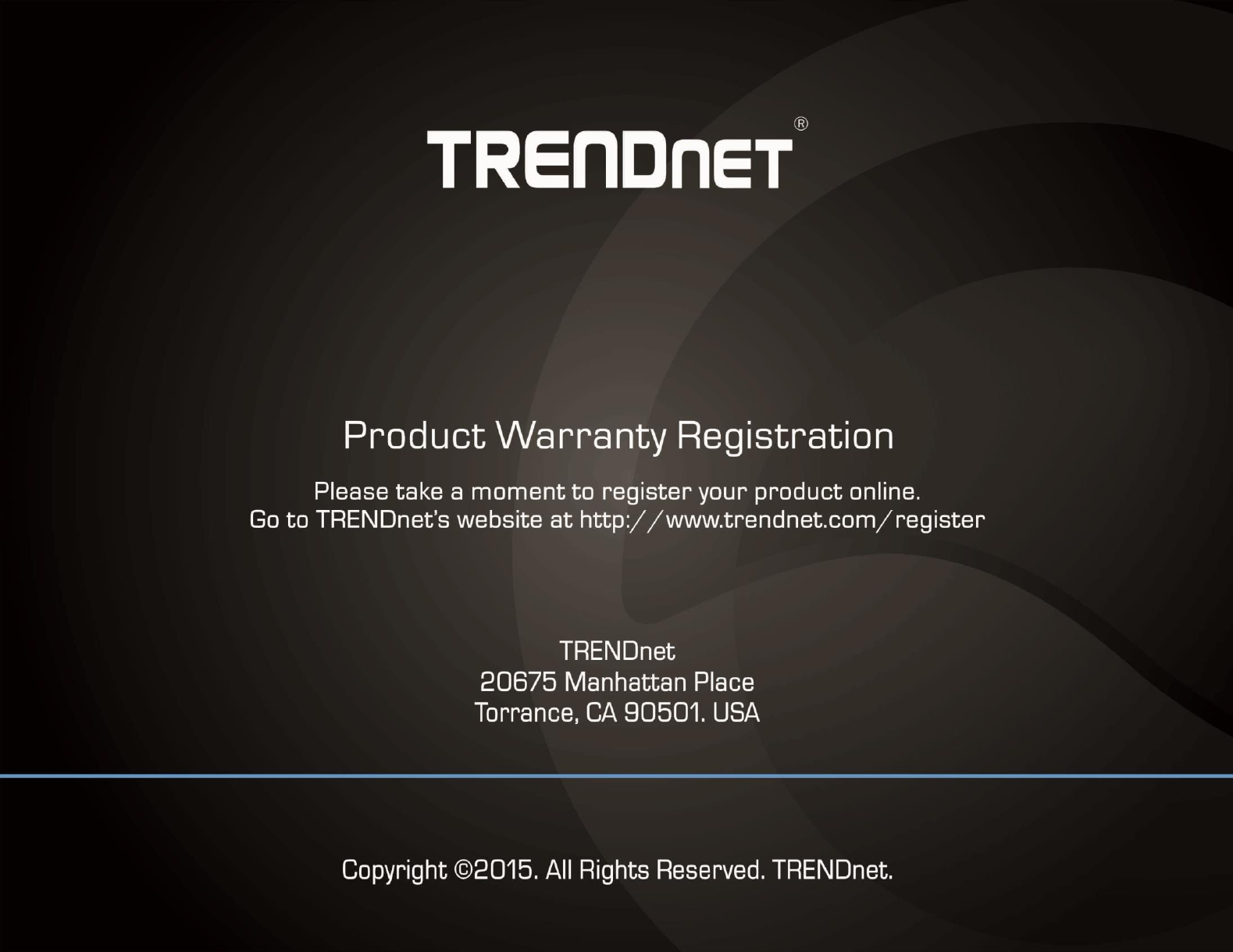TRENDNET TEW817DTR AC750 Wireless Travel Router User Manual test 3
TRENDNET, Inc. AC750 Wireless Travel Router test 3
TRENDNET >
User manual
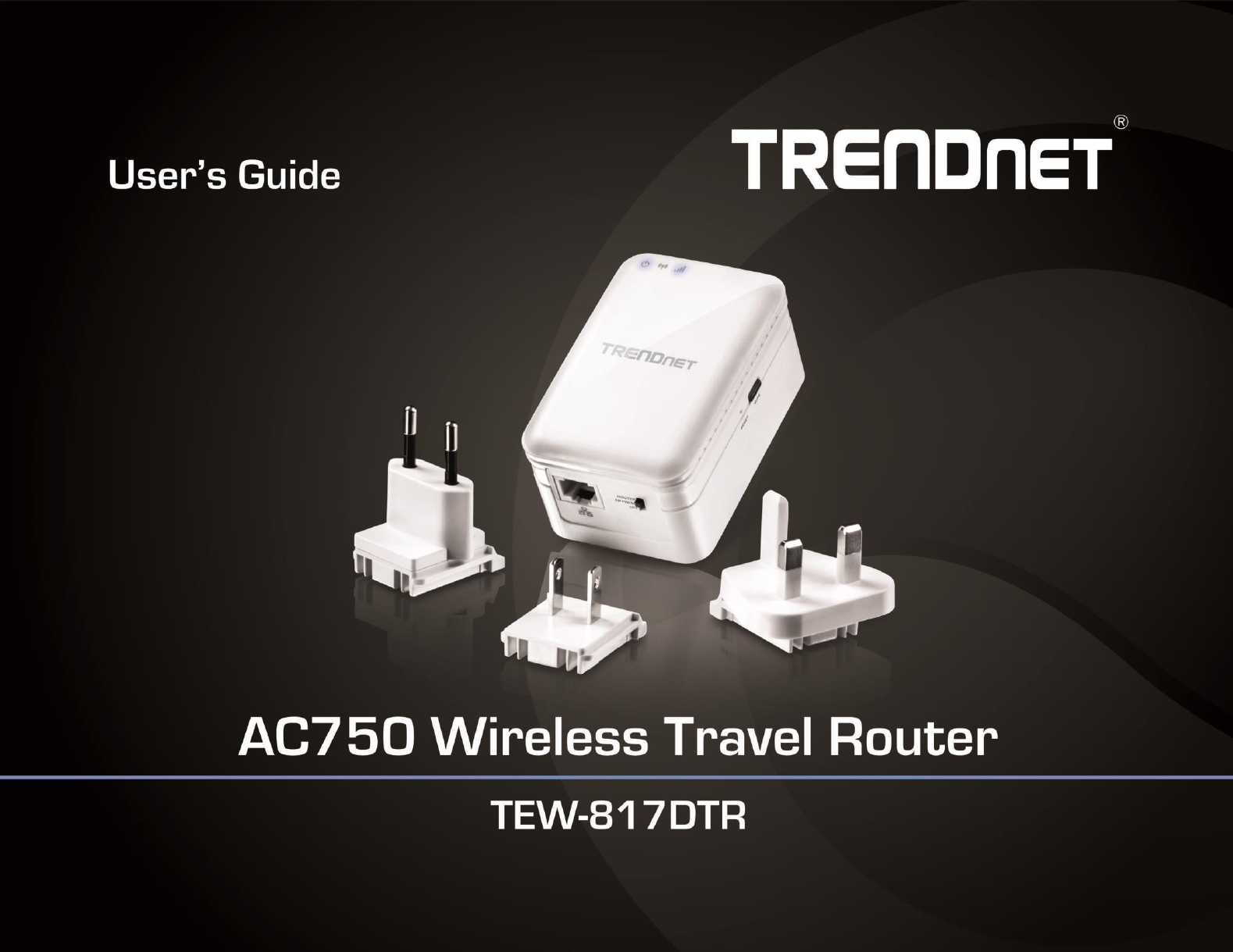
© Copyright 2015 TRENDnet. All Rights Reserved.
TRENDnet User’s Guide
Cover Page

© Copyright 2015 TRENDnet. All Rights Reserved.
TRENDnet User’s Guide
TEW-817DTR
Table of Contents
Product Overview ........................................................................... 3
Package Contents .......................................................................................................... 3
Features ......................................................................................................................... 3
Product Hardware Features........................................................................................... 4
Application Diagram ...................................................................................................... 5
Creating a Network ........................................................................................................ 6
Hardware Installation .................................................................................................... 7
Basic Settings .................................................................................. 7
Access your management page ..................................................................................... 7
Network Status .............................................................................................................. 8
How to choose the type of security for your wireless network .................................... 9
Steps to improve wireless connectivity ....................................................................... 10
Router Mode Setup ....................................................................... 10
Before you Install in router mode ...................................................................... 10
Router Mode Installation ............................................................................................. 11
Wireless Settings ......................................................................................................... 14
Wireless Networking and Security ................................................. 15
Secure your wireless network ..................................................................................... 15
Connect wireless devices to your router ..................................................................... 17
Connect wireless devices using WPS ........................................................................... 17
Guest Network ............................................................................................................. 19
Parental Control ........................................................................................................... 20
Access Rule (MAC/IP Filter) ............................................................................... 20
Website Filter..................................................................................................... 21
MAC Filter (Wireless) ................................................................................................... 21
Advanced wireless settings .......................................................................................... 22
Multiple SSID...................................................................................................... 22
Advanced Settings ............................................................................................. 23
Advanced Settings ........................................................................ 24
Manually configure your Internet connection ............................................................ 24
IPv6 Settings ................................................................................................................ 24
Clone a MAC address ................................................................................................... 25
Change your router IP address .................................................................................... 26
Set up the DHCP server on your router ....................................................................... 26
Set up DHCP reservation ............................................................................................. 27
Enable/disable UPnP on your router ........................................................................... 28
Enable/disable Application Layer Gateways (ALG) ...................................................... 28
Allow/deny multicast streaming.................................................................................. 29
Identify your network on the Internet ........................................................................ 29
Set your router date and time ..................................................................................... 29
Create schedules ......................................................................................................... 30
Access Control (IP Protocol Filter) ............................................................................... 31
Inbound Filter .............................................................................................................. 32
Open a device on your network to the Internet .......................................................... 33
DMZ ................................................................................................................... 33
Virtual Server ..................................................................................................... 33
Special Applications ........................................................................................... 34
Gaming............................................................................................................... 35
Allow remote access to your router management page ................................... 36
Allow/deny ping requests tofrom the Internet ........................................................... 36
Add static routes ......................................................................................................... 37
Enable Dynamic Routing .............................................................................................. 37
AP/WISP Mode Setup ................................................................... 38
AP/WISP Mode Installation ......................................................................................... 38
Access Point Mode ........................................................................ 40
Wireless Settings ......................................................................................................... 41
Wireless Networking and Security ................................................. 42
Secure your wireless network ..................................................................................... 42

© Copyright 2015 TRENDnet. All Rights Reserved.
TRENDnet User’s Guide
TEW-817DTR
Connect wireless devices using WPS ........................................................................... 44
Change your access point IP address ........................................................................... 45
Configure your Internet connection ............................................................................ 46
IPv6 Connection Settings ............................................................................................. 46
Advanced Settings ....................................................................................................... 47
WISP Mode ................................................................................... 48
Wireless Settings ......................................................................................................... 49
Wireless Networking and Security ................................................. 50
Secure your wireless network ..................................................................................... 50
Connect wireless devices to your router ..................................................................... 52
Connect wireless devices using WPS ........................................................................... 52
Change your access point IP address ........................................................................... 53
Configure your Internet connection ............................................................................ 54
IPv6 Connection Settings ............................................................................................. 54
Advanced Settings ....................................................................................................... 55
Repeater Mode ............................................................................. 56
Wireless Settings ......................................................................................................... 57
Wireless Networking and Security ................................................. 58
Secure your wireless network ..................................................................................... 58
Change your access point IP address ........................................................................... 61
Configure your Internet connection ............................................................................ 61
IPv6 Connection Settings ............................................................................................. 62
Advanced Settings ....................................................................................................... 62
Maintenance & Monitoring ........................................................... 63
Change your router login password ............................................................................ 63
Reset your router to factory defaults .......................................................................... 63
Default Settings ........................................................................................................... 64
Backup and restore configuration settings .................................................................. 64
Reboot ......................................................................................................................... 65
Upgrade firmware ....................................................................................................... 65
Wireless Client List ...................................................................................................... 66
Check system information ........................................................................................... 66
View logs ...................................................................................................................... 68
Technical Specifications ................................................................ 69
Troubleshooting ........................................................................... 71
Appendix ...................................................................................... 72
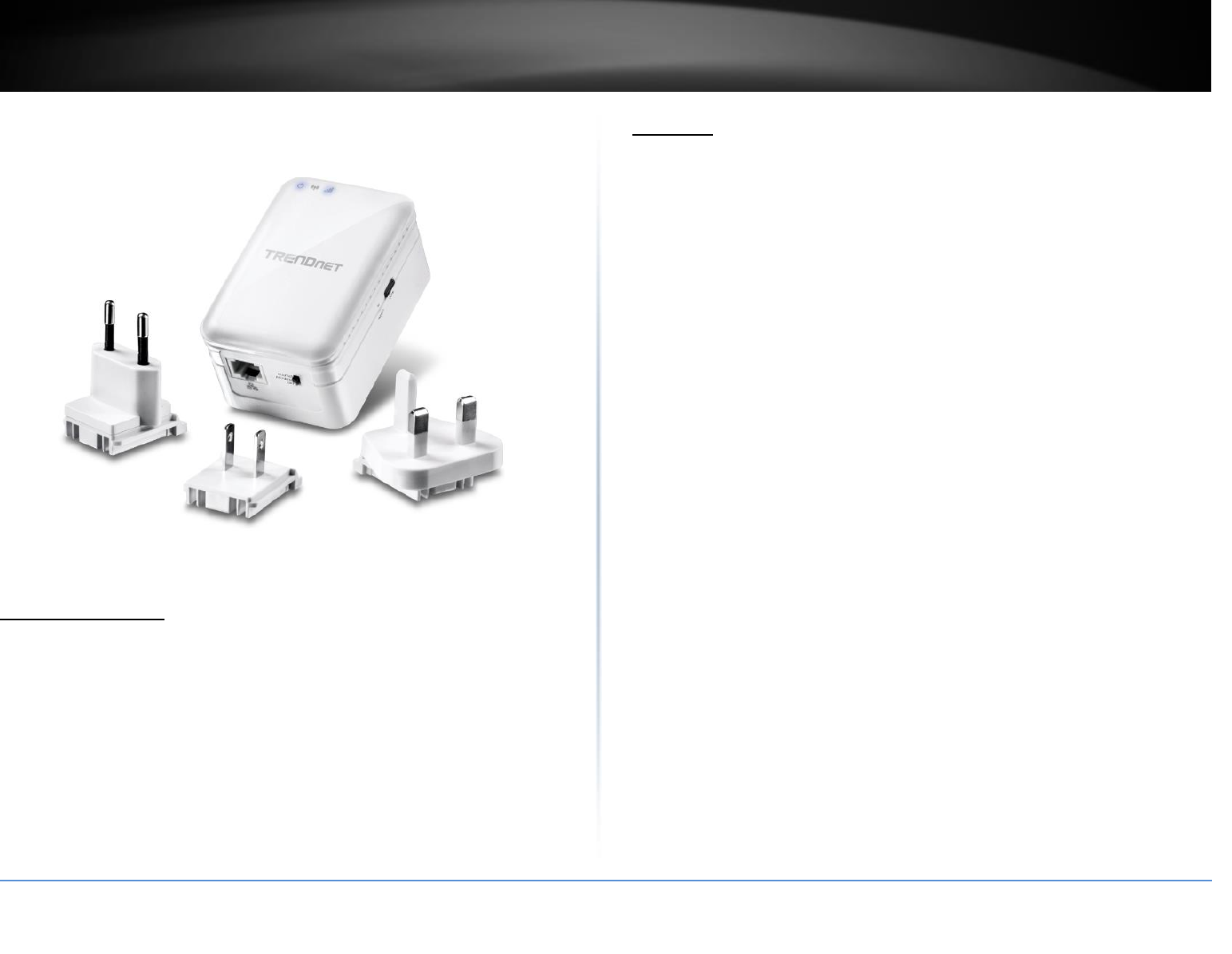
© Copyright 2015 TRENDnet. All Rights Reserved.
TRENDnet User’s Guide
TEW-817DTR
3
Product Overview
TEW-817DTR
Package Contents
In addition to your router, the package includes:
TEW-817DTR
North America, Euro, UK Power Plugs adapter
Multi-Language Quick Installation Guide
CD-ROM (User’s Guide)
Network cable Ethernet Cable (1.5m / 5ft.)
If any package contents are missing or damaged, please contact the retail store, online
retailer, or reseller/distributor from which the product was purchased.
Features
TRENDnet’s AC750 Wireless Travel Router, model TEW-817DTR, is a powerful travel
router for on the go professionals. Concurrent high performance WiFi AC and N bands
network all wireless devices. Router mode turns a wired internet connection into a
wireless network. Wireless ISP (WISP) mode shares a single password protected hotel
WiFi connection with multiple users*. The compact router plugs directly into an outlet
and interchangeable North America, Euro, and UK power prongs work on all continents.
Easy Setup
Get up and running in minutes with the intuitive guided setup
Wireless AC750
Concurrent high speed 433 Mbps WiFi AC + 300 Mbps WiFi N bands
Pre-Encrypted Wireless
For your convenience the wireless network arrives pre-encrypted with its own unique
password
Router Mode
Turns a single wired internet connection into a shared wireless network
WISP Mode
Shares a single password protected hotel WiFi connection with multiple users*
Access Point/Repeater Modes
Access Point and Repeater modes add device versatility
Toggle Switch
A convenient external switch sets the TEW-817DTR to Router mode, to
WISP/AP/Repeater mode, or turns it off
Power Plugs
Stay connected on all continents with interchangeable North America, Euro, and UK
power plugs
Ethernet Port
Router mode: WAN port used to connect to a wired internet connection
WISP/AP/Repeater mode: LAN port used to connect a wired device to the internet
One Touch Connection
Connect at the touch of the Wi-Fi Protected Setup (WPS) button
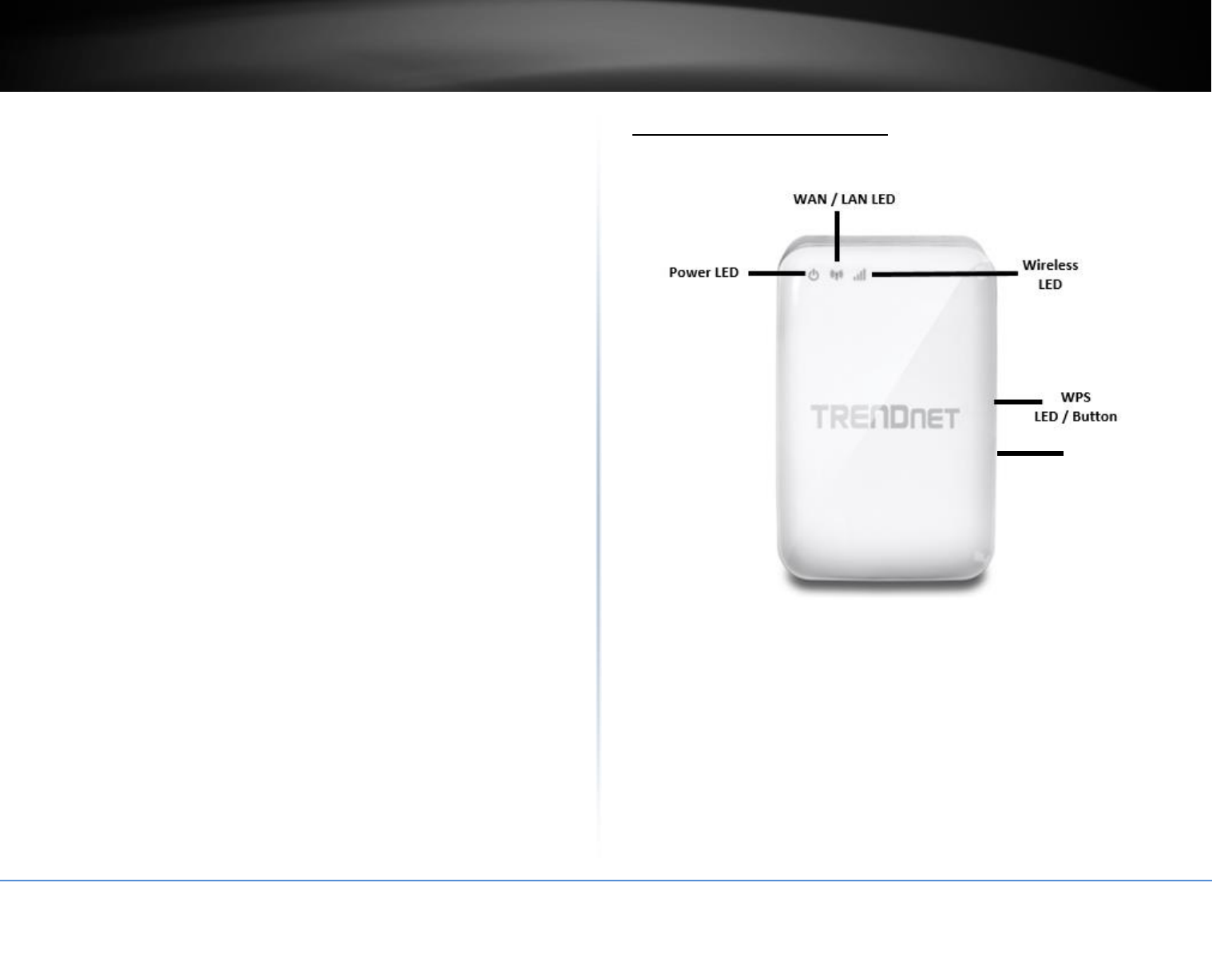
© Copyright 2015 TRENDnet. All Rights Reserved.
TRENDnet User’s Guide
TEW-817DTR
4
Guest Network
Create an isolated network for guest internet access only (router mode only)
VPN Passthrough Support
Secure remote access with IPsec, PPTP, and L2TP VPN passthrough support
IPv6
IPv6 network support
*WISP mode is not compatible with captive portal wireless login pages
**Maximum wireless signal rates are referenced from IEEE 802.11 theoretical
specifications. Actual data throughput and cover-age will vary depending on
interference, network traffic, building materials and other conditions. For maximum
performance of up to 1.3 Gbps use with a 1.3 Gbps 802.11ac wireless adapter.
Product Hardware Features
Front View
Power LED: LED turns blue when the unit is on.
WAN / LAN LED: LED lights blue when the Ethernet port is connected. Blinks during
data transmission.
Wireless LED: Blinks blue during wireless data transmission
WPS LED/Button: Blinks when WPS is activated. Press and hold for 5 seconds to
activate WPS.
Reset button: Press and hold for 10 seconds to reset the device into default
settings.
Reset button
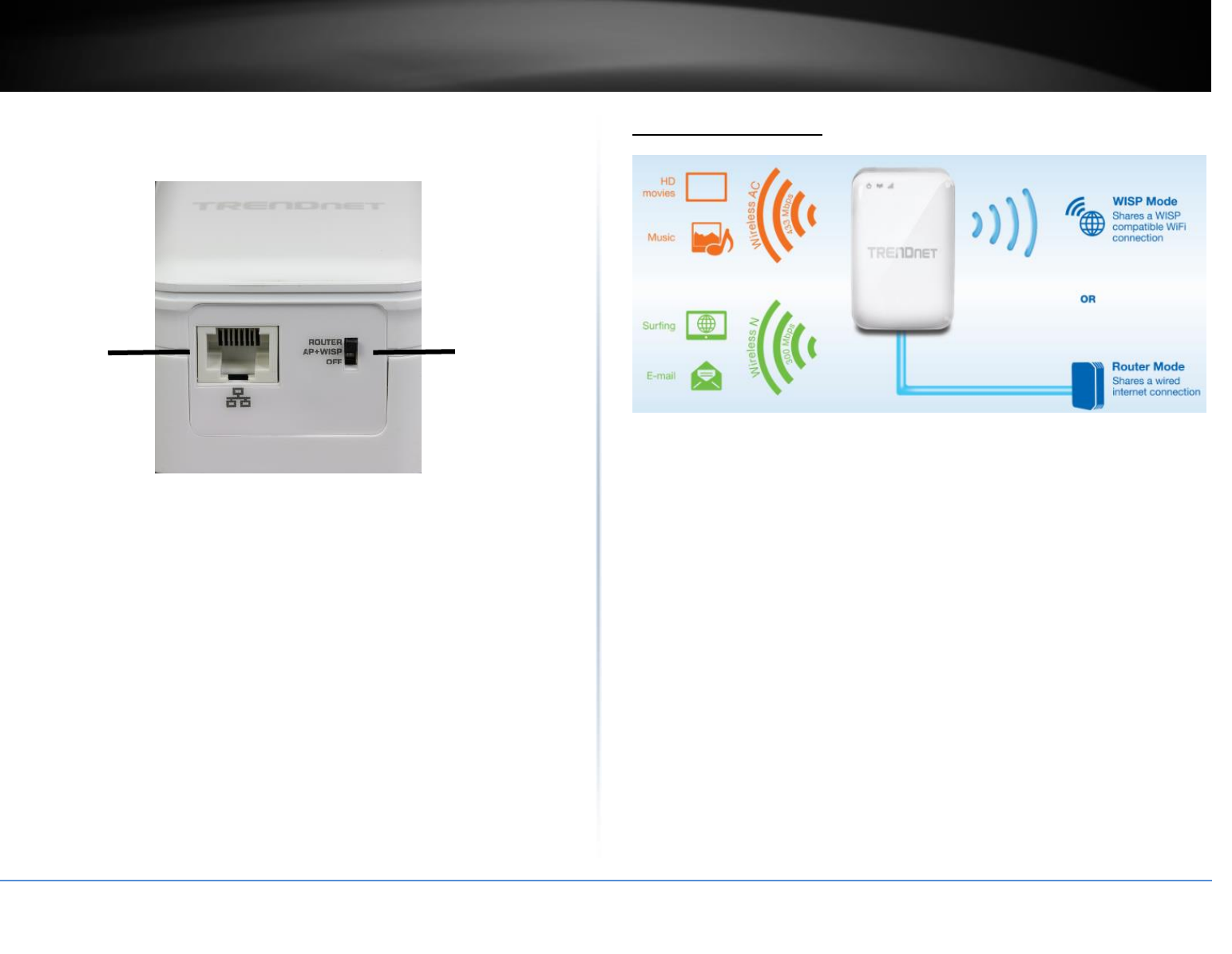
© Copyright 2015 TRENDnet. All Rights Reserved.
TRENDnet User’s Guide
TEW-817DTR
5
Bottom View
Ethernet Port: Connect Ethernet cables (also called network cables) from your
router LAN ports to your wired network devices. When Router mode is selected the
port becomes WAN port that allows you to connect to the Internet. When AP+WISP
mode is selected the port becomes a LAN port that allows you to connect wired
clients of to connect to an existing network.
Mode Switch: Router mode allows you to connect the device to an existing
network. AP + WISP mode sets the device into Access Point mode where you can
configure the device into an access point, WISP client or Repeater. Select Off to turn
off the device.
Application Diagram
The router is installed near the hotel’s internet connection port which connects to the Internet.
2.4GHz wireless signals from the router are broadcasted to wireless clients such as laptops (with
wireless capability) and the less congested 5GHz wireless signals from the router are broadcasted
to other wireless client devices such as TVs, game consoles, or media bridges thereby providing
Internet access for all wireless client devices.
Off / Mode
Switch
Ethernet
Port

© Copyright 2015 TRENDnet. All Rights Reserved.
TRENDnet User’s Guide
TEW-817DTR
6
Creating a Network
What is a network?
A network is a group of computers or devices that can communicate with each other. A
home network of more than one computer or device also typically includes Internet
access, which requires a router.
A typical home network may include multiple computers, a media player/server, a
printer, a modem, and a router. A large home network may also have a switch,
additional routers, access points, and many Internet-capable media devices such as TVs,
game consoles, and Internet cameras.
Modem: Connects a computer or router to the Internet or ISP (Internet Service
Provider).
Router: Connects multiple devices to the Internet.
Switch: Connect several wired network devices to your home network. Your
router has a built-in network switch (the LAN port 1-4). If you have more wired
network devices than available Ethernet ports on your router, you will need an
additional switch to add more wired connections.
How to set up a home network
1. For a network that includes Internet access, you’ll need:
Computers/devices with an Ethernet port (also called network port) or wireless
networking capabilities.
A modem and Internet service to your home, provided by your ISP (modem
typically supplied by your ISP).
A router to connect multiple devices to the Internet.
2. Make sure that your modem is working properly. Your modem is often provided by
your Internet Service Provider (ISP) when you sign up for Internet service. If your
modem is not working contact your ISP to verify functionality.
3. To set up wireless security on your router, see “Wireless Networking and Security” on
page 8.
How to setup your device in router mode
Refer to the Quick Installation Guide or continue to the next section “Router Mode” on
page 11 for more detailed installation instructions.
How to setup your device in AP/WISP mode
Refer to the Quick Installation Guide or continue to the next section “AP/WISP Mode”
on page 40 for more detailed installation instructions.
Where to find more help
In addition to this User’s Guide, you can find help below:
http://www.trendnet.com/support (documents, downloads, and FAQs are
available from this Web page)
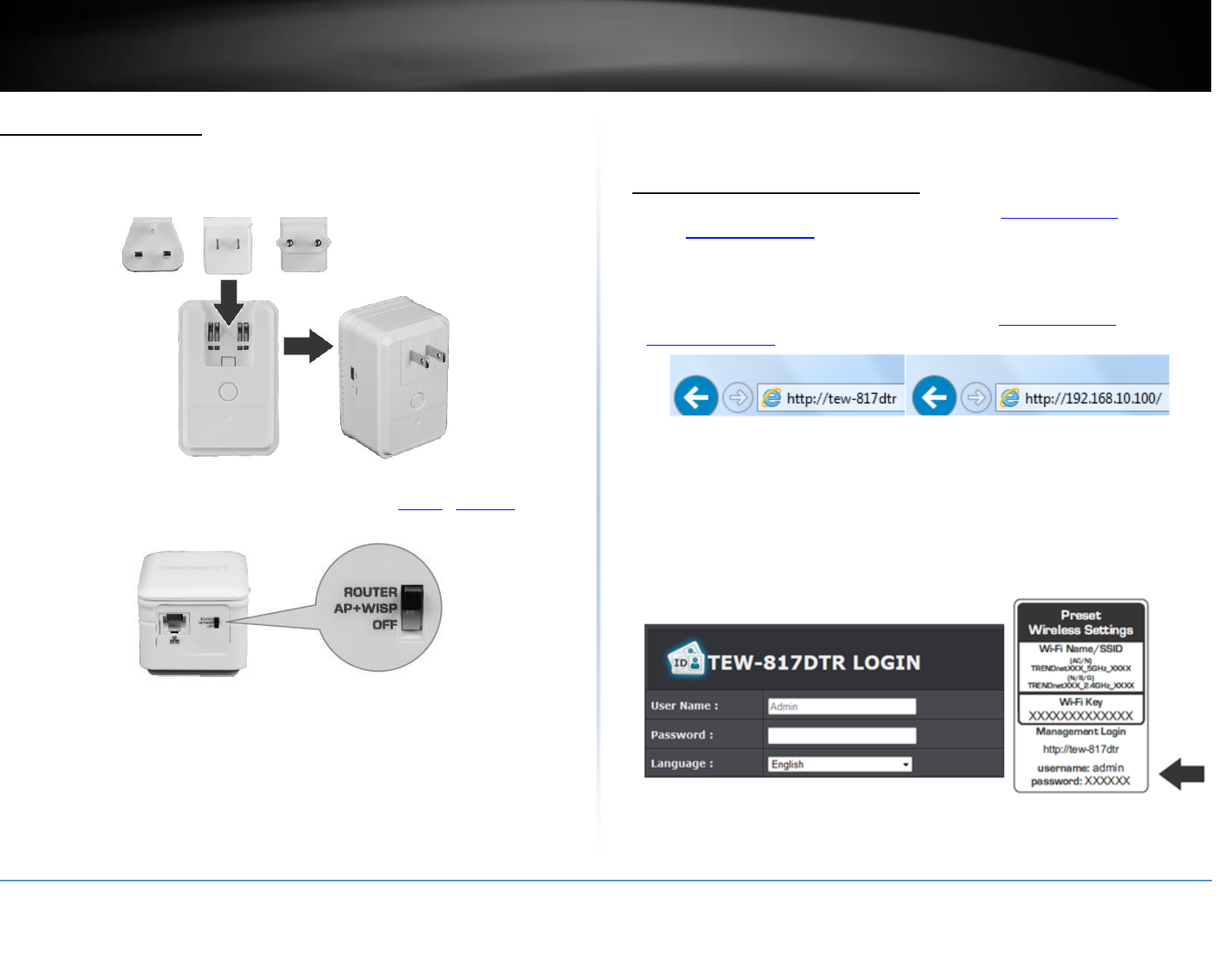
© Copyright 2015 TRENDnet. All Rights Reserved.
TRENDnet User’s Guide
TEW-817DTR
7
Hardware Installation
1. Verify that you have an Internet connection when connecting your computer directly
to your Internet connection port.
2. Attached the appropriate power adapter for your region.
3. Make sure the switch on the unit is set to the appropriate (Router / AP+WISP) mode.
Please refer to the specific mode section for proper installation.
4. Plug the TEW-817DTR into a power outlet.
8. Verify that the LED indicators on the front of the unit are illuminated: Power, and
Internet.
Basic Settings
Access your management page
Note: Your router management page URL/domain name http://tew-817dtr or IP
address http://192.168.10.1 is accessed through the use of your Internet web browser
(e.g. Internet Explorer®, Firefox®, Chrome™, Safari®, Opera™) and will be referenced
frequently in this User’s Guide.
1. Open your web browser and go to URL/domain name http://tew-817dtr or IP address
http://192.168.10.1. Your router will prompt you for a user name and password.
2. For added security, the router is preconfigured with a unique password. You can find
the Password on a sticker on the side of the router and on the label on the bottom of
the router. Enter your Username and Password, select your preferred language, and
then click Login.
User Name: admin
Password: (xxxxxxxx)
Note: User Name and Password are case sensitive.
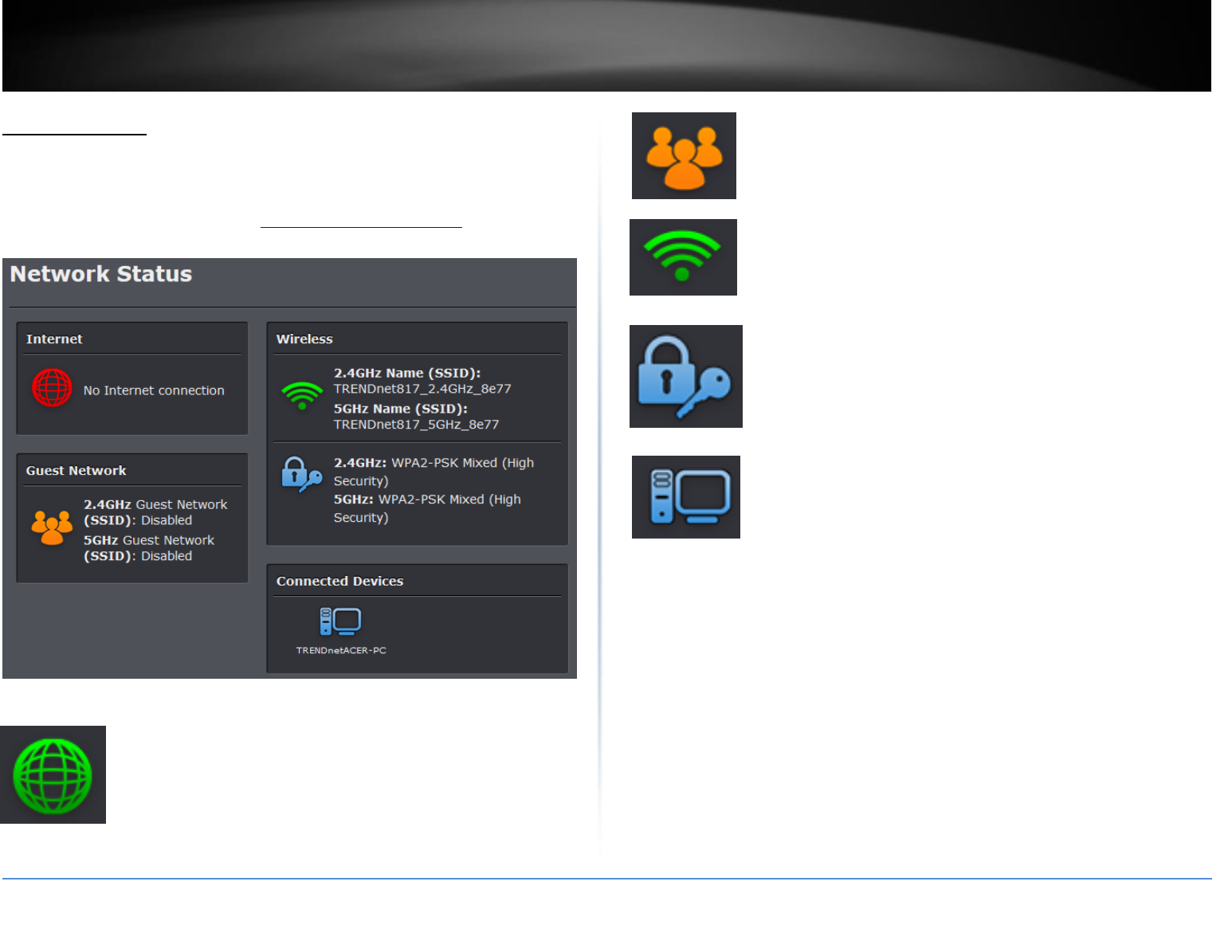
© Copyright 2015 TRENDnet. All Rights Reserved.
TRENDnet User’s Guide
TEW-817DTR
8
Network Status
Basic > Network Status
This section displays a brief summary of the router’s basic settings and the connected
devices.
1. Log into the management page (see “Access your management page” on page 7).
2. Click on Basic and click on Network Status.
Internet: The Internet icon displays green to indicate that your router
has successfully established an Internet connection. The Internet icon
displays orange to indicate that a physical connection has been
established on the Internet port of the router but with no successful
Internet connection has been established. The Internet icon displays
red to indicate that the Internet is physically disconnected.
Guest Network (Available in Router mode): The Guest Network icon
displays orange to indicate that there are no wireless guest networks
currently enabled. The Guest Network icon will display green to
indicate that you have at least one wireless guest network currently
enabled.
Wireless: The wireless icon displays green to indicate that wireless is
enabled on both 2.4GHz and 5GHz bands. The wireless icon displays
orange to indicate that only wireless band is enabled (2.4GHz or
5GHz). The wireless icon will display red to indicate that wireless is
disabled on both 2.4GHz and 5GHz bands.
Wireless Security: The wireless security section will display the
current security settings configured for your wireless networks. It is
strongly recommended to enable security on your wireless networks.
Connected Devices: The connected devices section displays the list of
network devices currently connected to your router.
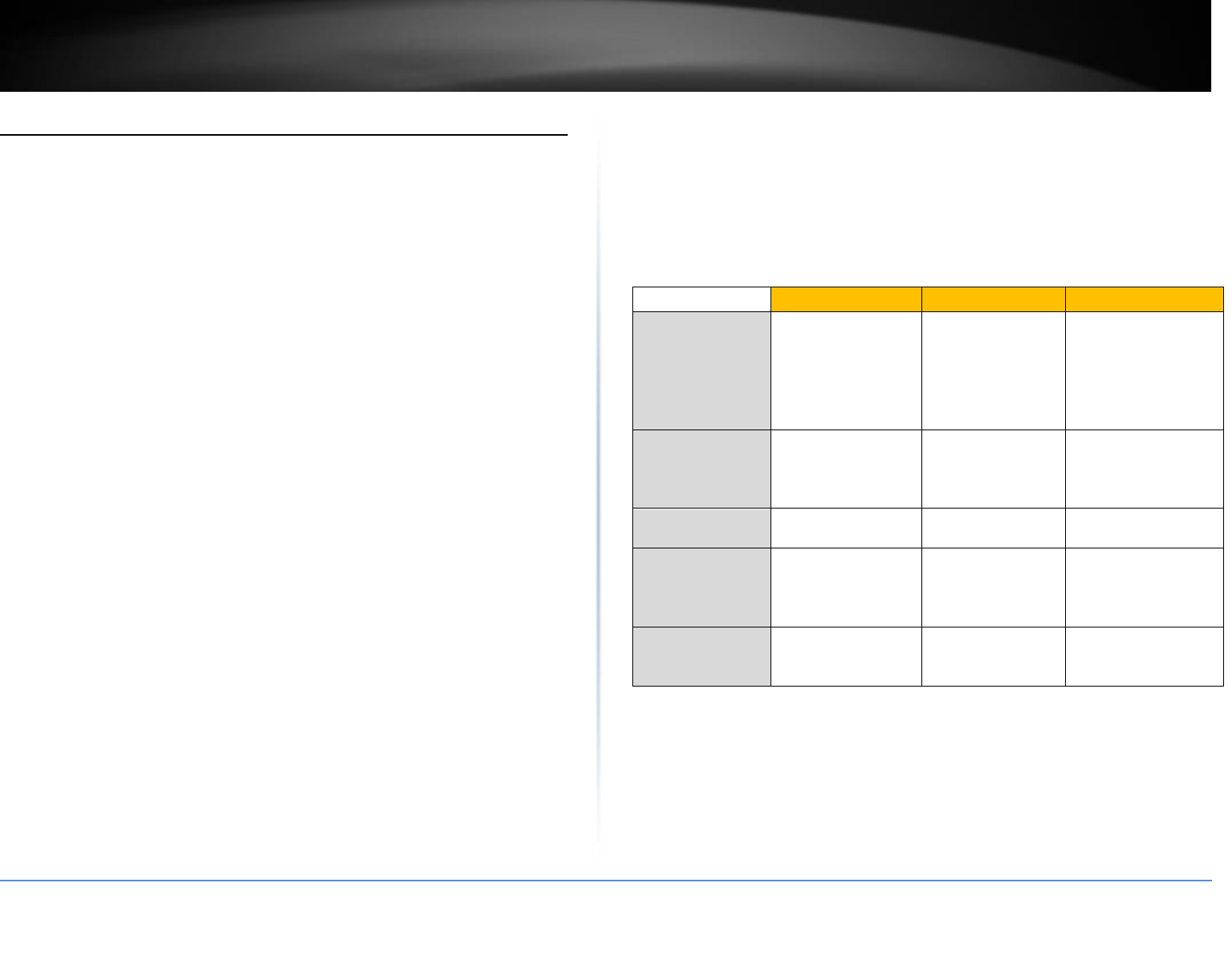
© Copyright 2015 TRENDnet. All Rights Reserved.
TRENDnet User’s Guide
TEW-817DTR
9
How to choose the type of security for your wireless network
Setting up wireless security is very important. Leaving your wireless network open and
unsecure could expose your entire network and personal files to outsiders. TRENDnet
recommends reading through this entire section and setting up wireless security on your
new router.
There are a few different wireless security types supported in wireless networking each
having its own characteristics which may be more suitable for your wireless network
taking into consideration compatibility, performance, as well as the security strength
along with using older wireless networking hardware (also called legacy hardware).
It is strongly recommended to enable wireless security to prevent unwanted users from
accessing your network and network resources (personal documents, media, etc.).
In general, it is recommended that you choose the security type with the highest
strength and performance supported by the wireless computers and devices in your
network. Please review the security types to determine which one you should use for
your network.
Wireless Encryption Types
WEP: Legacy encryption method supported by older 802.11b/g hardware. This is
the oldest and least secure type of wireless encryption. It is generally not
recommended to use this encryption standard, however if you have old 802.11 b or
802.11g wireless adapters or computers with old embedded wireless cards(wireless
clients), you may have to set your router to WEP to allow the old adapters to
connect to the router.
Note: This encryption standard will limit connection speeds to 54Mbps.
WPA: This encryption is significantly more robust than the WEP technology. Much
of the older 802.11g hardware was been upgraded (with firmware/driver upgrades)
to support this encryption standard. Total wireless speeds under this encryption
type however are limited to 54Mbps.
WPA-Auto: This setting provides the router with the ability to detect wireless
devices using either WPA or WPA2 encryption. Your wireless network will
automatically change the encryption setting based on the first wireless device
connected. For example, if the first wireless client that connects to your wireless
network uses WPA encryption your wireless network will use WPA encryption. Only
when all wireless clients disconnect to the network and a wireless client with WPA2
encryption connects your wireless network will then change to WPA2 encryption.
Note: WPA2 encryption supports 802.11n speeds and WPA encryption will limit
your connection speeds to 54Mbps
WPA2: This is the most secure wireless encryption available today, similar to WPA
encryption but more robust. This encryption standard also supports the highest
connection speeds. TRENDnet recommends setting your router to this encryption
standard. If you find that one of your wireless network devices does not support
WPA2 encryption, then set your router to either WPA or WPA-Auto encryption.
Note: Check the specifications of your wireless network adapters and wireless
appliances to verify the highest level of encryption supported.Below is brief
comparison chart of the wireless security types and the recommended
configuration depending on which type you choose for your wireless network.
Security Standard
WEP
WPA
WPA2
Compatible
Wireless
Standards
IEEE 802.11a/b/g
(802.11n devices
will operate at
802.11g to connect
using this standard)
IEEE 802.11a/b/g
(802.11n devices
will operate at
802.11g to connect
using this
standard)
IEEE
802.11a/b/g/n/ac
Highest
Performance
Under This
Setting
Up to 54Mbps
Up to 54Mbps
Up to 450Mbps (11n)
or 1.3 Gbps (11ac)
Encryption
Strength
Low
Medium
High
Additional
Options
Open System or
Shared Key,
HEX or ASCII,
Different key sizes
TKIP or AES,
Preshared Key or
RADIUS
TKIP or AES,
Preshared Key or
RADIUS
Recommended
Configuration
Open System ASCII
13 characters
TKIP
Preshared Key
8-63 characters
AES
Preshared Key
8-63 characters
*Dependent on the maximum 802.11n data rate supported by the device (150Mbps,
300Mbps, 450Mbps) or maximum 802.11ac data rate supported by the device
(433Mbps, 867Mbps, 1.3Gbps)

© Copyright 2015 TRENDnet. All Rights Reserved.
TRENDnet User’s Guide
TEW-817DTR
10
Steps to improve wireless connectivity
There are a number of factors that can impact the range of wireless devices. Follow
these tips to help improve your wireless connectivity:
1. Keep the number of obstructions to a minimum. Each obstruction can reduce the
range of a wireless device. Position the wireless devices in a manner that will
minimize the amount of obstructions between them.
a. For the widest coverage area, install your router near the center of your
home, and near the ceiling, if possible.
b. Avoid placing the router on or near metal objects (such as file cabinets and
metal furniture), reflective surfaces (such as glass or mirrors), and masonry
walls.
c. Any obstruction can weaken the wireless signal (even non-metallic objects),
so the fewer obstructions between the router and the wireless device, the
better.
d. Place the router in a location away from other electronics, motors, and
fluorescent lighting.
e. Many environmental variables can affect the router’s performance, so if your
wireless signal is weak, place the router in several locations and test the
signal strength to determine the ideal position.
2. Building materials can have a large impact on your wireless signal. In an indoor
environment, try to position the wireless devices so that the signal passes through
less dense material such as dry wall. Dense materials like metal, solid wood, glass
or even furniture may block or degrade the signal.
3. Antenna orientation can also have a large impact on your wireless signal. Use the
wireless adapter’s site survey tool to determine the best antenna orientation for
your wireless devices.
4. Interference from devices that produce RF (radio frequency) noise can also impact
your signal. Position your wireless devices away from anything that generates RF
noise, such as microwaves, radios and baby monitors.
If possible, upgrade wireless network interfaces (such as wireless cards in computers)
from older wireless standards to 802.11n or 802.11ac. If a wirelessly networked device
uses an older standard, the performance of the entire wireless network may be slower.
If you are still experiencing low or no signal consider repositioning the wireless devices,
installing additional access points or wireless extenders.
Router Mode Setup
Before you Install in router mode
Many Internet Service Providers (ISPs) allow your router to connect to the Internet
without verifying the information fields listed below. Skip this section for now and if
your router cannot connect to the Internet using the standard installation process, come
back to this page and contact your ISP to verify required ISP specification fields listed
below.
1. Obtain IP Address Automatically (Dynamic IP/DHCP)
Host Name:_______________ (Optional, if required by ISP for Compatibilty)
Primary DNS Server Address: _____. _____._____._____ (Optional)
Secondary DNS Servers Address : _____. _____._____._____ (Optional)
MTU:_______ (Default: 1500, change if required by ISP)
MAC Address: ___:___:___:___:___:___ Clone your PC MAC Address (Optional)
2. Static IP/Fixed IP address
IP Address: _____. _____._____._____ (e.g. 215.24.24.129)
Subnet Mask: _____. _____._____._____
Default Gateway IP Address: _____. _____._____._____
Primary DNS Server Address: _____. _____._____._____
Secondary DNS Servers Address : _____. _____._____._____ (Optional)
MTU:_______ (Default: 1500, change if required by ISP)
MAC Address: ___:___:___:___:___:___ Clone your PC MAC Address (Optional)
3. PPPoE Dynamic IP (DHCP) / PPPoE Static IP – Standard & Russian
Type (Dynamic IP/DHCP or Static IP)
IP Address (Static IP): _____. _____._____._____ (e.g. 215.24.24.129)
Username: _________
Password: ________________
Service Name: _________________ (Optional)
DNS Servers Address 1 (Static IP): _____. _____._____._____
DNS Servers Address 2 (Static IP): _____. _____._____._____ (Optional)
Reconnect Mode: Always / On Demand / Manual (Optional)
MTU:_______ (Default: 1500, change if required by ISP)
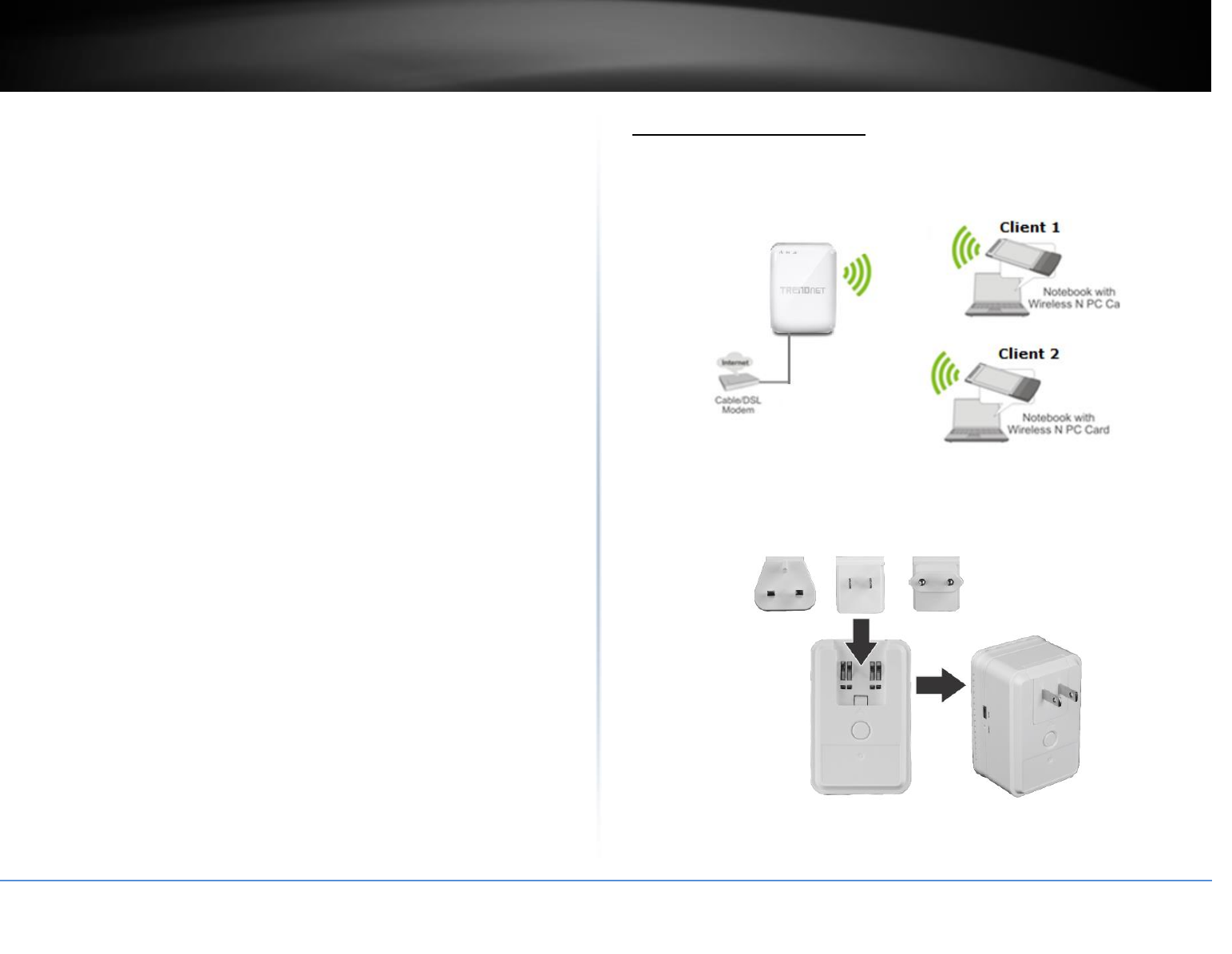
© Copyright 2015 TRENDnet. All Rights Reserved.
TRENDnet User’s Guide
TEW-817DTR
11
MAC Address: ___:___:___:___:___:___ Clone your PC MAC Address (Optional)
4. PPTP - Standard & Russian
Type (Dynamic IP/DHCP or Static IP)
PPTP IP Address: _____. _____._____._____ (e.g. 215.24.24.129)
PPTP Subnet Mask: _____. _____._____._____ (e.g. 255.255.255.0)
PPTP Gateway:_____. _____._____._____ (e.g. 215.24.24.1)
PPTP Server: _____________________ (e.g. 215.24.24.150)
Username: _________
Password: ________________
Reconnect Mode: Always / On Demand / Manual (Optional)
DNS Servers Address 1 (Static IP): _____. _____._____._____
DNS Servers Address 2 (Static IP): _____. _____._____._____ (Optional)
MTU:_______ (Default: 1500, change if required by ISP)
MAC Address: ___:___:___:___:___:___ Clone your PC MAC Address (Optional)
MPPE (Microsoft® Point-to-Point Encryption) w/ MS-CHAPv2 Enabled:____(Yes or No)
5. L2TP - Standard & Russian
Type (Dynamic IP/DHCP or Static IP)
L2TP IP Address: _____. _____._____._____ (e.g. 215.24.24.129)
L2TP Subnet Mask: _____. _____._____._____ (e.g. 255.255.255.0)
L2TP Gateway:_____. _____._____._____ (e.g. 215.24.24.1)
L2TP Server: _____________________ (e.g. 215.24.24.150)
Username: _________
Password: ________________
Reconnect Mode: Always / On Demand / Manual (Optional)
DNS Servers Address 1 (Static IP): _____. _____._____._____
DNS Servers Address 2 (Static IP): _____. _____._____._____ (Optional)
MTU:_______ (Default: 1500, change if required by ISP)
MAC Address: ___:___:___:___:___:___ Clone your PC MAC Address (Optional)
MPPE (Microsoft® Point-to-Point Encryption) w/ MS-CHAPv2 Enabled:____(Yes or No)
Router Mode Installation
In router mode, the TEW-817DTR serves as your typical network router. In this mode the
TEW-817DTR offers advance configurations from setting specific WAN types to opening
certain ports for your applications.
1. Verify that you have an Internet connection when connecting your computer directly
to your Internet connection port.
2. Attached the appropriate power adapter for your region.
3. Make sure the switch on the unit is set to Router mode.
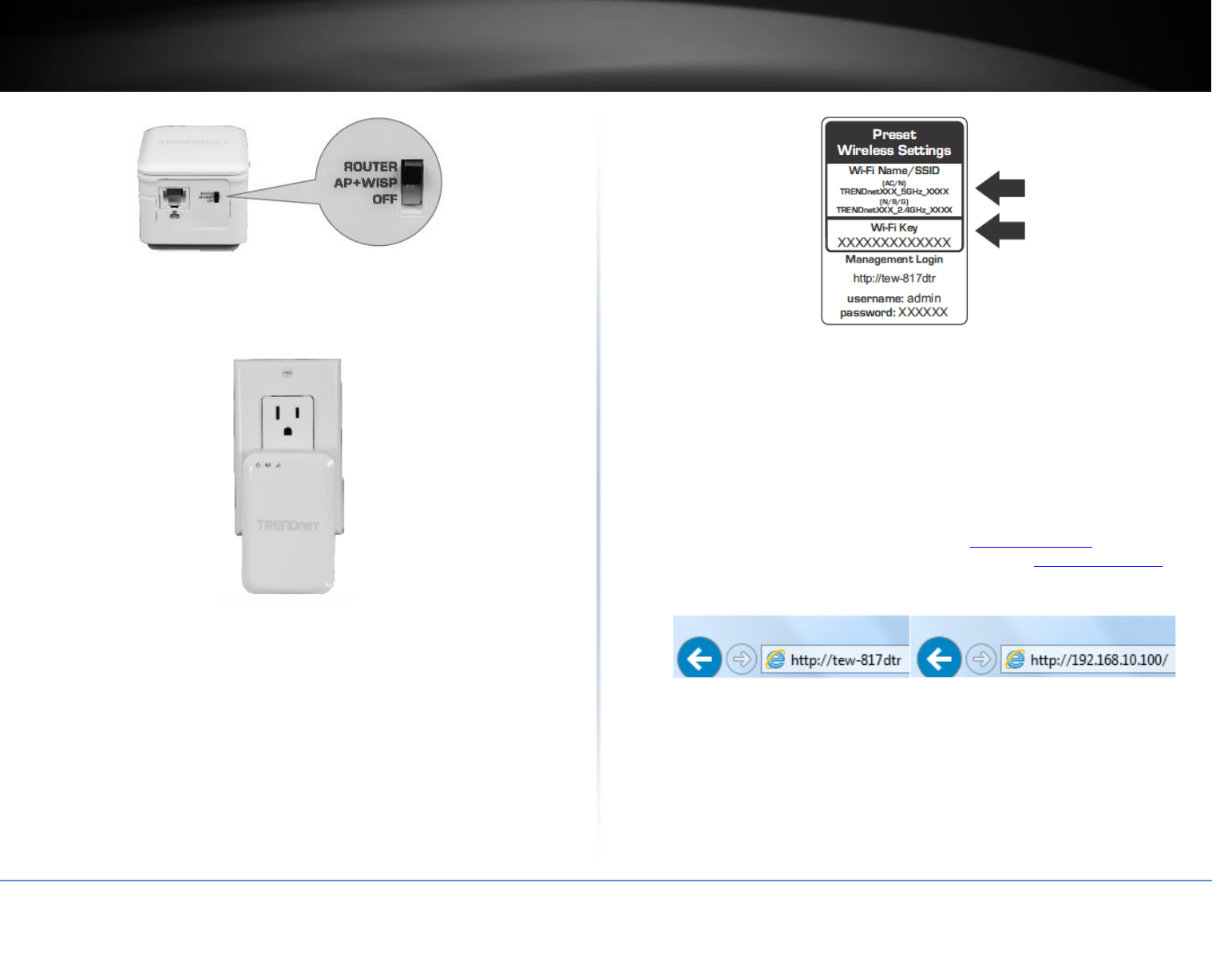
© Copyright 2015 TRENDnet. All Rights Reserved.
TRENDnet User’s Guide
TEW-817DTR
12
4. Plug the TEW-817DTR into a power outlet.
5. Connect the TEW-817DTR to an available Internet connection port provided by your
hotel.
5. Connect your wireless computer to the TEW-817DTR’s wireless network.
6. When prompted, enter the WiFi password from the sticker on the device.
6. Open your internet browser and verify you can access the Internet. Congratulations,
you are now connected to the Internet using the TEW-817DTR.
Setup Wizard
1. Open your web browser (e.g. Internet Explorer, Firefox, Safari, Chrome, or Opera) and
the wizard will automatically appear.
Note: If you have already configured your router before, the wizard will no longer
appear automatically. In your web browser, go to http://tew-817dtr/ or you can
access the router management using the default IP address http://192.168.10.1. Your
router will prompt you for a user name and password. Enter your user name and
password and click Advanced > Setup > Wizard.
2. Select your Language and click Next..
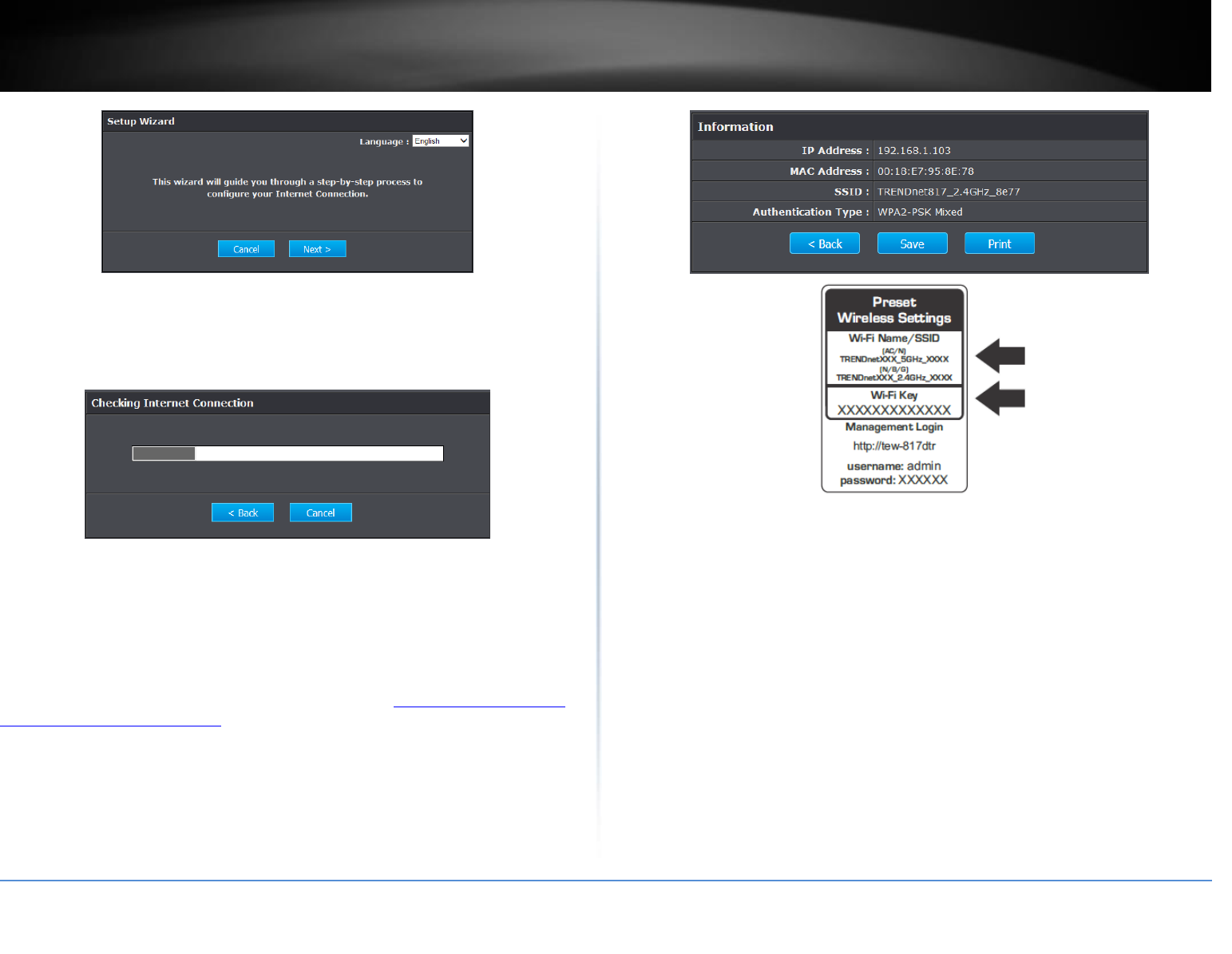
© Copyright 2015 TRENDnet. All Rights Reserved.
TRENDnet User’s Guide
TEW-817DTR
13
3. If the wizard is unable to detect your Internet connection type, you will be prompted
to select it. Select your Internet connection type and click Next.
Note: Dynamic IP (DHCP) is typical for most Internet services. You can verify your
settings with your Internet Service Provider.
4. Confirm your settings. This window displays your predefined router wireless settings
and click Exit to complete the wizard.
Note: For added security, the router wireless network is pre-encrypted with its own
unique wireless network security key. You can find the unique network security key and
the pre-assigned network name (SSID) on a sticker on the side of the router and on a
label on the bottom of the router. You will need this information to connect to the
router. To change the network security key, refer to page 9 “How to choose the type of
security for your wireless network”. If the router is reset to factory defaults, the wireless
encryption will reset to the network security key printed on the product labels of the
router.
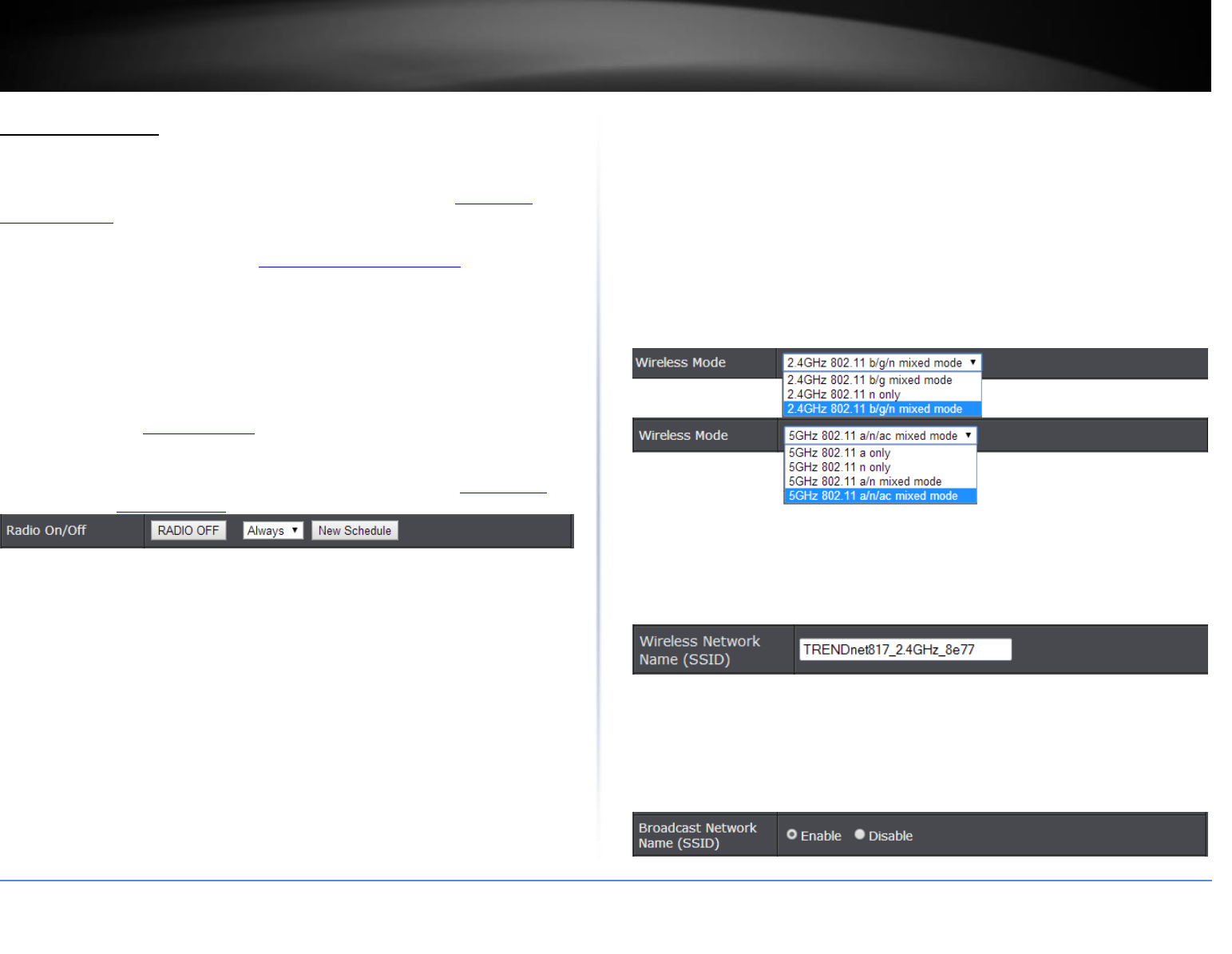
© Copyright 2015 TRENDnet. All Rights Reserved.
TRENDnet User’s Guide
TEW-817DTR
14
Wireless Settings
Basic > Wireless (2.4GHz or 5GHz)
This section outlines available management options under basic wireless sub tab for
both 2.4GHz and 5GHz wireless sections. You can refer to the page 15 Secure your
Wireless network to configure your wireless security settings.
1. Log into the management page (see “Access your management page” on page 7).
2. Click on Wireless and click on Basic scroll down to Wireless Network Settings (2.4GHz
or 5GHz)
3. To save changes to this section, click Apply when finished.
Radio On/Off:– Click the radio on/off button to enable/disable the wireless radio.
Note: It is recommended to keep wireless radios enabled.
New Schedule: The schedule function allows you to define a schedule when the
wireless should be turned on. To define a new schedule, click New Schedule and
refer to page 31 “Create Schedules”. After you have created a new schedule, click
the drop-down list and the new schedule will be available for selection.
Note: Before applying scheduling, please ensure your Time settings are configured
correct and you have defined a schedule. See page 30 to configure Time Settings and
see page 31 “Create Schedules” to create a schedule.
Wireless Mode: When applying the Wireless Mode setting, please keep in mind the
following:
Wireless devices that support 802.11n are backwards compatible and can connect
wirelessly at 802.11g or 802.11b.
Wireless devices that support 802.11ac are backwards compatible and can connect
wirelessly at 802.11n or 802.11a.
Connecting at 802.11b or 802.11g will limit the capability of your 802.11n
supported wireless devices from obtaining higher performance and data rates.
Connecting at 802.11a or 802.11n will limit the capability of your 802.11ac
supported wireless devices from obtaining higher performance and data rates.
Allowing 802.11b or 802.11g devices to connect to an 802.11n capable wireless
network may degrade the wireless network performance below the higher
performance and data rates of 802.11n.
Allowing 802.11a or 802.11n devices to connect to an 802.11ac capable wireless
network may degrade the wireless network performance below the higher
performance and data rates of 802.11ac.
Wireless devices that only support 802.11n or 802.11a will not be able to connect
to a wireless network that is set to 802.11ac only mode.
Wireless devices that only support 802.11b or 802.11g will not be able to connect
to a wireless network that is set to 802.11n only mode.
Wireless devices that only support 802.11b will not be able to connect to a wireless
network that is set to 802.11g only mode.
Wireless devices that only support 802.11a will not be able to connect to a wireless
network that is set to 802.11n only mode.
Wireless Network Name (SSID): Enter the wireless name (SSID) for your wireless
network. This acronym stands for Service Set Identifier and is the name of your
wireless network. It differentiates your wireless network from others around you.
By default, the router’s wireless name is unique to the device. If you choose to
change the SSID, change it to a name that you can easily remember.
Broadcast Network Name (SSID)
o Visible: Allows wireless devices to search and discover your wireless network
name (also called SSID) broadcasted by your router.
o Invisible: Turns off the ability for wireless devices to find your network. It is still
possible for wireless devices to be configured to connect to your wireless
network. Disabling this setting will disable WPS functionality.
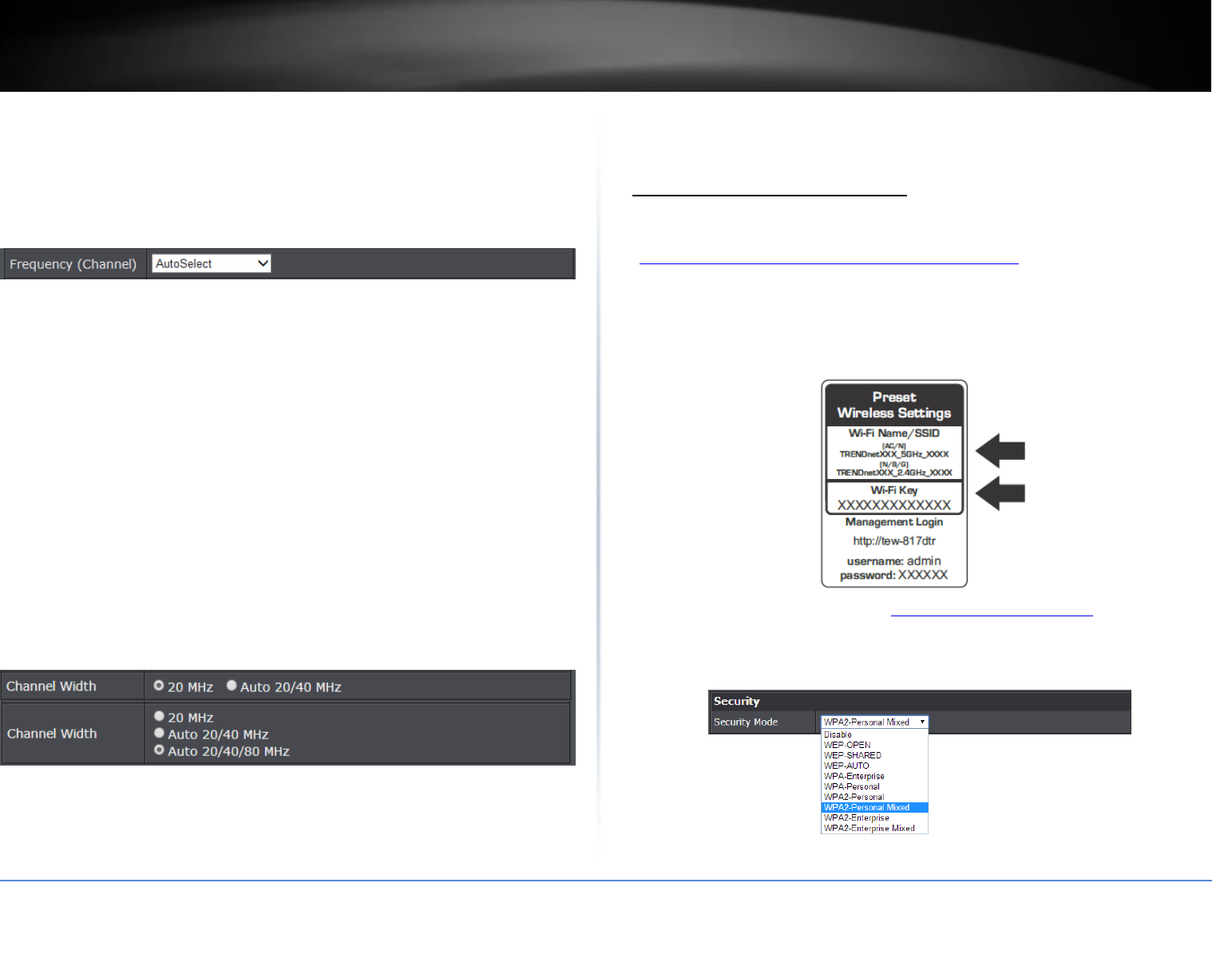
© Copyright 2015 TRENDnet. All Rights Reserved.
TRENDnet User’s Guide
TEW-817DTR
15
Enable Auto Channel Scan – Check this option to set your router to scan for which
wireless channels to use automatically.
Frequency (Channel) – Selecting the Auto option will set your router to scan for the
appropriate wireless channel to use automatically. Click the drop-down list and
select the desired Channel for wireless communication. The goal is to select the
Channel that is least used by neighboring wireless networks.
Channel Width: Select the appropriate channel width for your wireless network.
This setting only applies to 802.11n and 802.11ac. For greater 802.11n
performance, select Auto 20/40MHz (Options: 20MHz or Auto 20/40MHz). It is
recommended to use the default channel bandwidth settings.
For greater 802.11ac performance, select Auto 20/40/80MHz (Options: 20MHz,
Auto 20/40MHz, Auto 20/40/80MHz). It is recommended to use the default channel
width settings.
Note: Please note that the default settings may provide more stability than the
higher channel bandwidth settings such as Auto 20/40/80MHz for connectivity in
busy wireless environments where there are several wireless networks in the area.
o 20 MHz: This mode operates using a single 20MHz channel for wireless devices
connecting at 802.11n on both 2.4GHz and 5GHz. This setting may provide more
stability than 20/40MHz (Auto) for connectivity in busy wireless environments
where there are several neighboring wireless networks in the area.
o Auto 20/40MHz (11n) or Auto 20/40/80MHz (11ac): When this setting is active,
this mode is capable of providing higher performance only if the wireless devices
support the channel width settings. Enabling Auto 20/40MHz or Auto 20/40/80
MHz typically results in substantial performance increases when connecting an
802.11ac/n wireless client.
Wireless Networking and Security
Secure your wireless network
Basic > Wireless
After you have determined which security type to use for your wireless network (see
“How to choose the security type for your wireless network” on page 9), you can set up
wireless security.
Note: By default, your router is configured with a predefined wireless network name
(SSID) and security key using WPA2-Personal. The predefined wireless network name and
security can be found on the sticker on the side of the router or on the device label at the
bottom of the router.
1. Log into the management page (see “Access your management page” on page 7).
2. Click on Basic, and click on Wireless.
3. Under Security, click on the Security Mode drop-down list to select your wireless
security type.
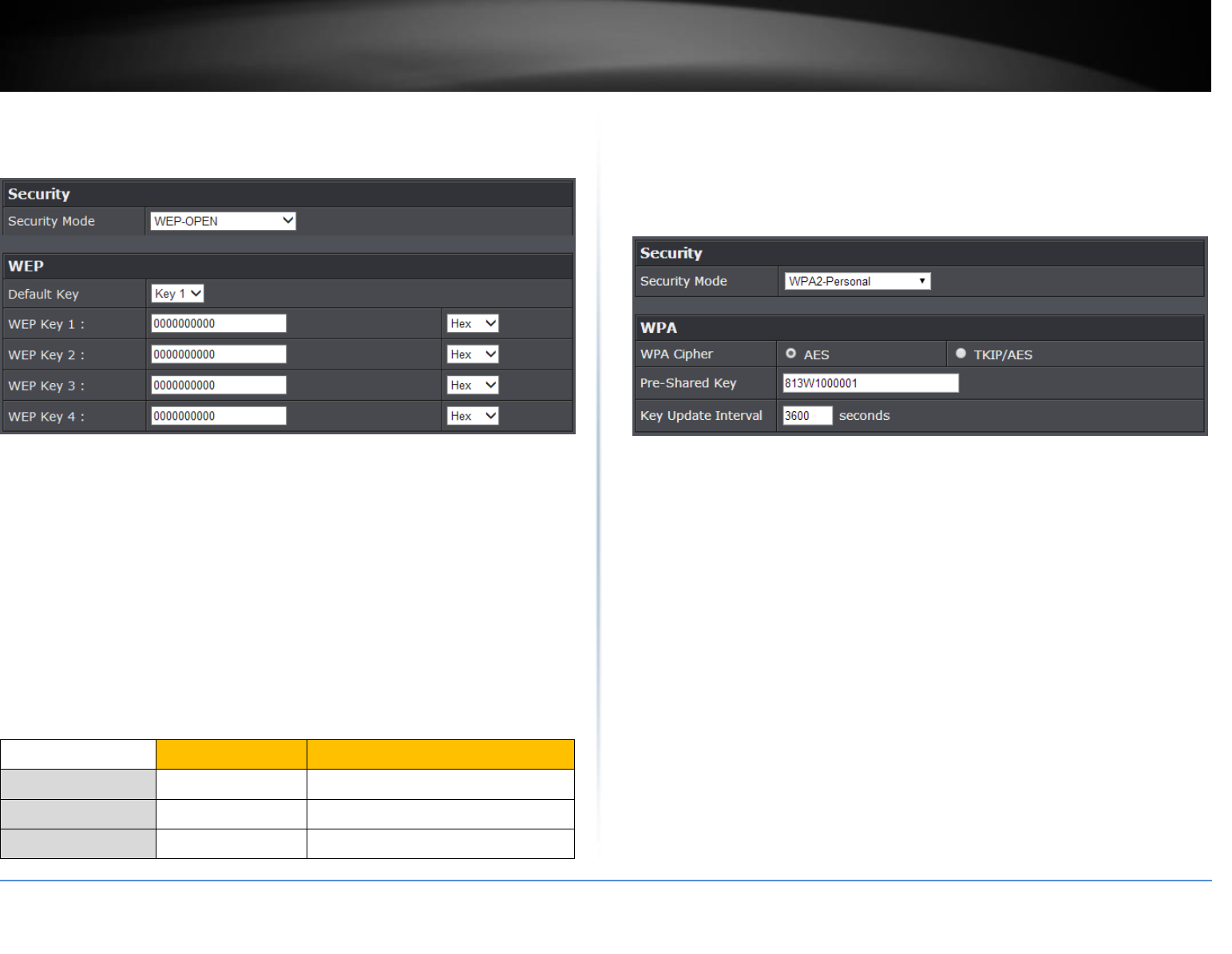
© Copyright 2015 TRENDnet. All Rights Reserved.
TRENDnet User’s Guide
TEW-817DTR
16
Selecting WEP:
If selecting WEP (Wired Equivalent Privacy), please review the WEP settings to configure
and click Apply to save the changes.
Security Mode: Choose WEP-OPEN, WEP-SHARED, or WEP-AUTO.
Note: It is recommended to use Open since it is known to be more secure than
Shared Key.
Default Key: Choose the key index to use for security to the corresponding WEP
Keys 1-4. You can only use one key at any given time.
Note: Please note that they wireless client key index 1-4 should also match the key
index chosen here in order to establish connection.
WEP Key 1-4: Enter the WEP key. This is the password or key that is used to
connect your computer to this router wirelessly. You can enter 64-bit or 128-bit
key. You can enter up to four keys but only the one chosen as the Default Key will
be used.
Note: It is recommended to use 128-bit because it is more secure to use a key that
consists of more characters.
Hex/ASCII: Enter the WEP key format. See the table below for the acceptable
characters and lengths for each format.
Selecting WPA-Personal / WPA2-Personal / WPA2-Personal Mixed
(WPA2-Personal recommended):
In the Security Mode drop-down list, select WPA-Personal, WPA2-Personal, or WPA2-
Personal Mixed. Please review the WPA-Personal settings to configure and click Apply
to save the changes.
The following section outlines options when selecting WPA-Personal, WPA2-Personal,
or WPA2-Personal Mixed (Preshared Key),
WPA Cipher: Select a Cipher Type to use.
o When selecting WPA2-Personal Mixed security, it is recommended to use
TKIP/AES.
o When selecting WPA2-Personal security, it is recommended to use AES.
WPA Pre-Shared Key: Enter the passphrase.
o This is the password or key that is used to connect your computer to this router
wirelessly
Key Format: 8-63 alphanumeric characters (a,b,C,?,*, /,1,2, etc.)
Key Update Interval: Enter the time interval (seconds) of when the network
passphrase will rotate.
Note: It is recommended to use the default interval time. Your passphrase will not
change, rotation of the key is part of the WPA protocol and designed to increase
security.
Selecting WPA-Enterprise / WPA2-Enterprise / WPA2-Enterprise Mixed
(WPA2-Personal recommended):
WEP Key Format
HEX
ASCII
Character set
0-9 & A-F, a-f only
Alphanumeric (a,b,C,?,*, /,1,2, etc.)
64-bit key length
10 characters
5 characters
128-bit key length
26 characters
13 characters
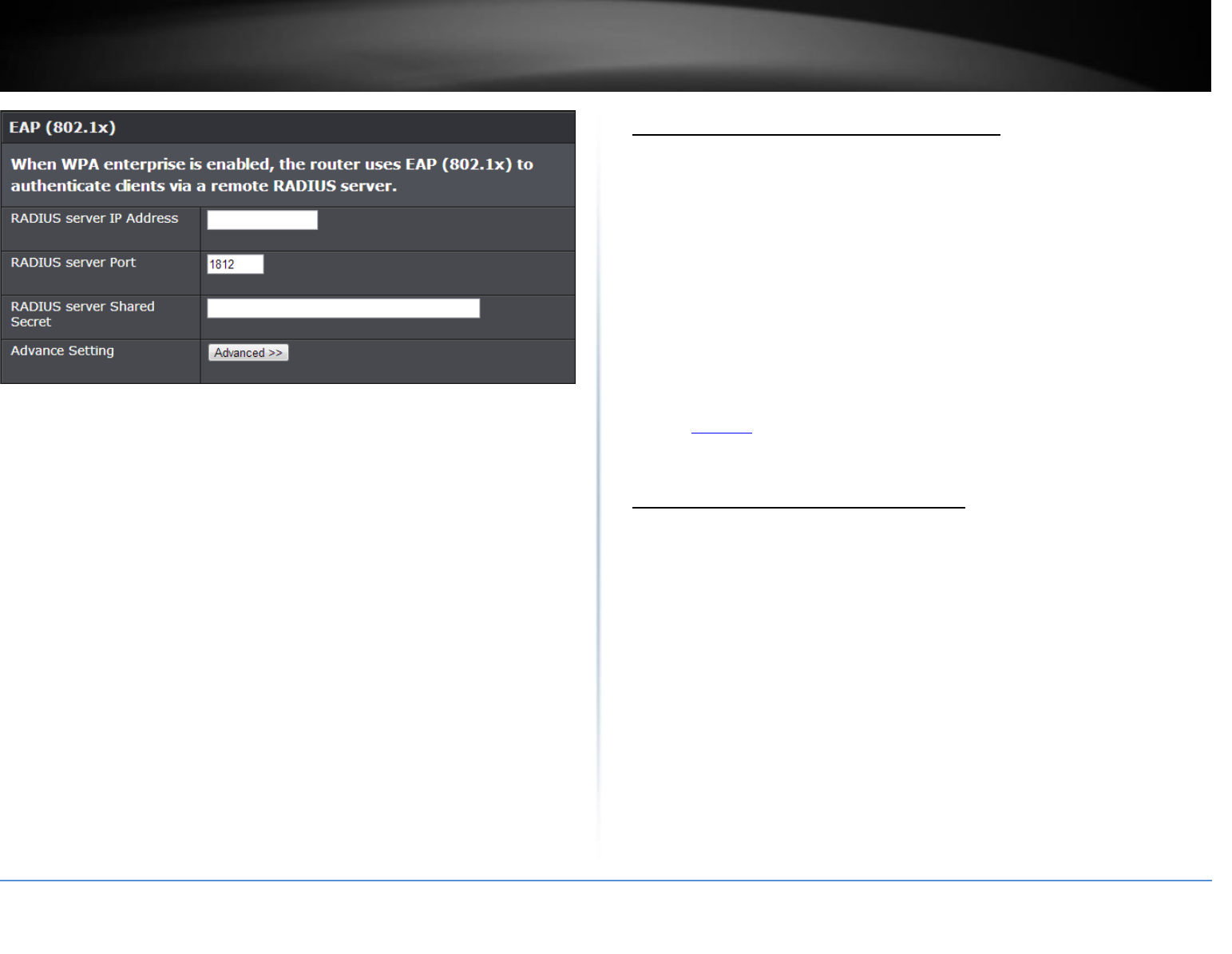
© Copyright 2015 TRENDnet. All Rights Reserved.
TRENDnet User’s Guide
TEW-817DTR
17
The following section outlines options when selecting WPA-Enterprise, WPA2-
Enterprise, or WPA2-Enterprise Mixed (EAP or RADIUS). This security type is also known
as EAP (Extensible Authentication Protocol) or Remote Authentication Dial-In User
Service or RADIUS.
Note: This security type requires an external RADIUS server, Pre-Shared Key only requires
you to create a passphrase.
WPA Cipher: Select a Cipher Type to use.
o When selecting WPA2-Personal Mixed security, it is recommended to use
TKIP/AES.
o When selecting WPA2-Personal security, it is recommended to use AES.
Key Update Interval: Enter the time interval (seconds) of when the network
passphrase will rotate.
Note: It is recommended to use the default interval time. Your passphrase will not
change, rotation of the key is part of the WPA protocol and designed to increase
security.
RADIUS Server Address: Enter the IP address of the RADIUS server. (e.g.
192.168.10.250)
RADIUS Port: Enter the port your RADIUS server is configured to use for RADIUS
authentication.
Note: It is recommended to use port 1812 which is typical default RADIUS port.
RADIUS Server Shared Secret: Enter the shared secret used to authorize your
router with your RADIUS server.
Connect wireless devices to your router
A variety of wireless network devices can connect to your wireless network such as:
Gaming Consoles
Internet enabled TVs
Network media players
Smart Phones
Wireless Laptop computers
Wireless IP cameras
Each device may have its own software utility for searching and connecting to available
wireless networks, therefore, you must refer to the User’s Manual/Guide of your
wireless client device to determine how to search and connect to this router’s wireless
network.
You can view the currently connected wireless client devices under Advanced > Wireless
(2.4GHz or 5GHz) > Station List in the router management page.
See the “Appendix” on page 77 for general information on connecting to a wireless
network.
Connect wireless devices using WPS
WPS (Wi-Fi Protected Setup) is a feature that makes it easy to connect devices to your
wireless network. If your wireless devices support WPS, you can use this feature to
easily add wireless devices to your network.
Note: You will not be able to use WPS if you set the SSID Broadcast setting to Disabled or
if you are using WEP security.
There are two methods the WPS feature can easily connect your wireless devices to
your network.
Push Button Configuration (PBC) method
o (RECOMMENDED) Hardware Push Button method–with an external button
located physically on your router and on your client device
o WPS Software/Virtual Push Button - located in router management page
PIN (Personal Identification Number) Method - located in router management page
Note: Refer to your wireless device documentation for details on the operation of
WPS.
Recommended Hardware Push Button (PBC) Method
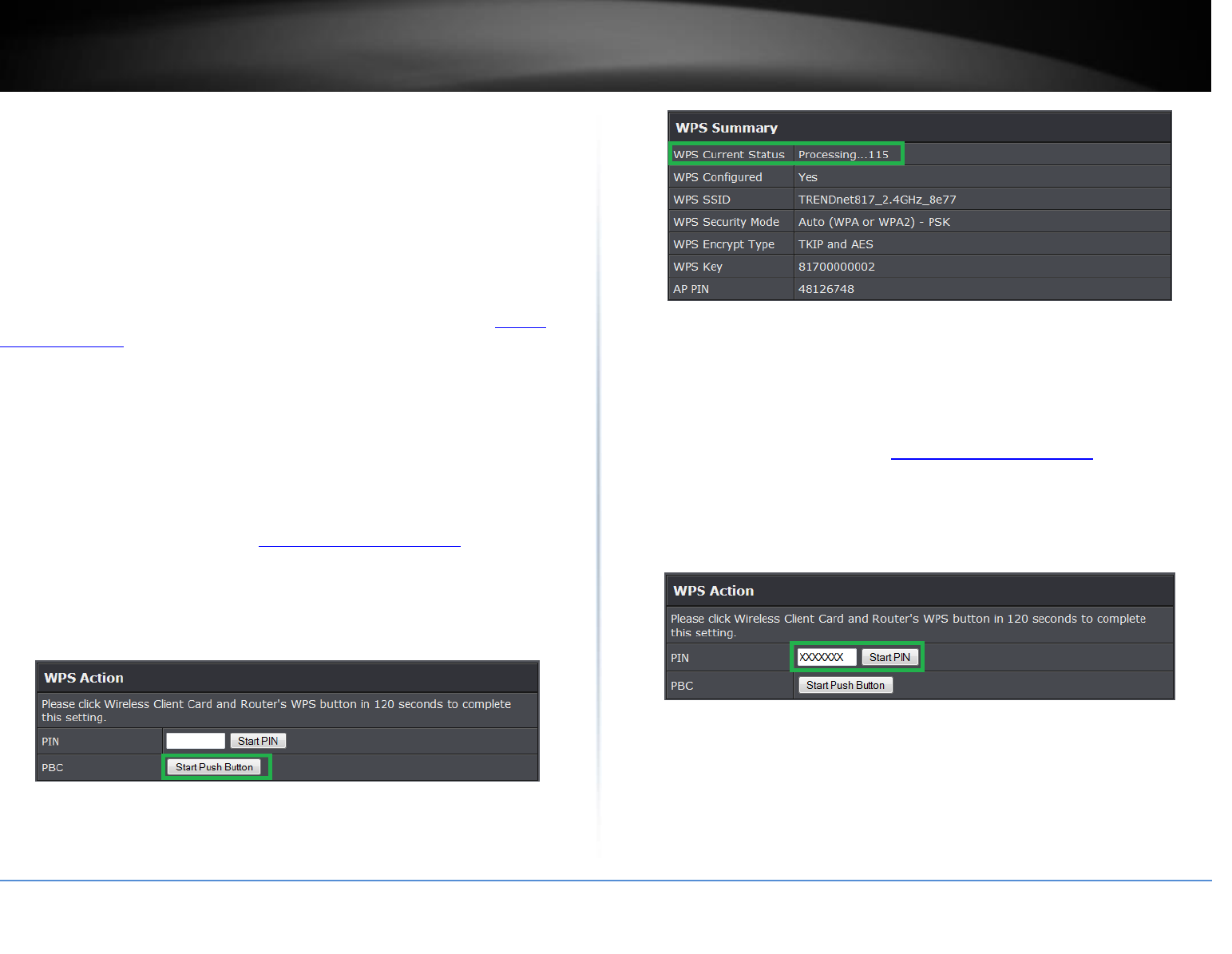
© Copyright 2015 TRENDnet. All Rights Reserved.
TRENDnet User’s Guide
TEW-817DTR
18
Note: It is recommended that a wireless key (passphrase or password) is created
before connecting clients using the PBC method. By default your router is
preconfigured with a wireless encryption key. If no wireless key is defined when
connecting via PBC, the router will automatically create an encryption key that is 64
characters long. This 64 character key will then have to be used if one has to
connect computers to the router using the traditional connection method.
To add a wireless device to your network, simply push the WPS button on the wireless
device you are connecting (consult client device User’s Guide for length of time), then
push and hold the WPS button located on your router for 3 seconds and release it. The
WPS LED will blink to indicate WPS has been activated on your router. (See “Product
Hardware Features” on page 4)
For connecting additional WPS supported devices, repeat this process for each
additional device.
PBC (Software/Virtual Push Button)
Advanced > Wireless (2.4GHz or 5GHz) > WPS
In addition to the hardware push button located physically on your router, the router
management page also has push button which is a software or virtual push button you
can click to activate WPS on your router.
1. Log into the management page (see “Access your management page” on page 7).
2. Click on Advanced, then click on Wireless (2.4GHz or 5GHz), and click on WPS.
3. To add a wireless device to your network, next to Virtual Push Button, click the Start
Push Button button in the router management page. Then push the WPS button on the
wireless device (consult wireless device’s User’s Guide for length of time) you are
connecting.
4. Wait for your router to finsh the WPS process.
Note: You should a message on your WPS client device indicating WPS was successful.
PIN (Personal Identification Number)
Advanced > Wireless (2.4GHz or 5GHz) > WPS
If your wireless device has WPS PIN (typically an 8-digit code printed on the wireless
device product label or located in the wireless device wireless software utility), you can
use this method.
1. Log into the management page (see “Access your management page” on page 7).
2. Click on Wireless, and click on Wi-Fi Protected Setup.
3. To add a wireless device to your network, next to Client, enter the 8-digit numeric PIN
number of the wireless client device and click Start PIN. Note: You may need to initiate
the WPS PIN on your wireless device first when using this method. Refer to your wireless
device documentation for details on the operation of WPS.
4. Wait for your router to finsh the WPS process.
Note: You should a message on your WPS client device indicating WPS was successful.
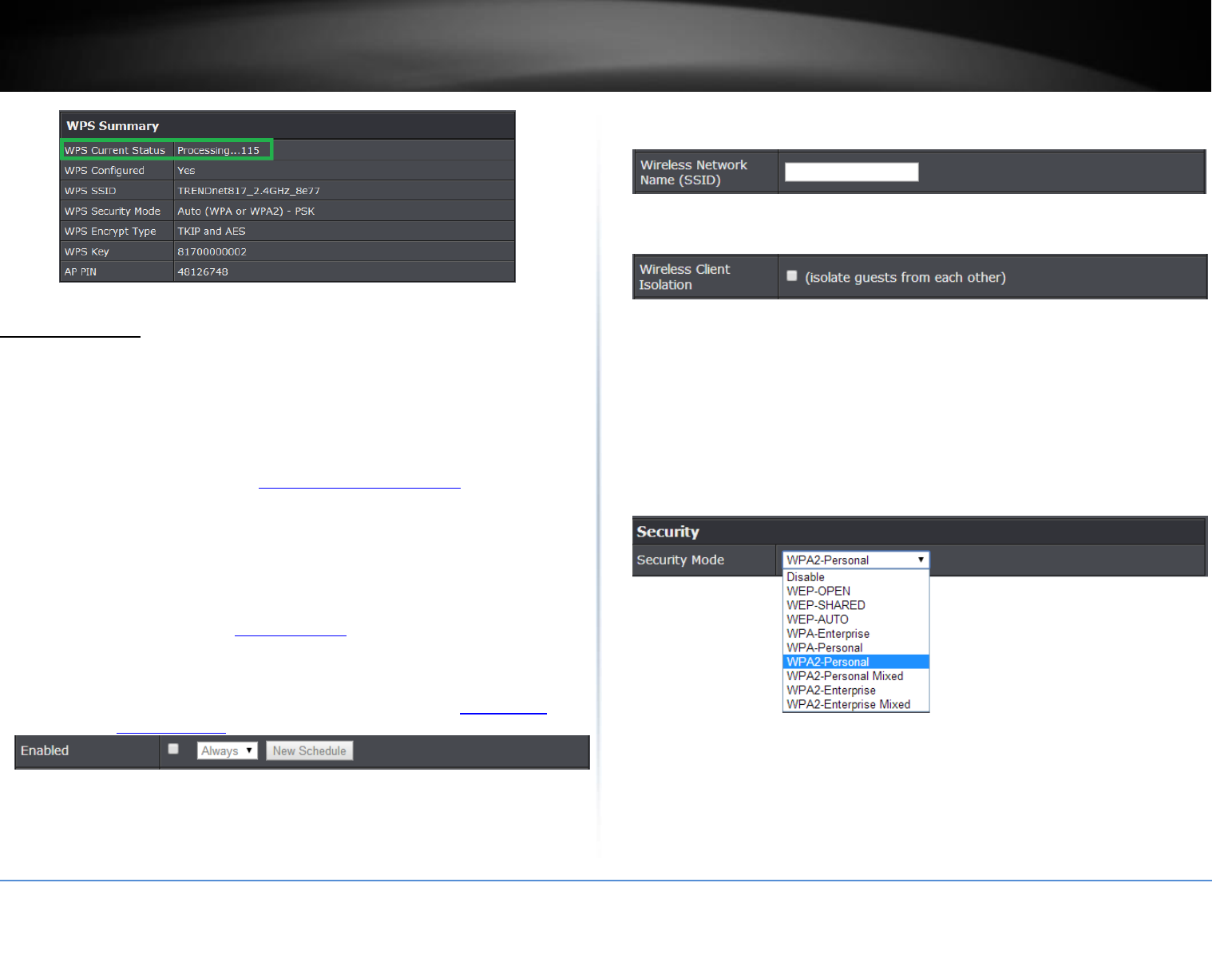
© Copyright 2015 TRENDnet. All Rights Reserved.
TRENDnet User’s Guide
TEW-817DTR
19
Guest Network
Basic > Guest Network (2.4GHz or 5GHz)
Creating an isolated and separate wireless guest network (2.4GHz or 5GHz) allows
wireless clients to connect to your network for Internet access only and keep your local
LAN network safe by restricting guest access to your LAN network resources such as
shared documents and media files on your computers, network storage, and printers.
1. Log into the management page (see “Access your management page” on page 7).
2. Click on Basic and click on Guest Network.
3. Review the Guest Zone settings, click Apply when finished.
Choose which band to enable the Guest Network (Wireless – 2.4GHz or 5GHz):
Enabled: Check this option to enable the wireless guest network.
New Schedule: The schedule function allows you to define a schedule when the
wireless guest network should be turned on. To define a new schedule, click New
Schedule and refer to page 30 “Create Schedules”. After you have created a new
schedule, click the drop-down list and the new schedule will be available for
selection.
Note: Before applying scheduling, please ensure your Time settings are configured
correct and you have defined a schedule. See page 29 to configure Time Settings and
see page 30 “Create Schedules” to create a schedule.
Wireless Network Name (SSID): This acronym stands for Service Set Identifier and
is the name of your wireless network. It differentiates your wireless network from
others around you. It is recommended to use a different name from your primary
wireless network to a name that you can easily identify and differentiate from the
primary. You can reference your guests to access this network instead of the
primary.
Wireless Client Isolation: When this option is checked, wireless client devices
connected to your guest network(s) will be restricted from accessing other guests.
Internet Access Only: When this option is checked, wireless client devices
connected to your guest network(s) will be restricted from accessing your private
LAN and wireless clients connected to your primary wireless network, Internet
access only. If unchecked, allows wireless client devices connected your guest
network(s) complete access to your private LAN, primary wireless network, and
Internet.
4. Under Security Mode, you can apply a different wireless security type and key to the
guest network. Please refer to page 12 to find out about different security types and
page 13 for wireless security configuration.
Security Mode: Select the wireless security to use for the guest network.
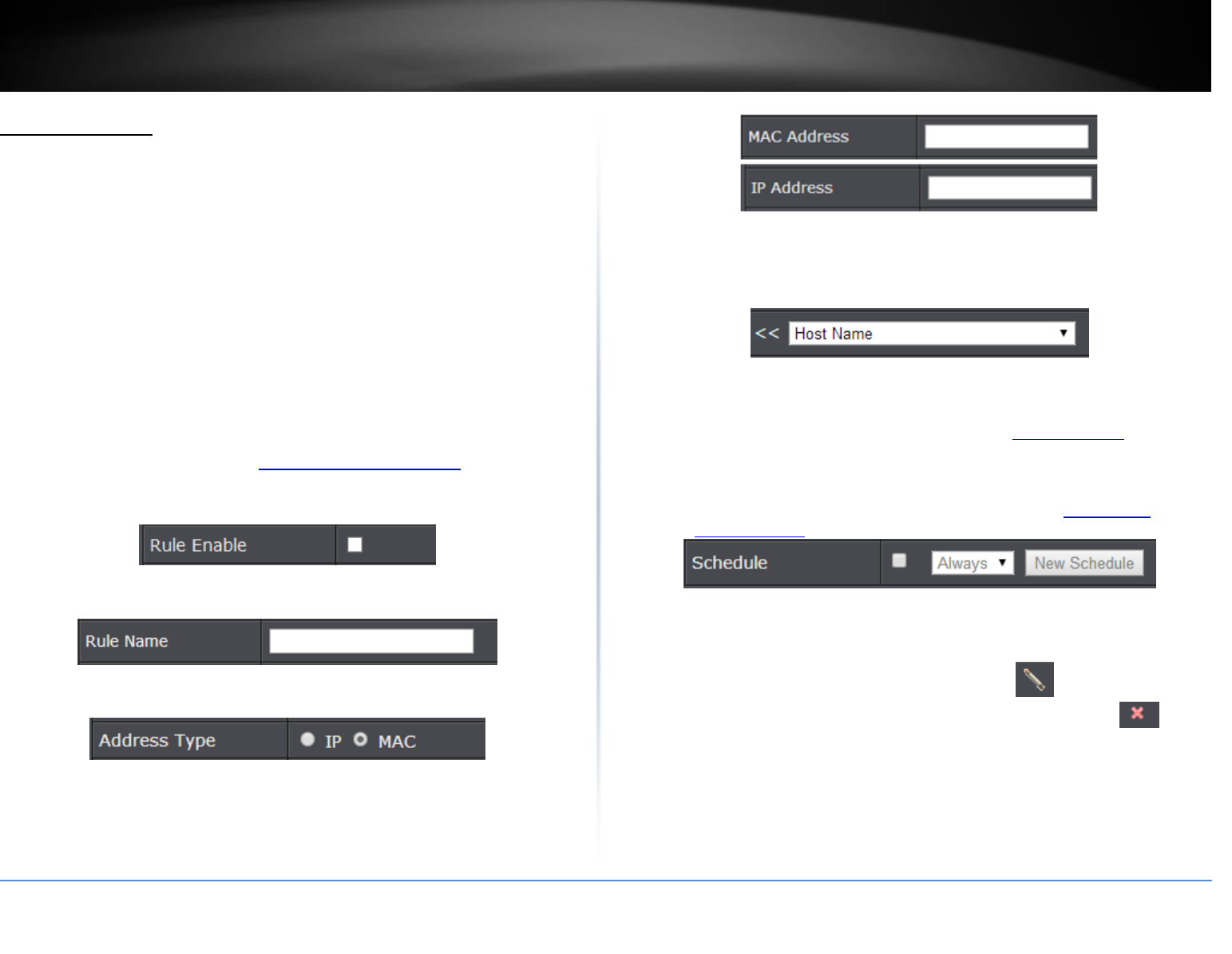
© Copyright 2015 TRENDnet. All Rights Reserved.
TRENDnet User’s Guide
TEW-817DTR
20
Parental Control
Basic > Parental Control
Parental control settings allow you to set up restrictions/filters specifically who is
allowed or denied access to your network for a specified period of time and restricted
access to web content.
Access Rule (MAC/IP Filter)
Basic > Parental Control
Every network device has a unique, 12-digit MAC (Media Access Control) address. Every
network device must be assigned or configured with a specific IP address in order to
communicate with your network which is typically assigned by your router DHCP server
automatically. Using access rules, you can deny specific computers and other devices
from using this router’s wired or wireless network by specifying the MAC address or IP
address.
1. Log into the management page (see “Access your management page” on page 7).
2. Click on Basic, click on Parental Control.
3. Check Enabled to enable the access rule.
4. Enter a Rule Name.
5. Select which Address Type to apply the filter. (MAC Address or IP Address)
Note: If you device is not listed, please refer to your computer or device documentation
to find the MAC address.
6. Manually enter the MAC Address or IP Address in the field.
Note: If the network device is connected to your router, you can also click the drop-down
list to choose one of the network devices (MAC Address/IP Address) detected by your
router.
7. Schedule (Optional): The schedule function allows you to define a schedule when the
access should be active and blocking the specified MAC address or IP address. To define
a new schedule, click New Schedule and refer to page 30 “Create Schedules”. After you
have created a new schedule, click the drop-down list and the new schedule will be
available for selection.
Note: Before applying scheduling, please ensure your Time settings are configured
correct and you have defined a schedule. See page 29 to configure Time Settings and see
page 30 “Create Schedules” to create a schedule.
8. Click Add to add the access rule to the Access Rule List. Wait of the rule to be added.
Note: Clicking Reset will discard your settings and clear all fields.
Note: In the Access Rule List, you can edit a rule by clicking under the Edit column
next to the rule you would like to edit. You can also delete a rule by clicking under
the Delete column next to the rule you would like to delete.
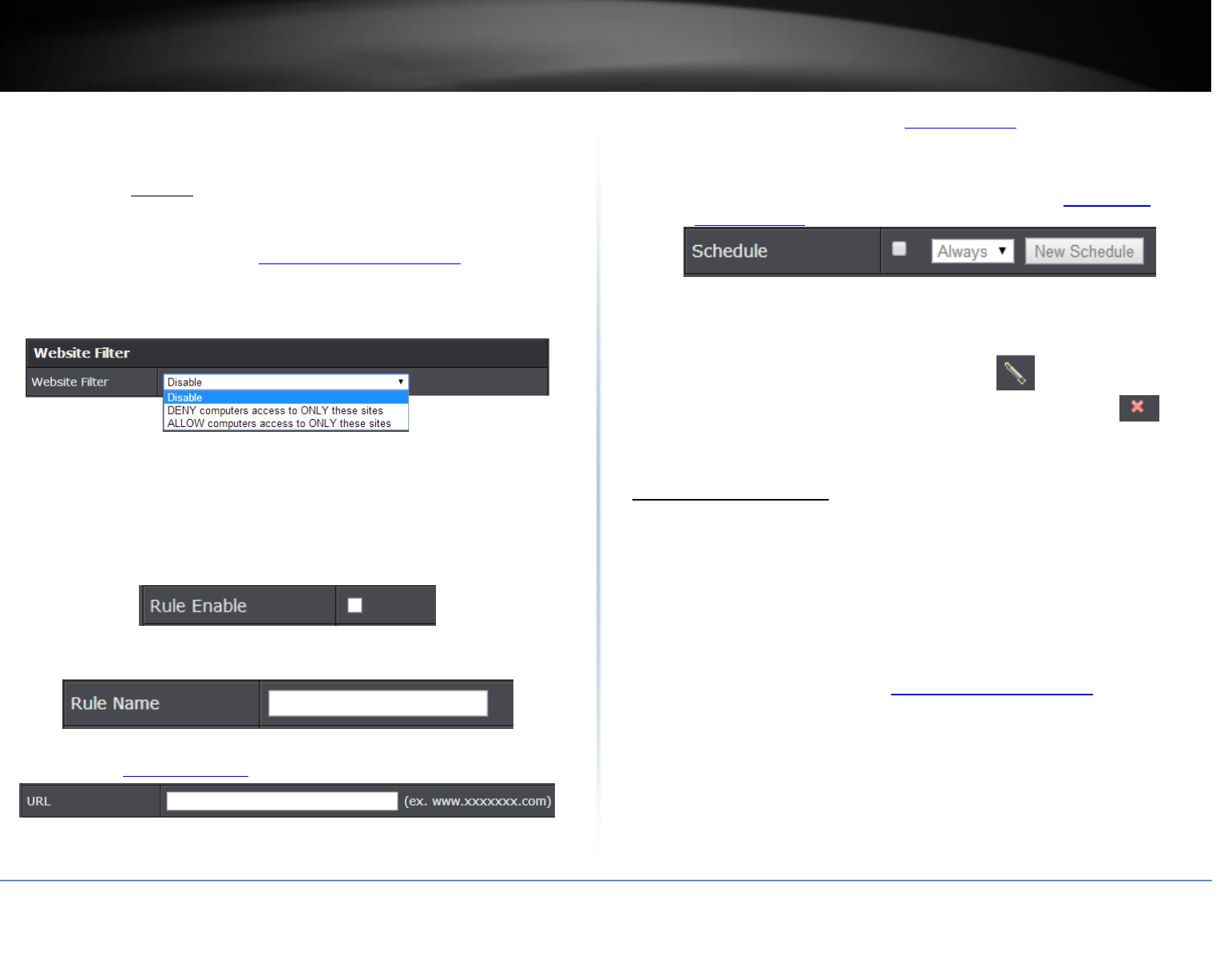
© Copyright 2015 TRENDnet. All Rights Reserved.
TRENDnet User’s Guide
TEW-817DTR
21
Website Filter
Basic > Parental Control
You may want to block computers or devices on your network access to specific
websites (e.g. www.xxxxxxxxx.com, etc.), also called domains or URLs (Uniform Resource
Locators). You may also apply a schedule when these websites are allowed or denied.
1. Log into the management page (see “Access your management page” on page 7).
2. Click on Basic and click on Parental Control.
3. Under Website Filter, click the Website Filter drop-down list and choose one of the
following options.
Disable: Disables website filtering.
DENY computers access to ONLY these sites: Only Deny computers/devices access
to the listed websites and allow access to others.
ALLOW computers access to ONLY these sites: Only Allow computers/devices
access to the listed websites and deny access to others.
4. Check Enable to enable the access rule.
5. Enter a Rule Name.
6. Enter a URL (ex. www.xxxxxxxx.com) to apply for the filter or block
7. Schedule (Optional): The schedule function allows you to define a schedule when the
access should be active and blocking the specified website. To define a new schedule,
click New Schedule and refer to page 30 “Create Schedules”. After you have created a
new schedule, click the drop-down list and the new schedule will be available for
selection.
Note: Before applying scheduling, please ensure your Time settings are configured
correct and you have defined a schedule. See page 29 to configure Time Settings and see
page 30 “Create Schedules” to create a schedule.
8. Click Add to add the access rule to the Access Rule List. Wait of the rule to be added.
Note: Clicking Reset will discard your settings and clear all fields.
Note: In the URL Fille List, you can edit a rule by clicking under the Edit column
next to the rule you would like to edit. You can also delete a rule by clicking under
the Delete column next to the rule you would like to delete.
MAC Filter (Wireless)
Advanced > Wireless (2.4GHz or 5GHz) > MAC Filter
This MAC filter is dedicated to filter on each band and each SSID. Every network device
has a unique, 12-digit MAC (Media Access Control) address. Every network device must
be assigned or configured with a specific IP address in order to communicate with your
network which is typically assigned by your router DHCP server automatically. Using
access rules, you can deny specific computers and other devices from using this router’s
wired or wireless network by specifying the MAC address or IP address.
1. Log into the management page (see “Access your management page” on page 7).
2. Click on Advanced and click on Wireless (2.4GHz or 5GHz), then click on MAC Filter.
3. Review the MAC Filter options. Click Apply to save settings.
Select SSID: If you have multiple SSIDs configured, click the drop-down list to select
which SSID to apply the MAC filter.
Wireless MAC Filter
o Filter Mode
Disabled: Disables MAC address filter.
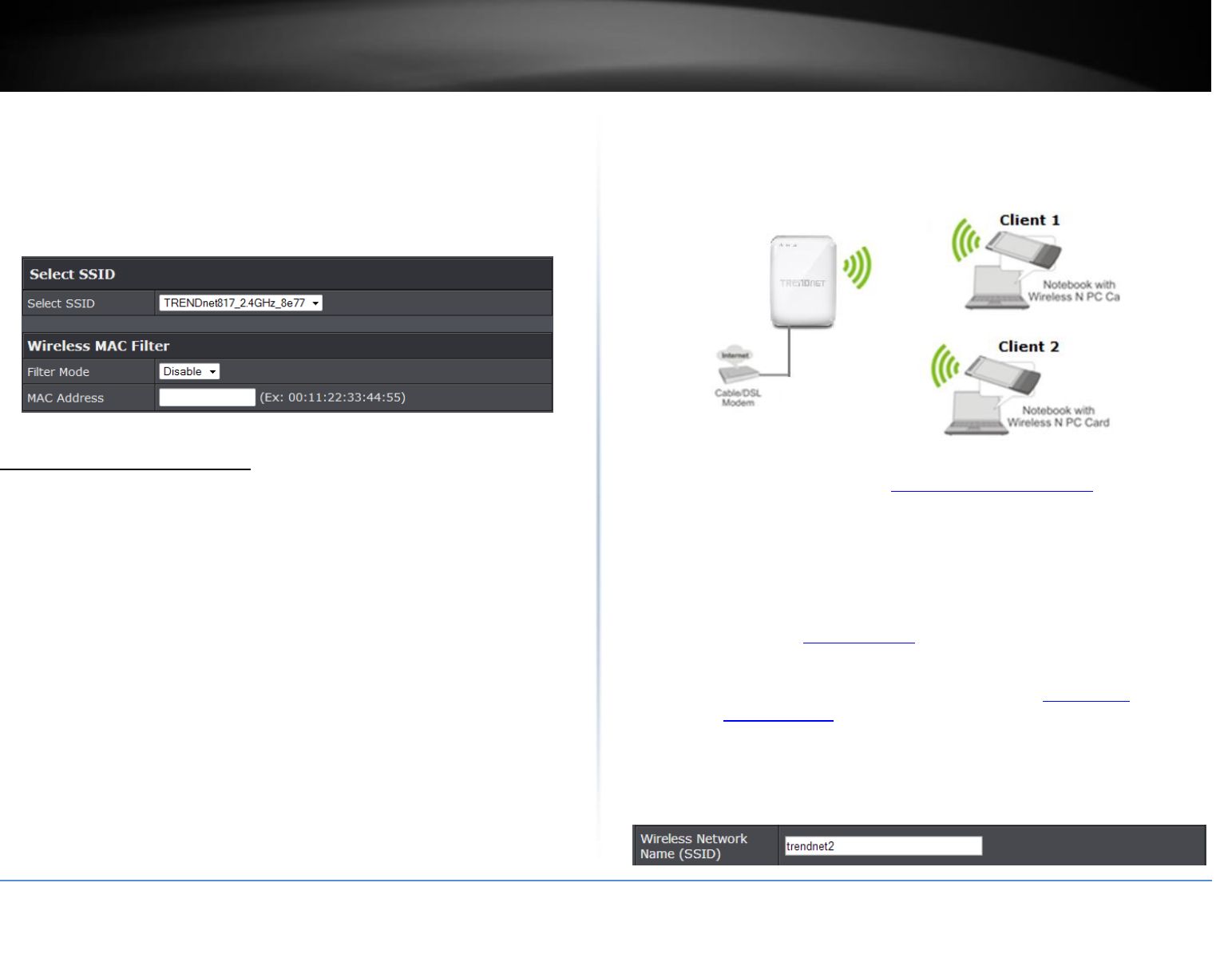
© Copyright 2015 TRENDnet. All Rights Reserved.
TRENDnet User’s Guide
TEW-817DTR
22
Allow listed computers and deny all others: Selecting this function allows
computers/devices with MAC addresses listed to access the local network
(LAN/WLAN), web management, and the Internet.
Deny listed computers and allow all others: Selecting this function denies
computers/devices with MAC addresses listed from access to the local
network (LAN/WLAN), web management, and the Internet.
o MAC Address: Enter the MAC address of the wireless device to apply to this filter.
Advanced wireless settings
The advanced wireless features provide can provide you with additional options for
setting up your wireless network such as multiple SSID and WDS (Wireless Distribution
System) or wireless bridging.
Multiple SSID
Advanced > Wireless (2.4GHz or 5GHz) > Multiple SSID
The multiple SSID feature allows you to broadcast up to 3 SSIDs (or wireless network
names). When wireless devices are searching for available wireless networks to connect
to, the SSIDs (or wireless network names) will appear as separate and different wireless
networks. Since they appear as separate wireless networks, they are also referred to as
virtual APs (Access Points) since they appear as separate wireless access points but are
actually all being broadcasting and managed by a single wireless access point. Each
virtual AP can be configured each with a different SSID (or wireless network name),
security type and additional settings for wireless devices to connect. You can use the
multiple SSID feature to setup guest wireless accounts with a different security type to
keep your primary wireless network security information private. The diagram shows an
example of a client connecting to SSID 1 and another client connecting to SSID 2.
By default, your router functions in Access Point mode to allow wireless client devices to
connect and access your network resources and access the Internet using a single SSID.
The diagram below shows your router in Access Point mode and clients connecting to
your router using a single SSID.
To configure multiple SSID on your router:
1. Log into the management page (see “Access your management page” on page 7).
2. Click on Advanced and click on Wireless (2.4GHz or 5GHz), then click on Multiple
SSID.
3. Next to Multiple SSID1 or SSID2, check Radio On/Off option to enable the additional
SSID.
New Schedule: The schedule function allows you to define a schedule when the
additional SSID should be turned on. To define a new schedule, click New Schedule
and refer to page 30 “Create Schedules”. After you have created a new schedule,
click the drop-down list and the new schedule will be available for selection. Note:
Before applying scheduling, please ensure your Time settings are configured correct
and you have defined a schedule. See page 29 to configure Time Settings and see
page 30 “Create Schedules” to create a schedule.
4. Wireless Name (SSID): Enter the wireless name (SSID) for additional SSID. This
acronym stands for Service Set Identifier and is the name of your wireless network. It
differentiates your wireless network from others around you. By default, the router’s
wireless name is unique to the device. It is recommended to change it to a name
different from the primary SSID 1 and one that you can easily remember.
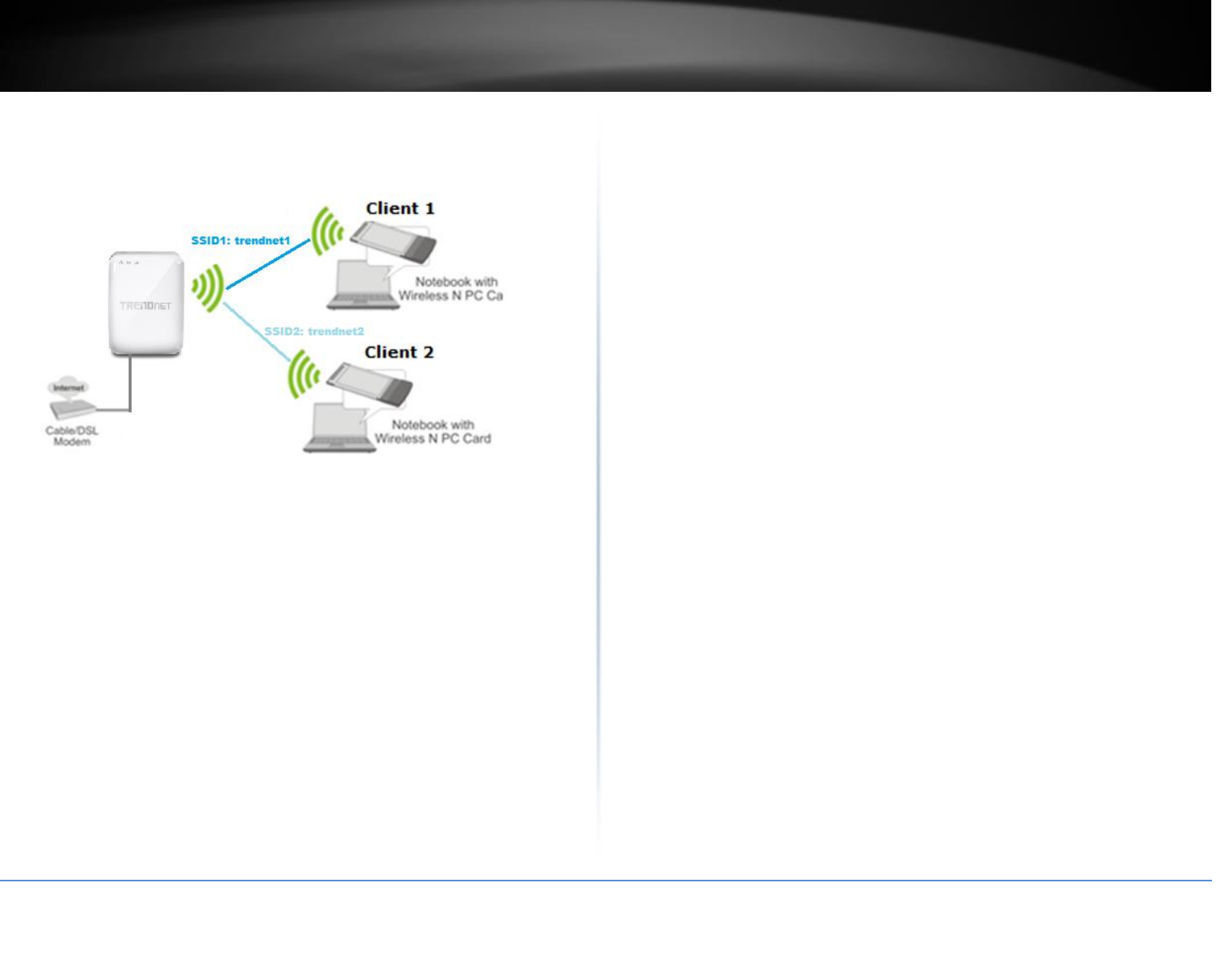
© Copyright 2015 TRENDnet. All Rights Reserved.
TRENDnet User’s Guide
TEW-817DTR
23
Please refer to page 15 to find out about different security types and page 16 for
wireless security configuration.
The diagram shows an example of a client connecting to SSID 1 and another client
connecting to SSID 2.
5. To save changes, click Apply.
Note: You can repeat the steps to enable and configure additional SSIDs.
Advanced Settings
Advanced > Wireless (2.4GHz or 5GHz) > Advanced
These settings are advanced options that can be configured to change advanced
wireless broadcast specifications. It is recommended that these settings remain set to
their default values unless you are knowledgeable about the effects of changing these
values. Changing these settings incorrectly can degrade performance.
Beacon Period: A beacon is a management frame used in wireless networks that
transmitted periodically to announce the presence and provide information about
the router’s wireless network. The interval is the amount time between each
beacon transmission.
Default Value: 100 milliseconds (range: 100-1000)
DTIM: A DTIM is a countdown informing clients of the next window for listening to
broadcast and multicast messages. When the wireless router has buffered
broadcast or multicast messages for associated clients, it sends the next DTIM with
a DTIM Interval value. Wireless clients detect the beacons and awaken to receive
the broadcast and multicast messages. The default value is 1. Valid settings are
between 1 and 255.
Fragment Threshold: Wireless frames can be divided into smaller units (fragments)
to improve performance in the presence of RF interference and at the limits of RF
coverage. Fragmentation will occur when frame size in bytes is greater than the
Fragmentation Threshold. This setting should remain at its default value of 2346
bytes. Setting the Fragmentation value too low may result in poor performance.
RTS Threshold: The Request To Send (RTS) function is part of the networking
protocol. A wireless device that needs to send data will send a RTS before sending
the data in question. The destination wireless device will send a response called
Clear to Send (CTS). The RTS Threshold defines the smallest data packet size
allowed to initiate the RTS/CTS function. Default Value: 2347 (range: 1-2347)
TX Power: This setting allows you to adjust the wireless transmit power to a lower
setting. In busy wireless environments, lowering the transmit power may improve
better performance and connectivity and decrease interference with neighboring
wireless networks.
Short Preamble: Using a short preamble can potentially increase throughput as the
transfer time is 96 microseconds versus the more commonly used long preamble
192 microseconds. However, using a short preamble is not supported using 802.11b
legacy devices, in some cases cause wireless interoperability issues, and increase
the error rate in some installations. The preamble is the info. sent from the wireless
transmitter to the receiver indicating when data is incoming.
Short Slot: Short Slot Override defines the amount of time a device waits after a
data frame collision before retransmitting the data. Reducing the time from 20
microseconds (standard) to 9 microseconds can potentially increase throughput
however, can also increase the error rate.
20/40 Coexistence (2.4GHz only): 20/40 MHz Coexistence allows for the auto-
fallback from 40MHz to 20MHz channel width operation when neighboring 802.11
wireless networks are detected.
Guard Interval: Using a short (400ns) guard interval can increase throughput.
However, it can also increase error rate in some installations, due to increased
sensitivity to radio-frequency reflections.
MCS – Allows you to lock down the wireless transmission rate.
Extension channel – Allows you to assign either the upper or lower extension
channels to use for channel bonding when establishing connectivity at the higher
channel widths 40MHz and 80MHz.
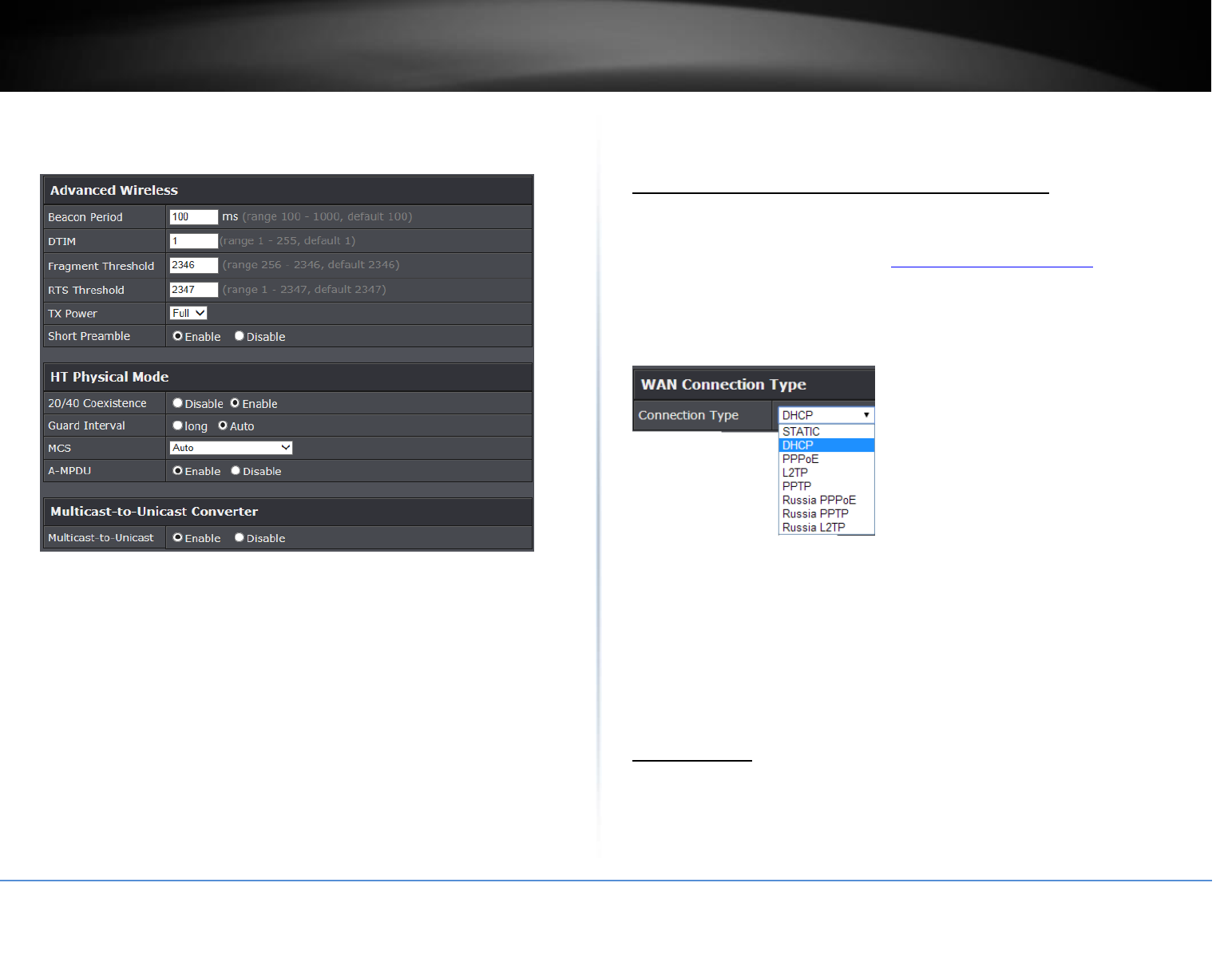
© Copyright 2015 TRENDnet. All Rights Reserved.
TRENDnet User’s Guide
TEW-817DTR
24
A-MPDU: Using Aggregate Multiple Protocol Data Unit will allow the all frames
transmitted to be aggregated into larger size A-MPDU formatted frames before
sending and receiving potentially increasing the overall throughput.
Advanced Settings
Manually configure your Internet connection
Advanced > Setup > WAN Settings
1. Log into the management page (see “Access your management page” on page 7).
2. Click on Advanced and click on Setup, then click on WAN Settings.
3. Under Internet Connection Type in drop-down list, select the type of Internet
connection provided by your Internet Service Provider (ISP).
4. Complete the fields required by your ISP.
5. Complete the optional settings only if required by your ISP.
6. To save changes, click Apply.
Note: If you are unsure which Internet connection type you are using, please contact
your ISP.
IPv6 Settings
Advanced > Setup > IPv6 Settings
IPv6 (Internet Protocol Version 6) is a new protocol that significantly increases the
number of available Internet public IP addresses due to the 128-bit IP address structure
versus IPv4 32-bit address structure. In addition, there are several integrated
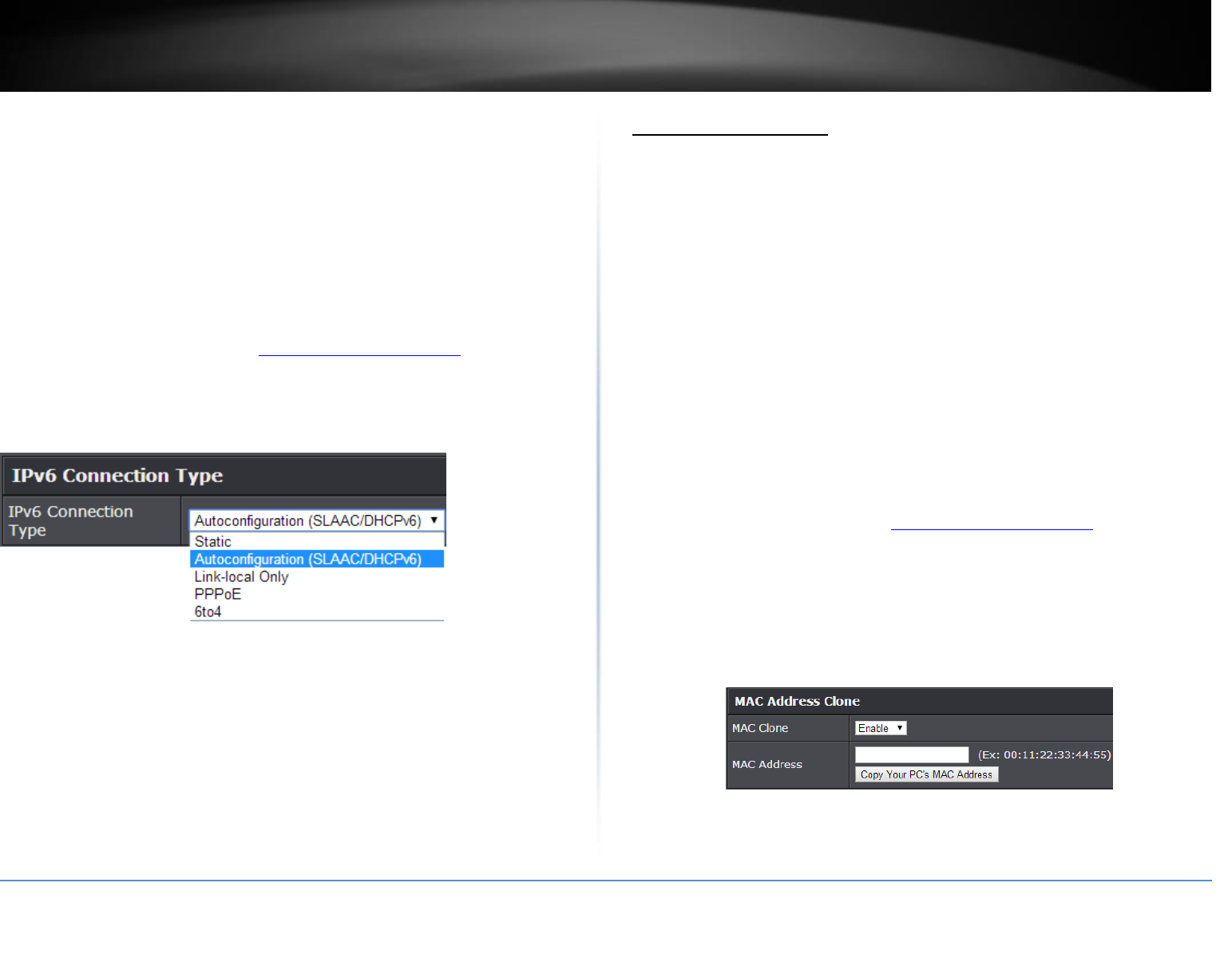
© Copyright 2015 TRENDnet. All Rights Reserved.
TRENDnet User’s Guide
TEW-817DTR
25
enhancements compared to the most commonly used and well known IPv4 (Internet
Protocol Version 4) such as:
Integrated IPsec – Better Security
Integrated Quality of Service (QoS) – Lower latency for real-time applications
Higher Efficiency of Routing – Less transmission overhead and smaller routing tables
Easier configuration of addressing
Note: In order to use IPv6 Internet connection settings, it is required that your ISP
provide you with the IPv6 service. Please contact your ISP for availability and more
information about the IPv6 service.
1. Log into the management page (see “Access your management page” on page 7).
2. Click on Advanced and click on Setup, then click on IPv6 Settings.
3. Review the IPv6 Internet Connection settings and enter information settings specified
by your ISP. Click Apply to save changes.
Note: Please contact your ISP for IPv6 service availability.
Select the IPv6 connection type provided by your ISP.
Static IPv6
Auto-configuration (SLAAC/DHCPv6)
PPPoE
6to4
Link-Local Only
Clone a MAC address
Advanced > Setup > WAN Settings
On any home network, each network device has a unique MAC (Media Access Control)
address. Some ISPs register the MAC address of the device (usually a router or a
computer) connected directly to the modem. If your computer MAC address is already
registered with your ISP and to prevent the re-provisioning and registration process of a
new MAC address with your ISP, then you can clone the address (assign the registered
MAC address of your previous device to your new router). If you want to use the MAC
address from the previous device (computer or old router that directly connected to the
modem, you should first determine the MAC address of the device or computer and
manually enter it into your router using the clone MAC address feature.
Note: For many ISPs that provide dynamic IP addresses automatically, typically, the
stored MAC address in the modem is reset each time you restart the modem. If you are
installing this router for the first time, turn your modem before connecting the router to
your modem. To clear your modem stored MAC address, typically the procedure is to
disconnect power from the modem for approximately one minute, then reconnect the
power. For more details on this procedure, refer to your modem’s User Guide/Manual or
contact your ISP.
1. Log into the management page (see “Access your management page” on page 7).
2. Click on Advanced and click on Setup, then click on WAN Settings.
3. In the MAC Address Clone section, click the MAC Clone drop-down list, and select
Enable. Then click Clone Your PC’s MAC Address to copy your computer’s MAC address
in the MAC Address field.
Note: You can also check the DHCP Client List for the MAC addresses of the devices on
your network, see page 28 or refer to your computer or device documentation to find the
MAC address.
4. To save changes, click Apply.
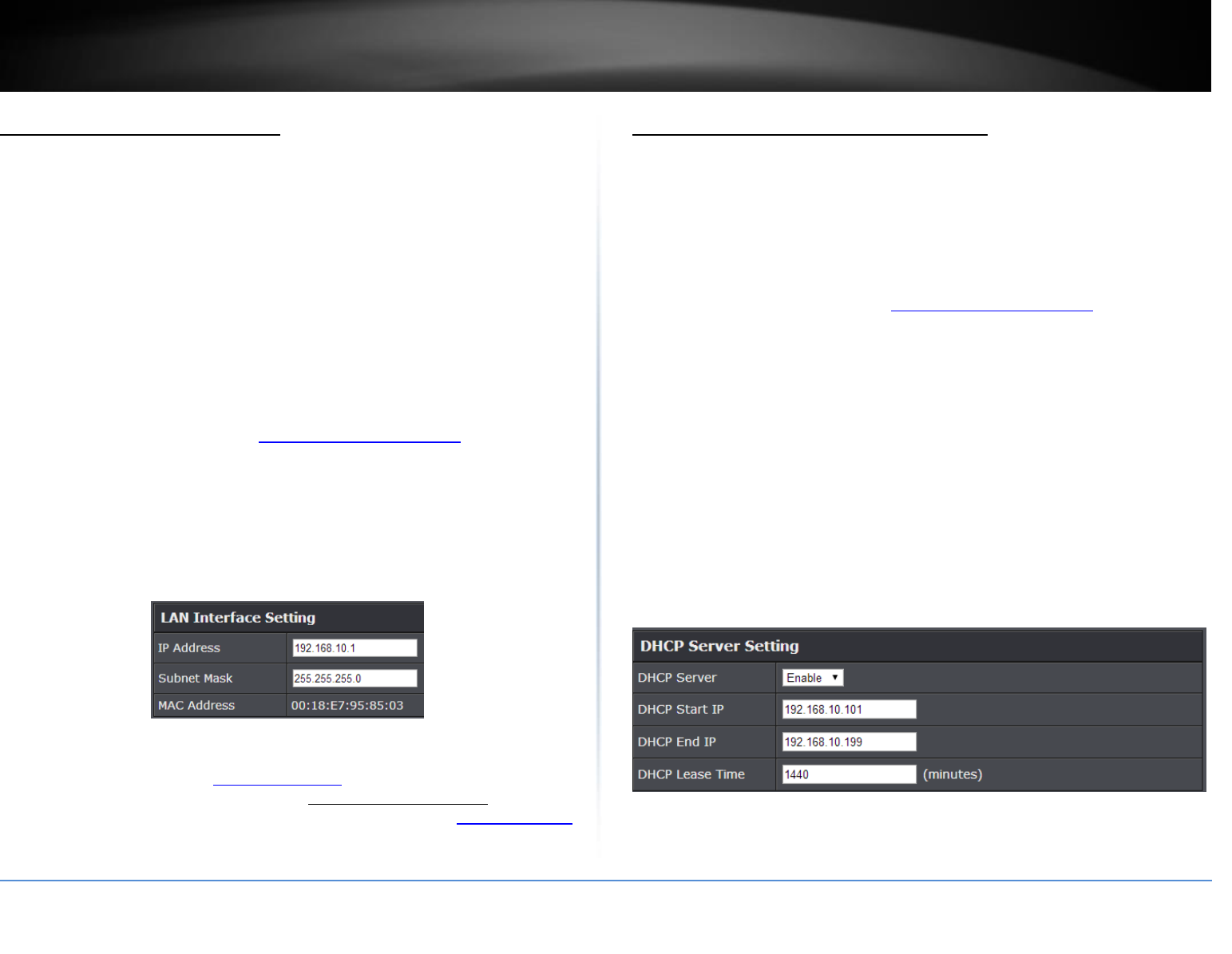
© Copyright 2015 TRENDnet. All Rights Reserved.
TRENDnet User’s Guide
TEW-817DTR
26
Change your router IP address
Advanced > Setup > LAN Settings
In most cases, you do not need to change your router IP address settings. Typically, the
router IP address settings only needs to be changed, if you plan to use another router in
your network with the same IP address settings, if you are connecting your router to an
existing network that is already using the IP address settings your router is using, or if
you are experiencing problems establishing VPN connections to your office network
through your router.
Note: If you are not encountering any issues or are not faced with one of the cases
described above or similar, it is recommended to keep your router IP address settings as
default.
Default Router IP Address: 192.168.10.1
Default Router Network: 192.168.10.0 / 255.255.255.0
1. Log into the management page (see “Access your management page” on page 7).
2. Click on Advanced and click on Setup, then click on LAN Settings.
3. In LAN Interface Setting section, Enter the router IP address settings.
IP Address: Enter the new router IP address. (e.g. 192.168.200.1)
Subnet Mask: Enter the new router subnet mask. (e.g. 255.255.255.0)
Note: The DHCP address range will change automatically to your new router IP
address settings so you do not have to change the DHCP address range manually
to match your new router IP address settings.
4. To save changes, click Apply.
Note: You will need to access themanagement page using your new router IP address.
(e.g. Instead of using the default http://192.168.10.1 your new router IP address will use
the following format using your new IP address http://(new.ipaddress.here) to access
your router management page. You can also use the default login URL http://tew-817dtr
Set up the DHCP server on your router
Advanced > Setup > LAN Settings
Your router can be used as a DHCP (Dynamic Host Configuration Protocol) server to
automatically assign an IP address to each computer or device on your network. The
DHCP server is enabled by default on your router. If you already have a DHCP server on
your network, or if you do not want to use your router as a DHCP server, you can disable
this setting. It is recommended to leave this setting enabled.
1. Log into the management page (see “Access your management page” on page 7).
2. Click on Advanced and click on Setup, then click on LAN Settings.
3. Review the DHCP Server settings. Click Apply to save settings.
DHCP Server: Enable or Disable the DHCP server.
DHCP Start IP: Changes the starting address for the DHCP server range.
(e.g. 192.168.10.20)
DHCP End IP: Changes the ending address for the DHCP server range.
(e.g. 192.168.10.30)
Note: The Start IP and End IP specify the range of IP addresses to automatically
assign to computers or devices on your network.
DHCP Lease Time – Enter the DHCP lease time in minutes.
Note: The DHCP lease time is the amount of time a computer or device can keep
an IP address assigned by the DHCP server. When the lease time expires, the
computer or device will renew the IP address lease with the DHCP server,
otherwise, if there is no attempt to renew the lease, the DHCP server will
reallocate the IP address to be assigned to another computer or device.
You can also view the current DHCP clients in the Number of Dynamic DHCP Clients list
under Advanced > Setup > DHCP Client List.
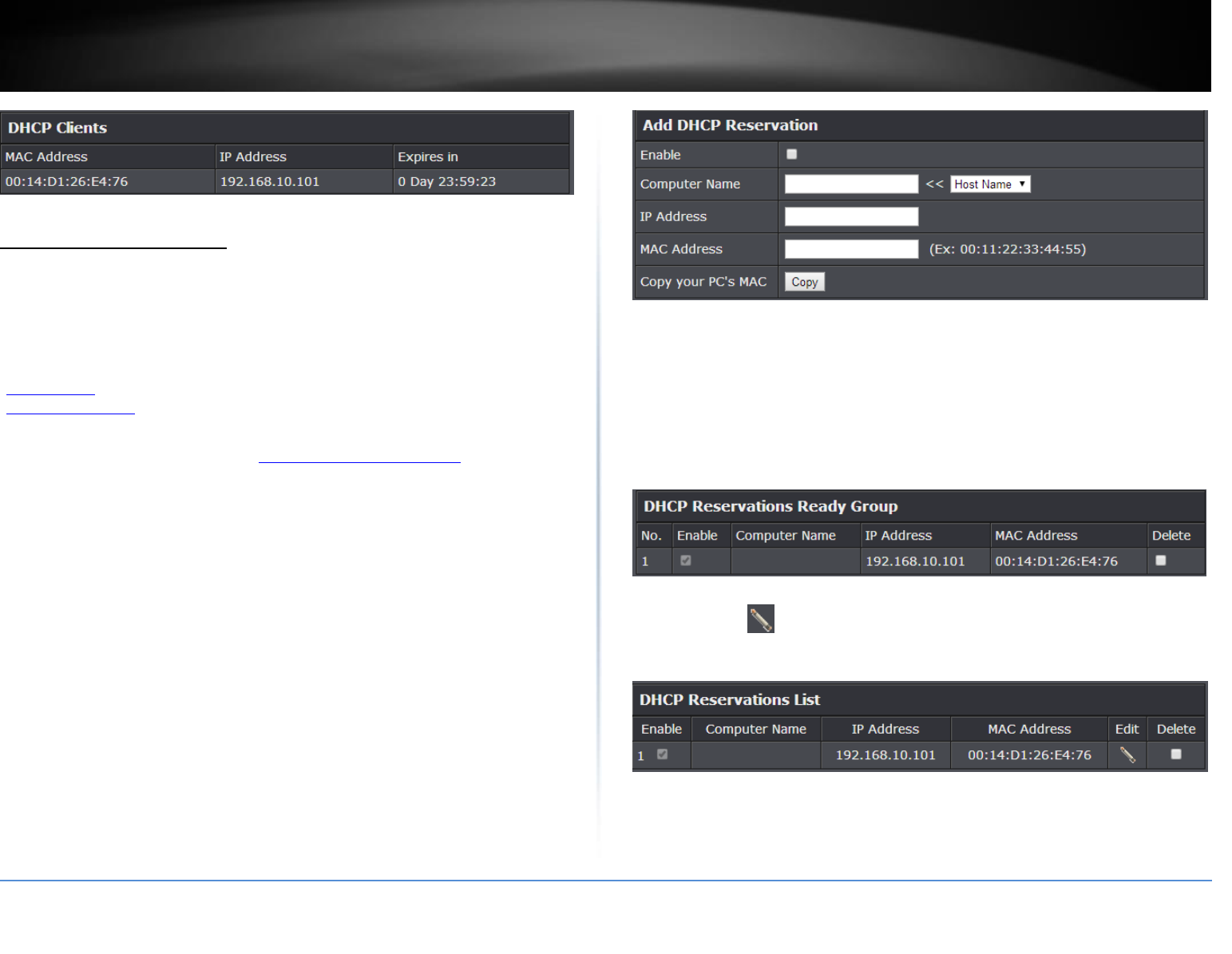
© Copyright 2015 TRENDnet. All Rights Reserved.
TRENDnet User’s Guide
TEW-817DTR
27
Set up DHCP reservation
Advanced > Setup > LAN Settings
DHCP (Dynamic Host Configuration Protocol) reservation (also called Static DHCP) allows
your router to assign a fixed IP address from the DHCP server IP address range to a
specific device on your network. Assigning a fixed IP address can allow you to easily
keep track of the IP addresses used on your network by your computers or devices for
future reference or configuration such as virtual server (also called port forwarding, see
“Virtual Server” on page 33) or special applications (also called port triggering, see
“Special Applications” on page 34).
1. Log into the management page (see “Access your management page” on page 7).
2. Click on Advanced and click on Setup, then click on LAN Settings.
3. Review the DHCP reservation settings.
Enable: Enable or Disable the DHCP reservation.
Computer Name: Enter a name of the device you will assign the DHCP reservation.
Note: You can click the Computer Name drop-down list to select from an available
computer in the DHCP server listing, click >> to copy the computer’s host name/IP
address information into the fields.
IP Address: Enter the IP address to assign to the reservation. (e.g. 192.168.10.101)
Note: You can click the Computer Name drop-down list to select from an
available computer in the DHCP server listing, click >> to copy the computer’s
host name/IP address information into the fields.
MAC Address: Enter the MAC (Media Access Control) address of the computer or
network device to assign to the reservation. (e.g. 00:11:22:AA:BB:CC)
Note: You can click Clone your PC’s MAC Address to copy the current
computer’s MAC address into the MAC address field.
Copy your PC’s MAC: To copy your current computer’s MAC address to the field,
you can click Copy.
Click Add: Saves the reservation.
Note: Click Clear discards and erases the current information.
You will see the new reservation added to the DHCP Reservations Ready Group. This is a
temporary list until you save changes by clicking Apply. You can continue to add more
DHCP reservation entries which will appear in this list. Once you have saved the settings,
the entries will appear under the DHCP Reservations list. You can click Reset to clear the
entries in the list or check the Delete option, next to the entry to remove and click
Delete.
Under the DHCP Reservations List,
You can click the icon to edit the reservation or check the Delete option next to the
entry to remove and click Delete Selected to delete the reservation. You can also click
Delete All to delete all DHCP reservation entries from the list.
To save changes when modifying a reservation, click Save.
Note: If you would like to discard the changes, click Clear.
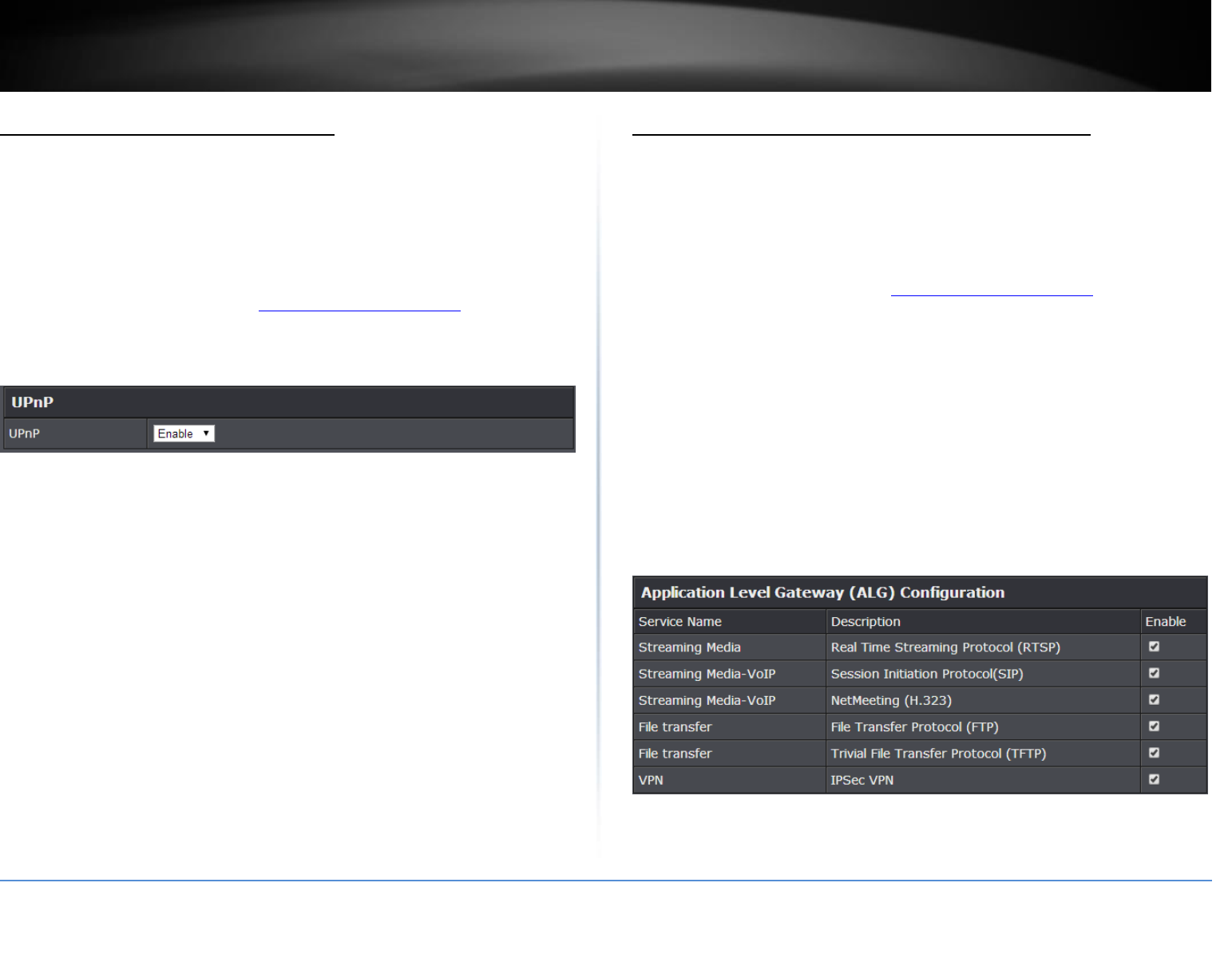
© Copyright 2015 TRENDnet. All Rights Reserved.
TRENDnet User’s Guide
TEW-817DTR
28
Enable/disable UPnP on your router
Advanced > Administrator > Advanced Network
UPnP (Universal Plug and Play) allows devices connected to a network to discover each
other and automatically open the connections or services for specific applications (e.g.
instant messenger, online gaming applications, etc.) UPnP is enabled on your router by
default to allow specific applications required by your computers or devices to allow
connections through your router as they are needed.
1. Log into the management page (see “Access your management page” on page 7).
2. Click on Advanced and click on Administrator, then click Advanced Network.
3. Under the UPnP section, check the option to enable UPnP or uncheck to disable
UPnP.
Note: It is recommended to leave this setting enabled, otherwise, you may encounter
issues with applications that utilize UPnP in order allow the required communication
between your computers or devices and the Internet.
4. To save changes, click Apply.
Enable/disable Application Layer Gateways (ALG)
Advanced > Firewall > ALG
You may want to configure your router to allow computers the use of specific high layer
applications or service sessions to pass through. Application Layer Gateways (ALG)
allows you to easily enable or disable these applications to pass through your router.
Note: It is recommended to leave these settings enabled.
1. Log into the management page (see “Access your management page” on page 7).
2. Click on Advanced and click on Firewall, then click on ALG.
3. Review the applications to enable or disable. Click Apply to save the changes.
Streaming Media (RTSP): Allows RTSP protocol through your router typically used
in streaming media applications.
Streaming Media-VoIP (SIP): Allows SIP protocol through your router typically
used in VoIP applications
Streaming Media-VoIP (H.323): Allows H.323 protocol through your router
typically used in video/audio conferencing applications.
File Transfer (FTP): Allows FTP protocol through your router used for file transfer
over a network or the Internet.
File Transfer (TFTP): Allows TFTP protocol through your router used for file
transfer over a network or the Internet.
VPN IPsec (VPN): Allows IPsec VPN client connections through your router.
4. To save changes, click Apply.
Note: If you would like to discard the changes, click Cancel.
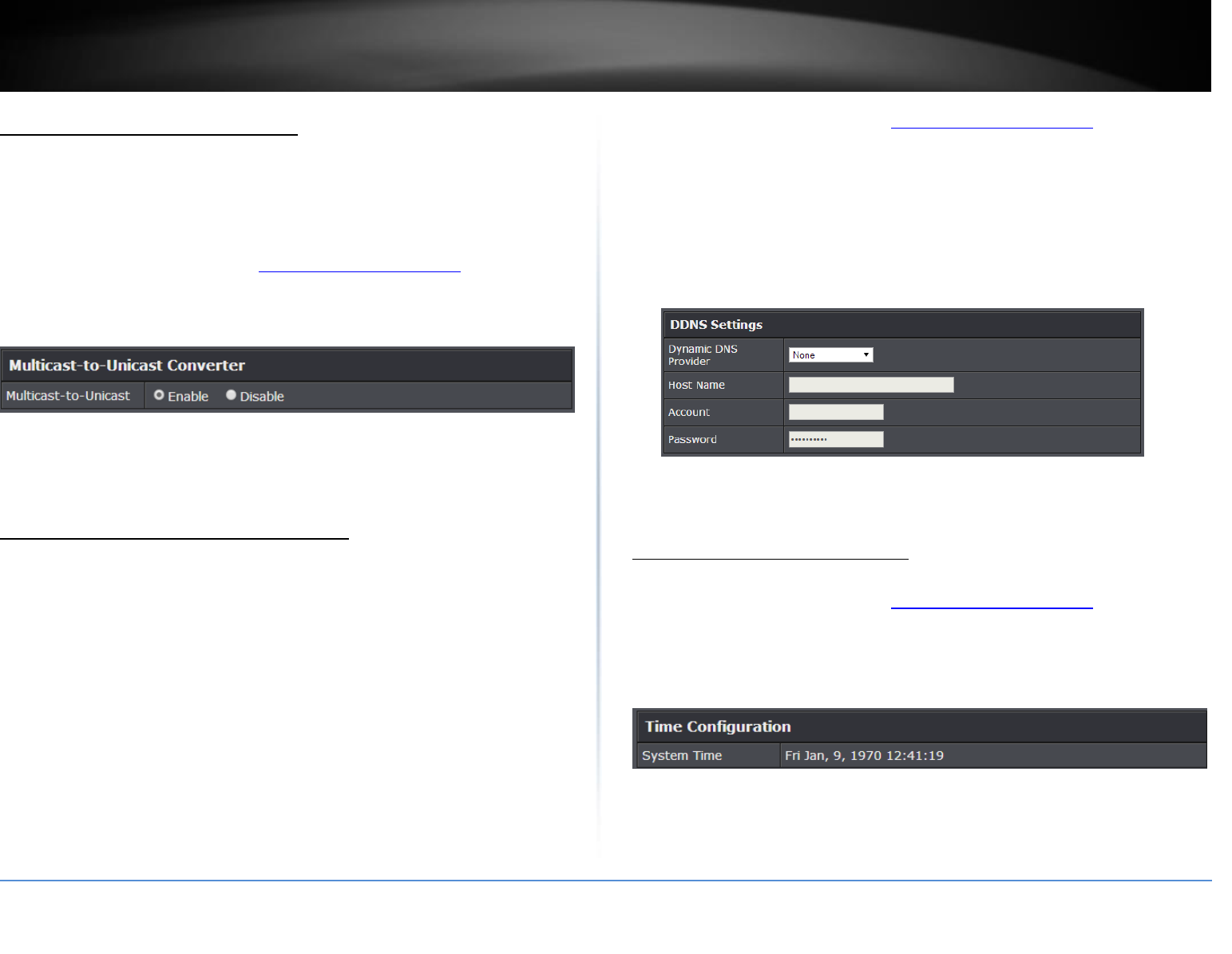
© Copyright 2015 TRENDnet. All Rights Reserved.
TRENDnet User’s Guide
TEW-817DTR
29
Allow/deny multicast streaming
Advanced > Wireless (2.4GHz or 5GHz)
In some cases, applications require multicast communication (also called IP multicast
which is the delivery of information to a specific group of computers or devices in a
single transmission) typically used in media streaming applications.
1. Log into the management page (see “Access your management page” on page 7).
2. Click on Advanced and click on Wireless (2.4GHz or 5GHz), then and click on
Advanced.
3. Next to Multicast-to-Unicast Converter, select the option to enable or disable.
4. To save changes, click Apply.
Note: If you would like to discard the changes, click Cancel.
Identify your network on the Internet
Advanced > Setup > Management
Since most ISPs constantly change your home IP address, providing access to devices on
your home or small office Local Area Network (such as IP Cameras) from the Internet
requires setting up a Dynamic DNS service and entering the parameters into this
management area. Dynamic DNS services allow your router to confirm its location to the
given Dynamic DNS service, thereby providing the Dynamic DNS service with the ability
to provide a virtual fixed IP address for your network. This means that even though your
ISP is always changing your IP address, the Dynamic DNS service will be able to identify
your network using a fixed address—one that can be used to view home IP Camera and
other devices on your local area network.
Note: First, you will need to sign up for one of the DDNS service providers listed in the
Server Address drop-down list.
1. Sign up for one of the DDNS available service providers list under Server Address.
(e.g. no-ip.com, etc.)
2. Log into the management page (see “Access your management page” on page 7).
3. Click on Advanced and click on Setup, then click on Management.
4. Review the DDNS Settings section. Click Save Settings to save settings.
Dynamic DNS Provider Server: Click the drop-down list Select your DDNS service.
Host Name: Personal URL provided to you by your Dynamic DNS service provider
(e.g. www.trendnet.dyndns.biz)
Account: The user name needed to log in to your Dynamic DNS service account
Password: This is the password to gain access to Dynamic DNS service for which
you have signed up to. (NOT your router or wireless network password)
5. To save changes, click Apply.
Set your router date and time
Advanced > Administrator > Time
1. Log into the management page (see “Access your management page” on page 7).
2. Click on Advanced and click on Administrator, then click Time.
3. Review the Time settings. Click Apply to save settings.
Time: Displays the current device time and date information.
Enable Daylight Saving: Check the option to enable daylight savings time and set
the annual range when daylight saving is activated.
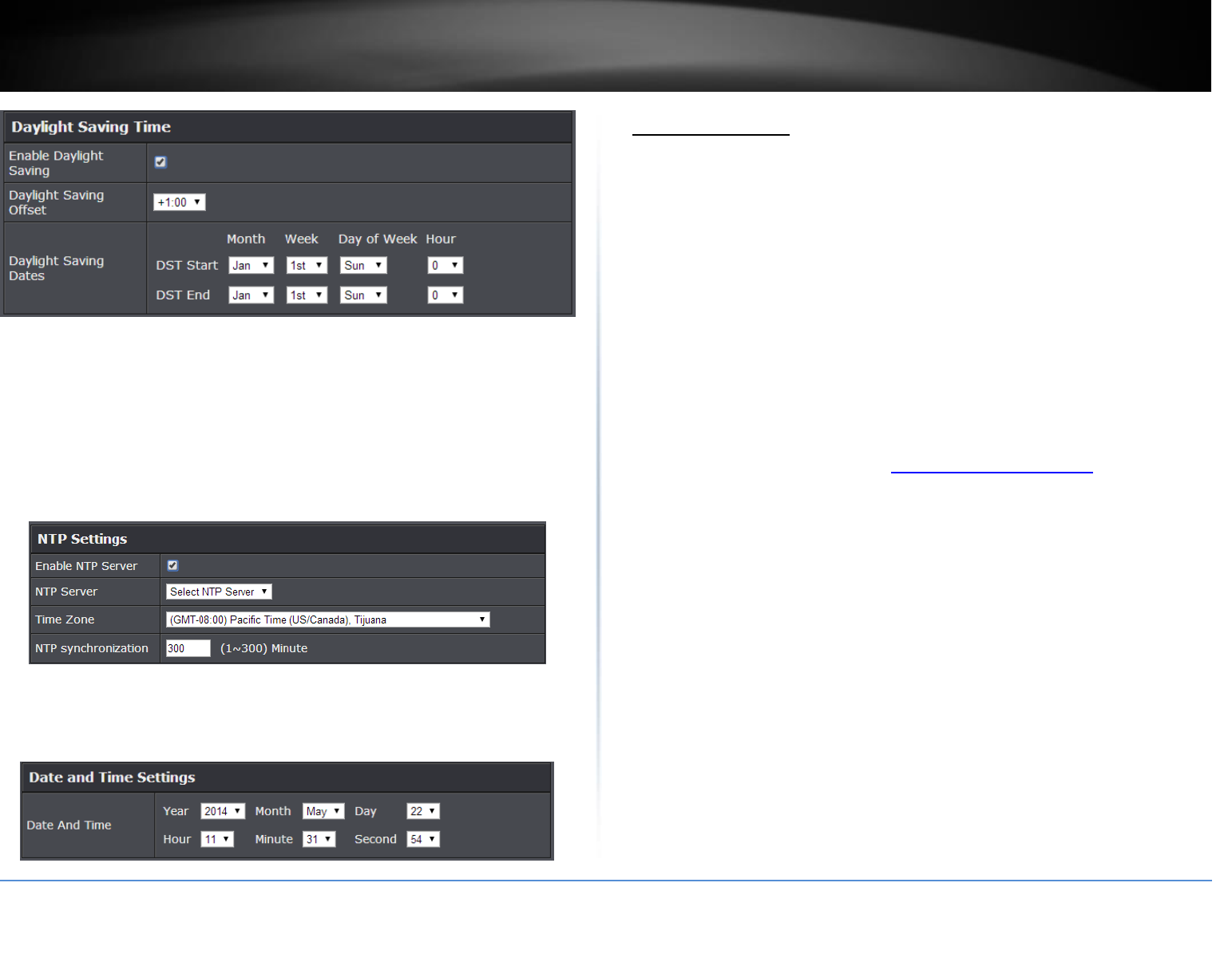
© Copyright 2015 TRENDnet. All Rights Reserved.
TRENDnet User’s Guide
TEW-817DTR
30
You can choose one of the following options to set the device time and date:
Automatically synchronize with Internet Time Server: Check the Enable NTP
Server option to set your router date and time to synchronize with an NTP
(Network Time Protocol) server address (e.g. pool.ntp.org). Enter the NTP server
address next to Default NTP server, (e.g. pool.ntp.org). Click the Time Zone drop-
down list to select the appropriate zone and you can optionally change your NTP
Sync period.
Note: NTP servers are used for computers and other network devices to
synchronize time across an entire network.
Manually set time: Set your router date and time manually in the Date and Time
Settings section. Note: Time is specified in 24-hour format. In addition, you can
click Synchronize with Your Computer’s Time Settings to copy the time and date
settings from your computer.
Create schedules
Advanced > Setup > Schedule
For additional security control, your router allows you to create schedules to specify a
time period when a feature on your router should be activated and deactivated. Before
you use the scheduling feature on your router, ensure that your router system time is
configured correctly.
Note: You can apply a predefined schedule to the following features:
Wireless (2.4GHz and 5GHz)
Guest Network
Parental Control (MAC/IP Filters)
Access Control (IP Protocol Filters)
Virtual Server
Special Applications
Gaming
1. Log into the management page (see “Access your management page” on page 7).
2. Click on Advanced and click on Setup, then click on Schedule.
3. Review the Schedule settings. Click Apply to save settings.
Rule Name: Enter a name for the schedule you would like to apply.
Day(s)/Select Day(s): Check Select Day(s) to select the days in the Select Day(s)
section or select All Week to set the schedule for all days.
All Day – 24 Hours: Check the option to set the schedule to 24 hours or define
the schedule under Start Time and End Time.
Start/End Time: Select the start and end time you would like the schedule to
follow.
Note: The schedule defined will define the time/day the feature will be activated.
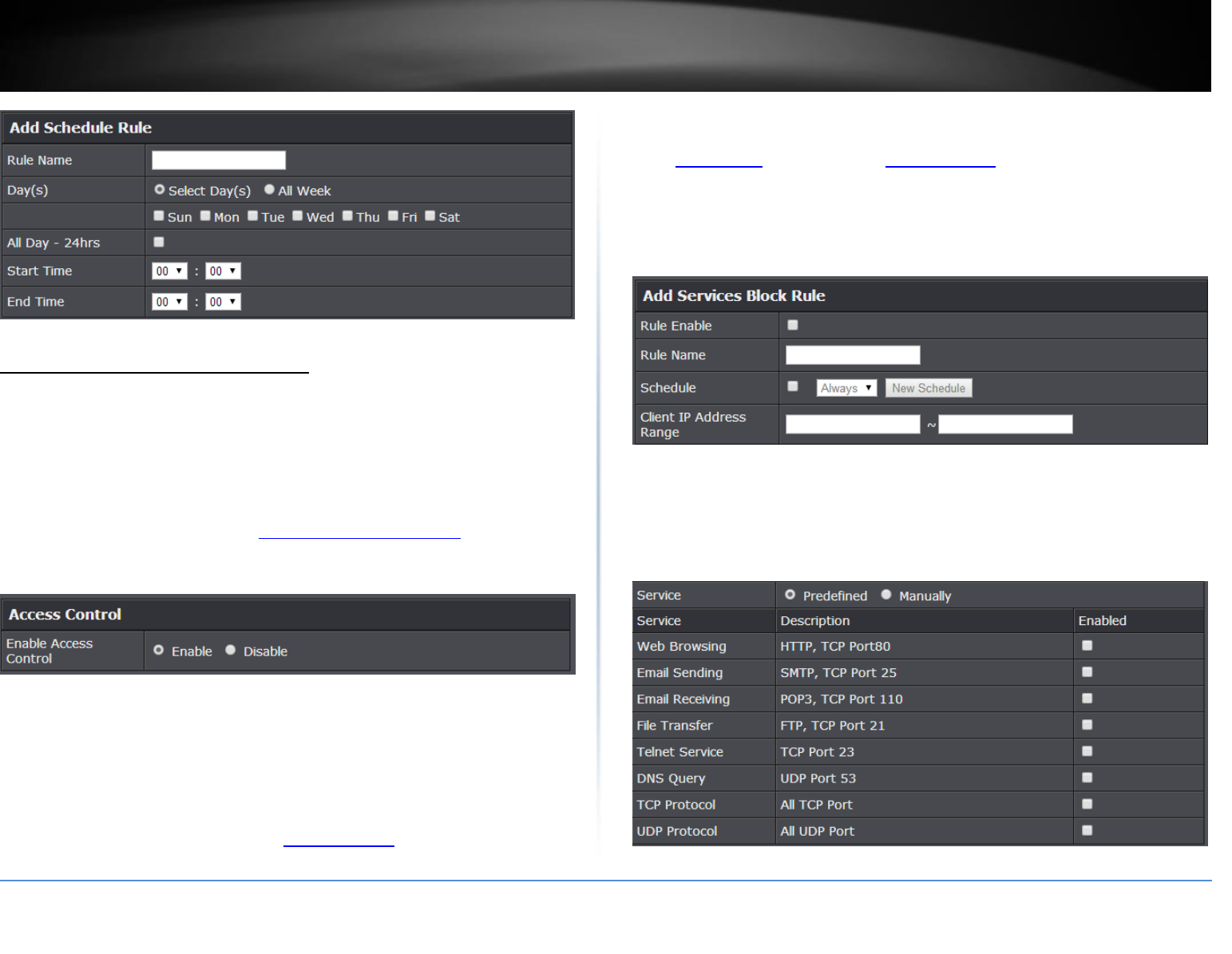
© Copyright 2015 TRENDnet. All Rights Reserved.
TRENDnet User’s Guide
TEW-817DTR
31
Access Control (IP Protocol Filter)
Advanced > Security > Access Control
You may want to block computers or devices on your network access to specific ports
(used or required by a specific application) to the Internet.
Block a specific service or multiple services
1. Log into the management page (see “Access your management page” on page 7).
2. Click on Advanced and click on Security, then click on Access Control.
3. Next to Enable Access Control, click the Enable option.
4. Review the Add Services Block Rule. Click Add to save the rule.
Rule Enable: Checking this option turns on the Protocol/IP Filter and unchecking
turns it off.
Rule Name: Enter a name for the Protocol/IP Filter.
Schedule (Optional): The schedule function allows you to define a schedule when
the access control filter should be turned on. T To define a new schedule, click
New Schedule and refer to page 30 “Create Schedules”. After you have created a
new schedule, click the drop-down list and the new schedule will be available for
selection. Note: Before applying scheduling, please ensure your Time settings are
configured correct and you have defined a schedule. See page 29 to configure
Time Settings and see page 30 “ Create Schedules” to create a schedule.
Client IP Address Range: Enter the IP address or IP address range to apply the
protocol/IP filter. (e.g. 192.168.10.20-192.168.10.20 or 192.168.10.20-
192.168.10.30).
Note: The filter will not be applied to IP addresses outside of the range
specified.
To simplify configuration, there is a list of commonly used pre-defined Protocol/IP Filters
to modify otherwise, you can choose to manually add a new Protocol/IP Filter.
Service: Select Predefined to select from the predefined services listed or select
Manually to specifically enter the TCP or UDP port number or port range
numbers to block. (e.g. 80-80 or 20-21).
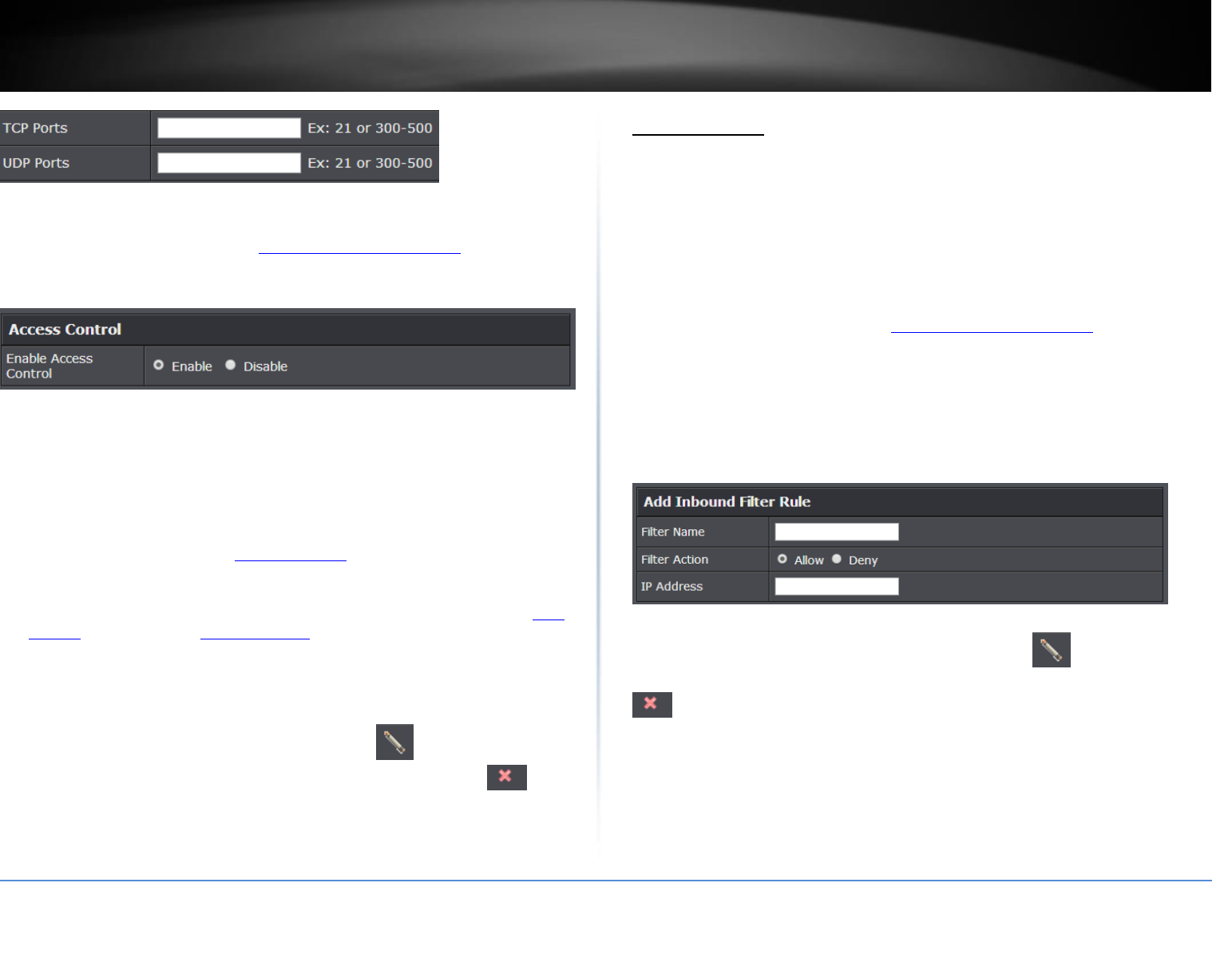
© Copyright 2015 TRENDnet. All Rights Reserved.
TRENDnet User’s Guide
TEW-817DTR
32
Block all services
1. Log into the management page (see “Access your management page” on page 7).
2. Click on Advanced and click on Security, then click on Access Control.
3. Next to Enable Access Control, click the Enable option.
4. Review the Add All Services Block Rule. Click Add to save the rule.
Rule Enable: Checking this option turns on the Protocol/IP Filter and unchecking
turns it off.
Rule Name: Enter a name for the Protocol/IP Filter.
Schedule (Optional): The schedule function allows you to define a schedule when
the access control filter should be turned on. To define a new schedule, click New
Schedule and refer to page 30 “Create Schedules”. After you have created a new
schedule, click the drop-down list and the new schedule will be available for
selection. Note: Before applying scheduling, please ensure your Time settings are
configured correct and you have defined a schedule. See page 29 to configure Time
Settings and see page 30 “Create Schedules” to create a schedule.
Client IP Address Range: Enter the IP address or IP address range to apply the
protocol/IP filter. (e.g. 192.168.10.20-192.168.10.20 or 192.168.10.20-
192.168.10.30).
Note: The filter will not be applied to IP addresses outside of the range specified.
Note: In the Block Rule List, you can edit a rule by clicking under the Edit column
next to the rule you would like to edit. You can also delete a rule by clicking under
the Delete column next to the rule you would like to delete.
Inbound Filter
Advanced > Security > Inbound Filter
Inbound Filters allows you to allow or deny a specific range of IP addresses. You can
create a predefined range of IP addresses to apply to a specific feature.
Note: You can apply a predefined inbound filter to the following features:
Virtual Server
Gaming
Remote Management
1. Log into the management page (see “Access your management page” on page 7).
2. Click on Access, and click on Inbound Filter.
3. Review the inbound filter settings. Click Add to save the Inbound Filter.
Filter Name: Enter a name for the IP address range.
Filter Action: Select Allow to allow the specified IP address range or Deny to deny
the specified IP address range.
IP Address: Enter the IP address (e.g. 192.168.1.20-192.168.1.30).
Note: In the Inbound Filter List, you can edit a rule by clicking under the Edit
column next to the rule you would like to edit. You can also delete a rule by clicking
under the Delete column next to the rule you would like to delete.
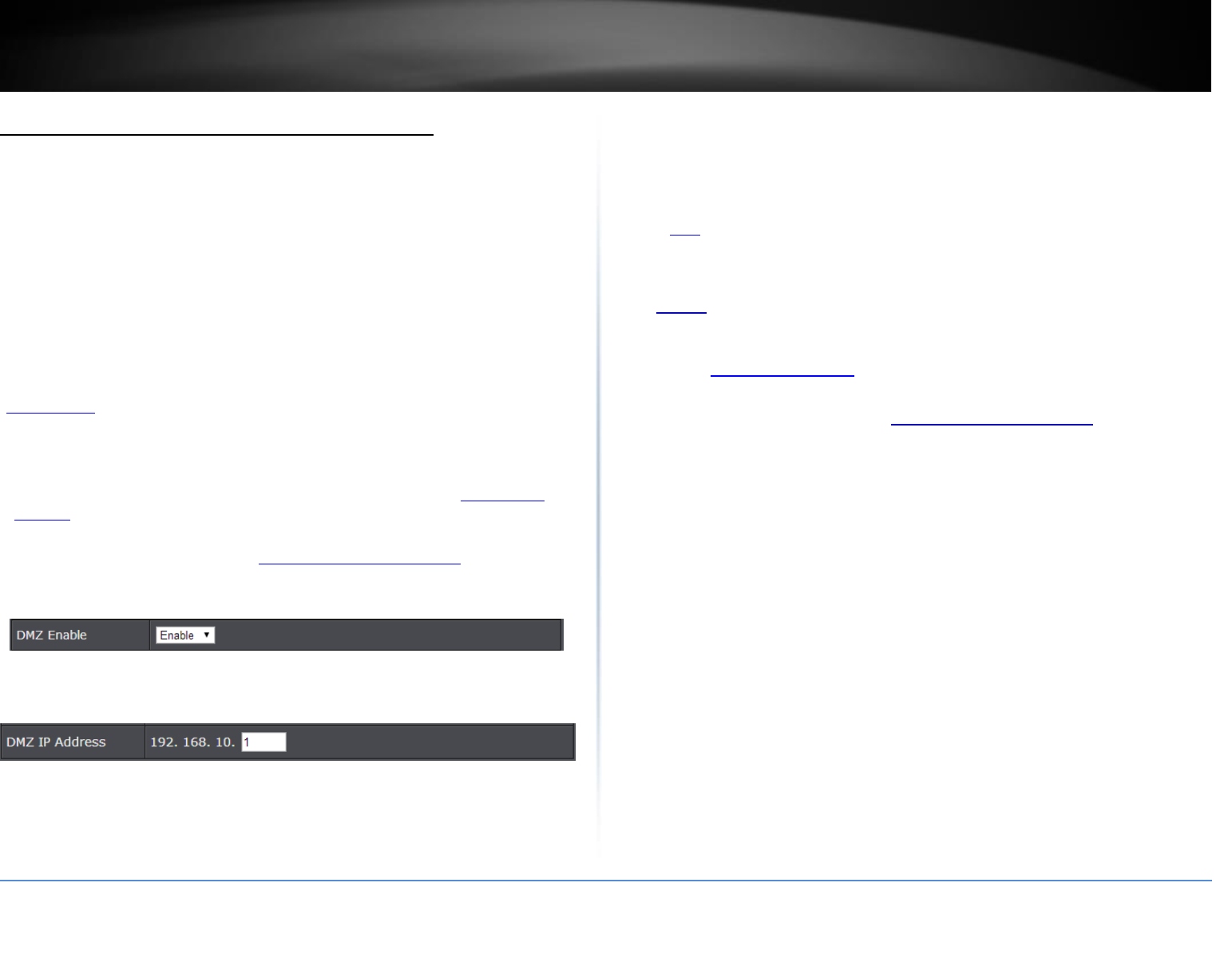
© Copyright 2015 TRENDnet. All Rights Reserved.
TRENDnet User’s Guide
TEW-817DTR
33
Open a device on your network to the Internet
This router can provide access to devices on your local area network to the Internet
using the Virtual Server, Special Application, method (DMZ NOT recommended).
DMZ
Advanced > Firewall > DMZ
You may want to expose a specific computer or device on your network to the Internet
to allow anyone to access it. Your router includes the DMZ (Demilitarized Zone) feature
that makes all the ports and services available on the WAN/Internet side of the router
and forwards them to a single IP address (computer or network device) on your
network. The DMZ feature is an easy way of allowing access from the Internet however,
it is a very insecure technology and will open local area network to greater threats from
Internet attacks.
It is strongly recommended to use Virtual Server (also called port forwarding, see
“Virtual Server” on page 33) to allow access to your computers or network devices from
the Internet.
1. Make the computer or network device (for which you are establishing a DMZ link) has
a static IP address. Signing up for a Dynamic DNS service (outlined in Identify Your
Network section page 29) will provide identification of the router’s network from the
Internet.
2. Log into the management page (see “Access your management page” on page 7).
3. Click on Advanced and click Firewall, then click on DMZ.
4. Click the DMZ Enable drop-down list, and select Enable.
5. Enter the IP address you assigned to the computer or network device to expose to the
Internet.
6. To save changes, click Apply.
Virtual Server
Advanced > Firewall > Virtual Server
Virtual Server (also called port forwarding) allows you to define specific ports (used or
required by a specific application) and forward them to a single IP address (a computer
or device) on your network. Using this feature is more secure compared to using DMZ
(see “DMZ” on page 33) in which DMZ forwards all ports instead of only specific ports
used by an application. An example would be forwarding a port to an IP camera
(TRENDnet IP cameras default to HTTP TCP port 80 for remote access web requests) on
your network to be able to view it over the Internet. To open several ports please refer
to “Gaming” section on page 35.
Since most ISPs constantly change your home IP address, to be able to access the Virtual
Server port(s) from the Internet it is recommended to setup Dynamic DNS service
(outlined in Identify Your Network section page 29).
1. Log into the management page (see “Access your management page” on page 7).
2. Click on Advanced and click on Firewall, then click on Virtual Server.
3. Review the virtual server settings. Click Add to save settings.
Check the option to the left most of the entry to enable and uncheck to disable.
Rule Enable: Check the option to enable the virtual server.
Rule Name: Enter a name for the virtual server.
IP Address: Enter the IP address of the device to forward the port (e.g.
192.168.10.101).
Protocol: Select the protocol required for your device. TCP, UDP, or Both (TCP
and UDP).
Public Port: Enter the port number used to access the device from the Internet.
Private Port: Enter the port number required by your device. Refer to the
connecting device’s documentation for reference to the network port(s) required.
Note: The Public Port can be assigned a different port number than the Private
Port (also known as port redirection), however it is recommended to use the same
port number for both settings. Please refer to the device documentation to
determine which ports and protocols are required. It is recommended to assign a
static IP address to the device or use DHCP reservation to ensure the IP address of
the device does not change.
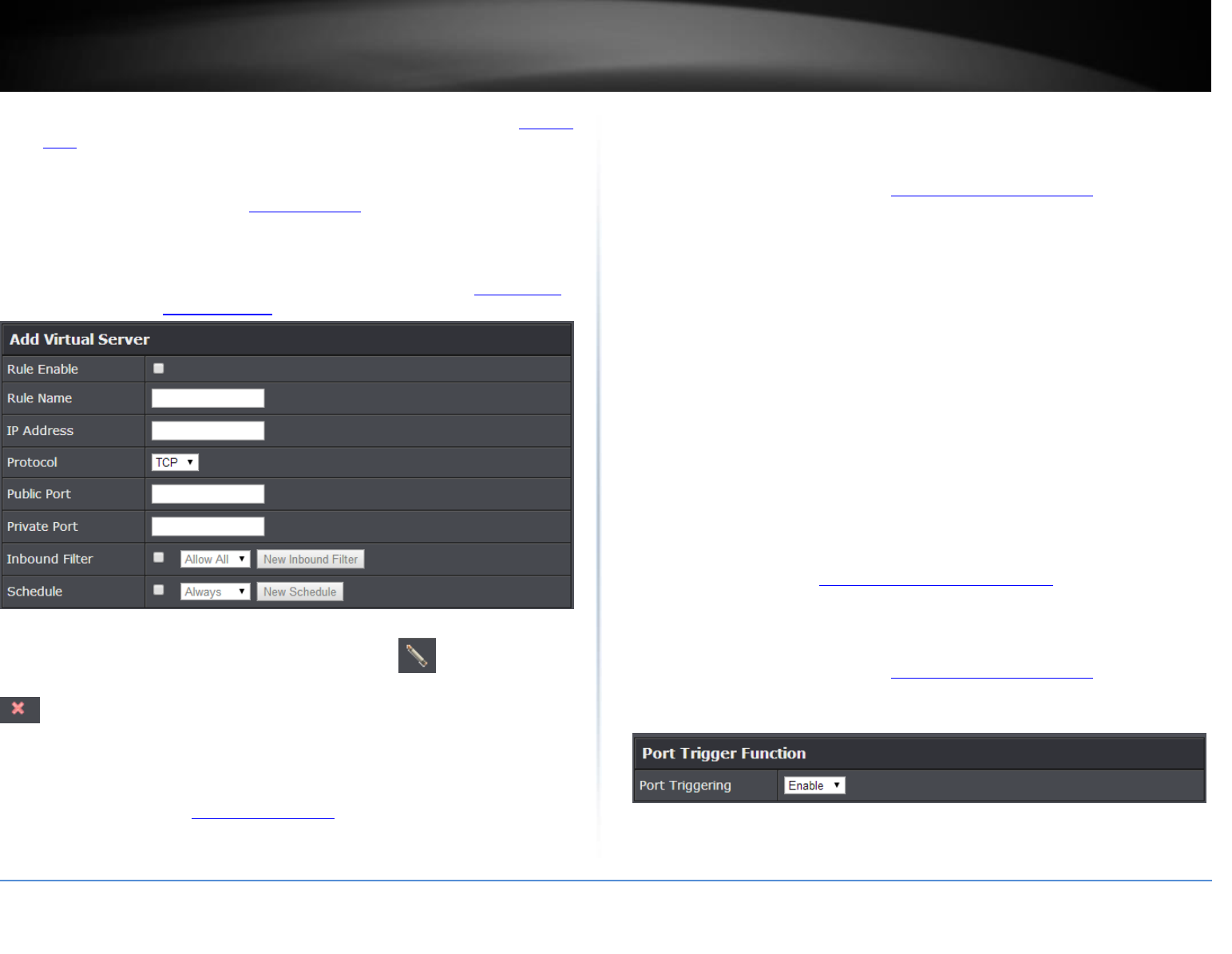
© Copyright 2015 TRENDnet. All Rights Reserved.
TRENDnet User’s Guide
TEW-817DTR
34
Inbound Filter: Select the defined IP address range to allow access. (see “Inbound
Filter” section on page 32).
Schedule (Optional): The schedule function allows you to define a schedule when
the virtual server should be turned on. To define a new schedule, click New
Schedule and refer to page 30 “Create Schedules”. After you have created a new
schedule, click the drop-down list and the new schedule will be available for
selection.
Note: Before applying scheduling, please ensure your Time settings are configured
correct and you have defined a schedule. See page 29 to configure Time Settings
and see page 30 “ Create Schedules” to create a schedule.
Note: In the Virtual Server List, you can edit a rule by clicking under the Edit
column next to the rule you would like to edit. You can also delete a rule by clicking
under the Delete column next to the rule you would like to delete.
Example: To forward TCP port 80 to your IP camera
1. Setup DynDNS service (see Identify Your Network section page 29).
2. Access TRENDnet IP Camera management page and forward Port 80 (see product
documentation)
3. Make sure to configure your network/IP camera to use a static IP address.
Note: You may need to reference your camera documentation on configuring a static IP
address.
4. Log into the management page (see “Access your management page” on page 7).
5. Click on Advanced and click on Firewall, then click on Virtual Server
6. Check the Rule Enable option to enable the Virtual Server.
7. Next to IP Address, enter the IP address assigned to the camera. (e.g. 192.168.10.101)
8. Next to Protocol, make sure TCP is selected in the drop-down list.
9. The Private Port and Public Port, enter port number 80 is configured for both
settings.
10. To save the changes, click Add.
Special Applications
Advanced > Firewall > Special Applications
Application rules (also called port triggering) is typically used for online gaming
applications or communication applications that require a range of ports or several
ports to be dynamically opened on request to a device on your network. The router will
wait for a request on a specific port or range of ports (or trigger port/port range) from a
device on your network and once a request is detected by your router, the router will
forward a single port or multiple ports (or incoming port/port range) to the device on
your network. This feature is not typically used as most devices and routers currently
use UPnP (Universal Plug and Play) to automatically configure your router to allow
access for applications. See “Enable/disable UPnP on your router” on page 28.
Note: Please refer to the device documentation to determine if your device supports
UPnP first, before configuring this feature.
1. Log into the management page (see “Access your management page” on page 7).
2. Click on Advanced and click on Firewall, then click on Special Applications.
3. Click the Port Triggering drop-down list, and select Enable. Then click Apply.
4. Review the application rule settings. Click Add to save settings.
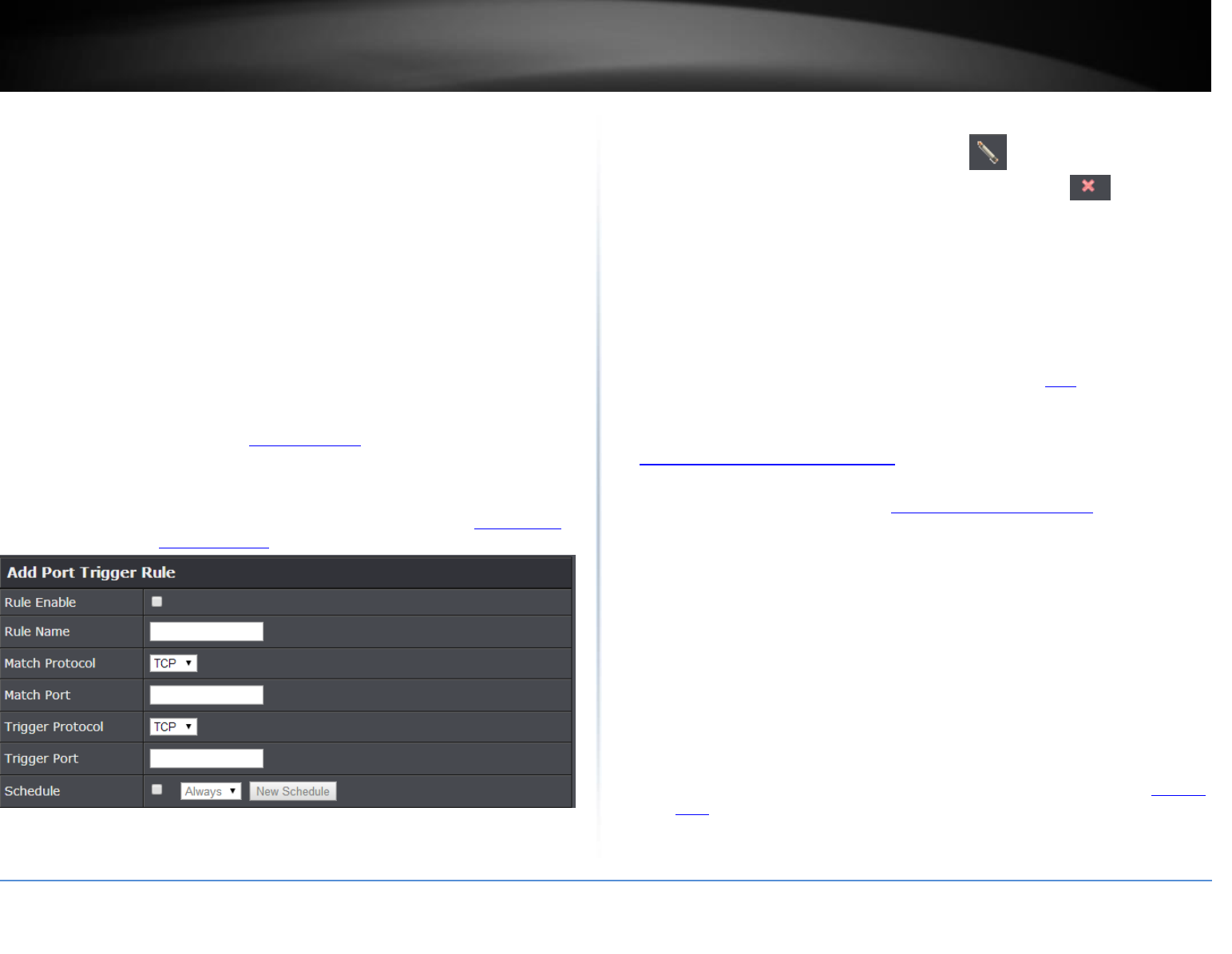
© Copyright 2015 TRENDnet. All Rights Reserved.
TRENDnet User’s Guide
TEW-817DTR
35
Check the option to the left most of the entry to enable and uncheck to disable.
Rule Enable: Check the option to enable the port trigger rule.
Rule Name: Enter a name for the port trigger rule.
IP Address: Enter the IP address of the device to forward the port (e.g.
192.168.10.101).
Match Protocol: Select the protocol for the firewall ports required for your
device. TCP, UDP, or Any (TCP and UDP).
Match Port: Enter the ports or port range to be forwarded to the device. (e.g.
2000-2038,2200-2210).
Trigger Protocol (Trigger): Select the trigger port protocol requested by the
device. TCP, UDP, or Any.
Trigger Port: Enter the port requested by the device. (e.g. 554-554 or 6112-6112).
Schedule (Optional): The schedule function allows you to define a schedule when
the port trigger should be turned on. To define a new schedule, click New
Schedule and refer to page 30 “Create Schedules”. After you have created a new
schedule, click the drop-down list and the new schedule will be available for
selection.
Note: Before applying scheduling, please ensure your Time settings are configured
correct and you have defined a schedule. See page 29 to configure Time Settings
and see page 30 “Create Schedules” to create a schedule.
Note: In the Rule List, you can edit a rule by clicking under the Edit column next to
the rule you would like to edit. You can also delete a rule by clicking under the
Delete column next to the rule you would like to delete.
Gaming
Advanced > Firewall > Gaming
Gaming allows you to define multiple ports (used or required by a specific application or
game) and forward them to a single IP address (a computer or device) on your network.
Using this feature is more secure compared to using DMZ (see “DMZ” on page 33) in
which DMZ forwards all ports instead of only specific ports used by an application. Since
most ISPs constantly change your home IP address, to be able to access the Virtual
Server port(s) from the Internet it is recommended to setup Dynamic DNS service (see
“Identify your network over the Internet” section on page 29).
1. Log into the management page (see “Access your management page” on page 7).
2. Click on Advanced and click on Security, then click on Gaming.
3. Review the virtual server settings. Click Apply to save settings.
Rule Enable: Check the option to enable the gaming rule.
Rule Name: Enter a name for the gaming rule.
IP Address: Enter the IP address of the device to forward the ports (e.g.
192.168.10.101).
TCP Ports to Open: Enter the TCP port you would like to set.
UDP Ports to Open: Enter the UDP port you would like to set.
Note: Please refer to the device documentation to determine which ports and
protocols are required. You should assign a static IP address to the device or
use DHCP reservation to ensure the IP address of the device does not change.
Inbound Filter: Select the defined IP address range to allow access. (see “Inbound
Filter” section on page 32).
Schedule (Optional): The schedule function allows you to define a schedule when
the gaming rule should be turned on. To define a new schedule, click New
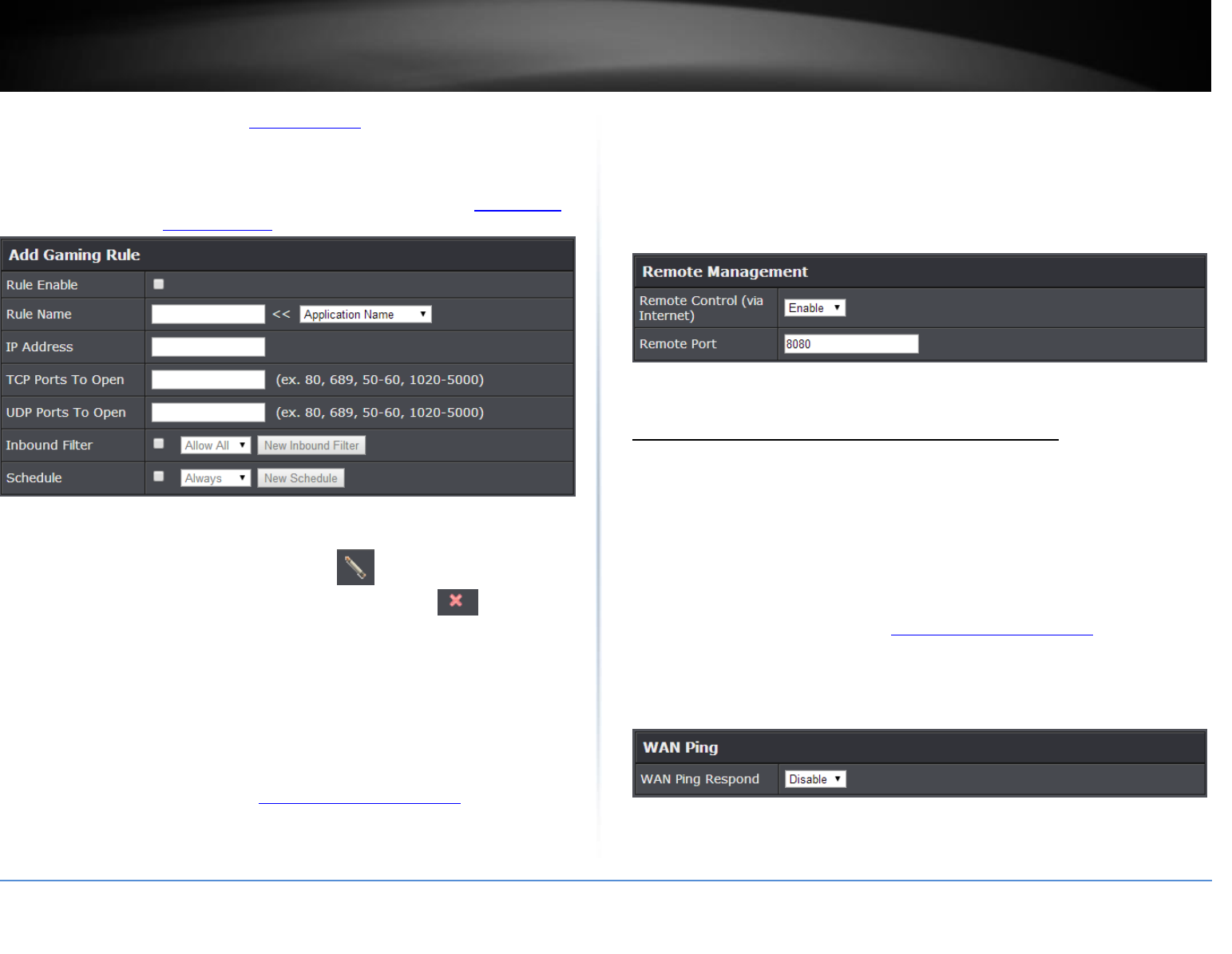
© Copyright 2015 TRENDnet. All Rights Reserved.
TRENDnet User’s Guide
TEW-817DTR
36
Schedule and refer to page 30 “Create Schedules”. After you have created a new
schedule, click the drop-down list and the new schedule will be available for
selection.
Note: Before applying scheduling, please ensure your Time settings are configured
correct and you have defined a schedule. See page 29 to configure Time Settings
and see page 30 “ Create Schedules” to create a schedule.
Note: In the Rule List, you can edit a rule by clicking under the Edit column next to
the rule you would like to edit. You can also delete a rule by clicking under the
Delete column next to the rule you would like to delete.
Allow remote access to your router management page
Advanced > Setup > Management
You may want to make changes to your router from a remote location such at your
office or another location while away from your home.
1. Log into the management page (see “Access your management page” on page 7).
2. Click on Advanced and click Setup, then click on Management.
3. Review the setting on the Remote Management section. Click Apply to save settings
Remote Control (via Internet): Click the drop-down list and select Enable to
enable remote management or Disable to disable remote management.
Remote Port: Enter the port to assign remote access to the router. It is
recommended to leave this setting as 8080.
Note: If you have configured port 8080 for another configuration section such as
virtual server or special application, please change the port to use.
(Recommended port range 1024-65534)
Allow/deny ping requests tofrom the Internet
Advanced > Administrator > Advanced Network
To provide additional security, you may want to disable your router from responding to
ping or ICMP (Internet Control Message Protocol) requests from the Internet. A ping is
network communication test to check if a device with IP address is alive or exists on the
network. By disabling this feature, you can conceal your router’s IP address and
existence on the Internet by denying responses to ping requests from the Internet. You
can additionally use this feature as a tool for troubleshooting purposes
1. Log into the management page (see “Access your management page” on page 7).
2. Click on Advanced and click on Administrator, then click on Advanced Network.
3. Next to WAN Ping, Click the WAN Ping Respond drop-down list and Enable to allow
your router to respond to ping requests from the Internet. You can also choose
Disable to block WAN ping requests from the Internet
4. To save changes, click Apply.
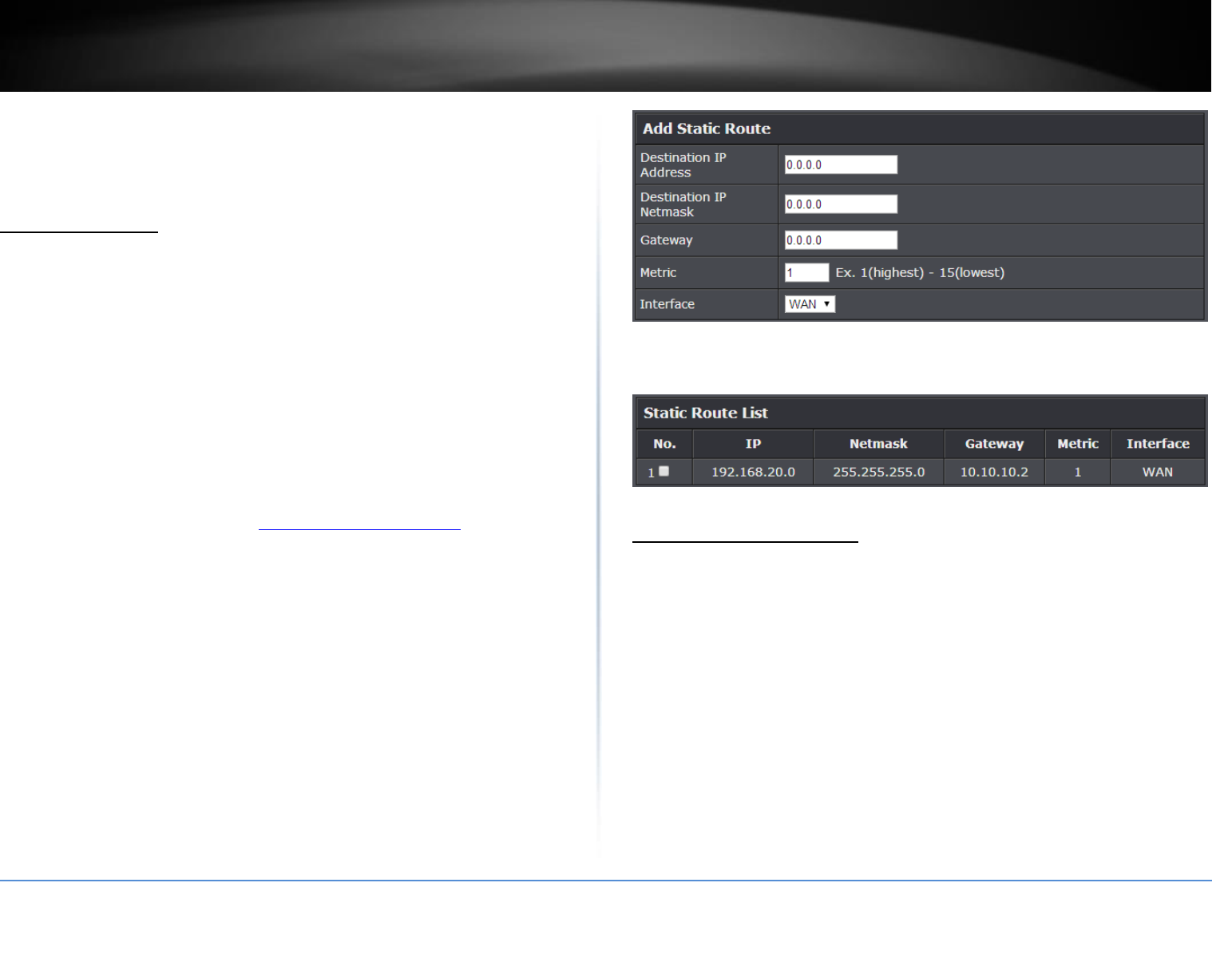
© Copyright 2015 TRENDnet. All Rights Reserved.
TRENDnet User’s Guide
TEW-817DTR
37
Add static routes
Advanced > Setup > Routing
You may want set up your router to route computers or devices on your network to
other local networks through other routers. Generally, different networks can be
determined by the IP addressing assigned to those networks. Generally speaking and for
the case of an example, your network may have 192.168.10.x IP addressing and another
network may have 192.168.20.x IP addressing and because the IP addressing of these
two networks are different, they are separate networks. In order to communicate
between the two separate networks, static routing needs to be configured. Below is an
example diagram where routing is needed for devices and computers on your network
to access the other network.
Note: Configuring this feature assumes that you have some general networking
knowledge.
1. Log into the management page (see “Access your management page” on page 7).
2. Click on Advanced and click on Setup, then click on Routing.
3. Review the Routing section. Click Add to save settings.
Destination IP Address: Enter the IP network address of the destination network
for the route. (e.g. 192.168.20.0)
Destination IP Netmask: Enter the subnet mask of the destination network for
the route.(e.g. 255.255.255.0)
Gateway: Enter the gateway to the destination network for the route.
(e.g. 192.168.10.2)
Metric: Enter the metric or priority of the route. The metric range is 1-15, the
lowest number 1 being the highest priority. (e.g. 1 )
Interface: Select the interface to assign the route.
When adding static routes, they will appear in the Static Route List. To delete a route,
check the box in the No. column to select which routes to delete, then click Delete.
Enable Dynamic Routing
Advanced > Setup > Routing
You may want set up your router to route computers or devices on your network to
other local networks through other routers. Generally, different networks can be
determined by the IP addressing assigned to those networks. Generally speaking and for
the case of an example, your network may have 192.168.10.x IP addressing and another
network may have 192.168.20.x IP addressing and because the IP addressing of these
two networks are different, they are separate networks. In order to communicate
between the two separate networks, static routing needs to be configured. Below is an
example diagram where routing is needed for devices and computers on your network
to access the other network. If you have other routing devices that support dynamic
routing protocol, you can enable these routing protocols on your router to learn and
automatically generate the routes needed between these networks.
Note: Configuring this feature assumes that you have some general networking
knowledge.
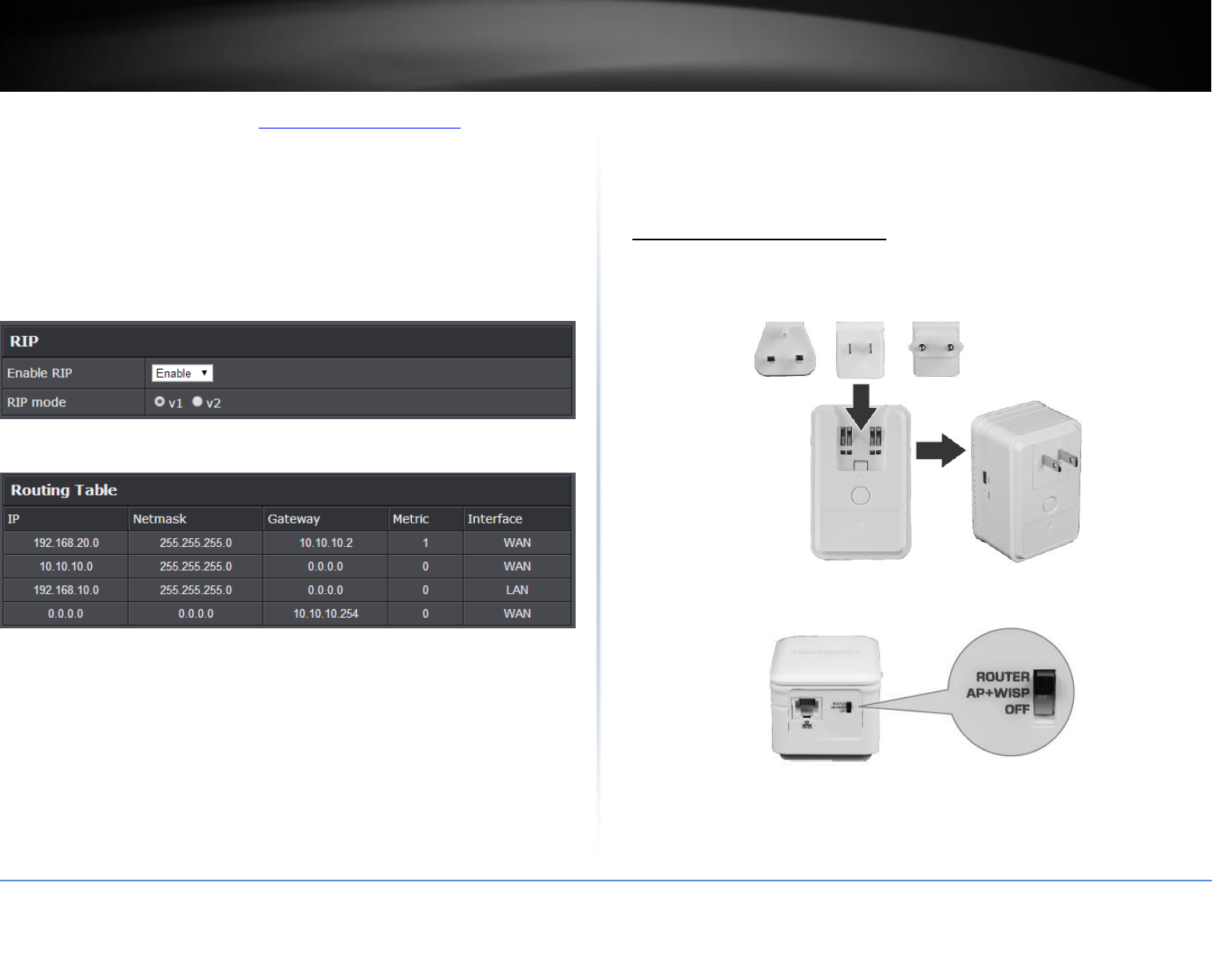
© Copyright 2015 TRENDnet. All Rights Reserved.
TRENDnet User’s Guide
TEW-817DTR
38
1. Log into the management page (see “Access your management page” on page 7).
2. Click on Advanced and click on Setup, then click on Routing.
3. Review the Routing section. Click Apply to save settings.
Enable RIP: Click the drop-down list to enable or disable RIP dynamic routing
protocol.
RIP mode: Depending on which RIP version dynamic routing protocols your other
routing devices support, click the appropriate version v1 or v2.
Note: If selecting RIP v2, this requires basic password authentication between
routing devices using this protocol. The password must match on all routing
devices connected in order successfully exchange routing information.
You can also view the current routing table under Routing Table.
AP/WISP Mode Setup
When the unit is switch to AP+WISP mode theTEW-817DTR can be configured as an
Access Point, client to your WISP connection or as a Repeater.
AP/WISP Mode Installation
1. Verify that you have an Internet connection when connecting your computer directly
to your router or WISP connection.
2. Attached the appropriate power adapter for your region.
3. Make sure the switch on the unit is set to AP + WISP mode.
4. Plug the TEW-817DTR into a power outlet.
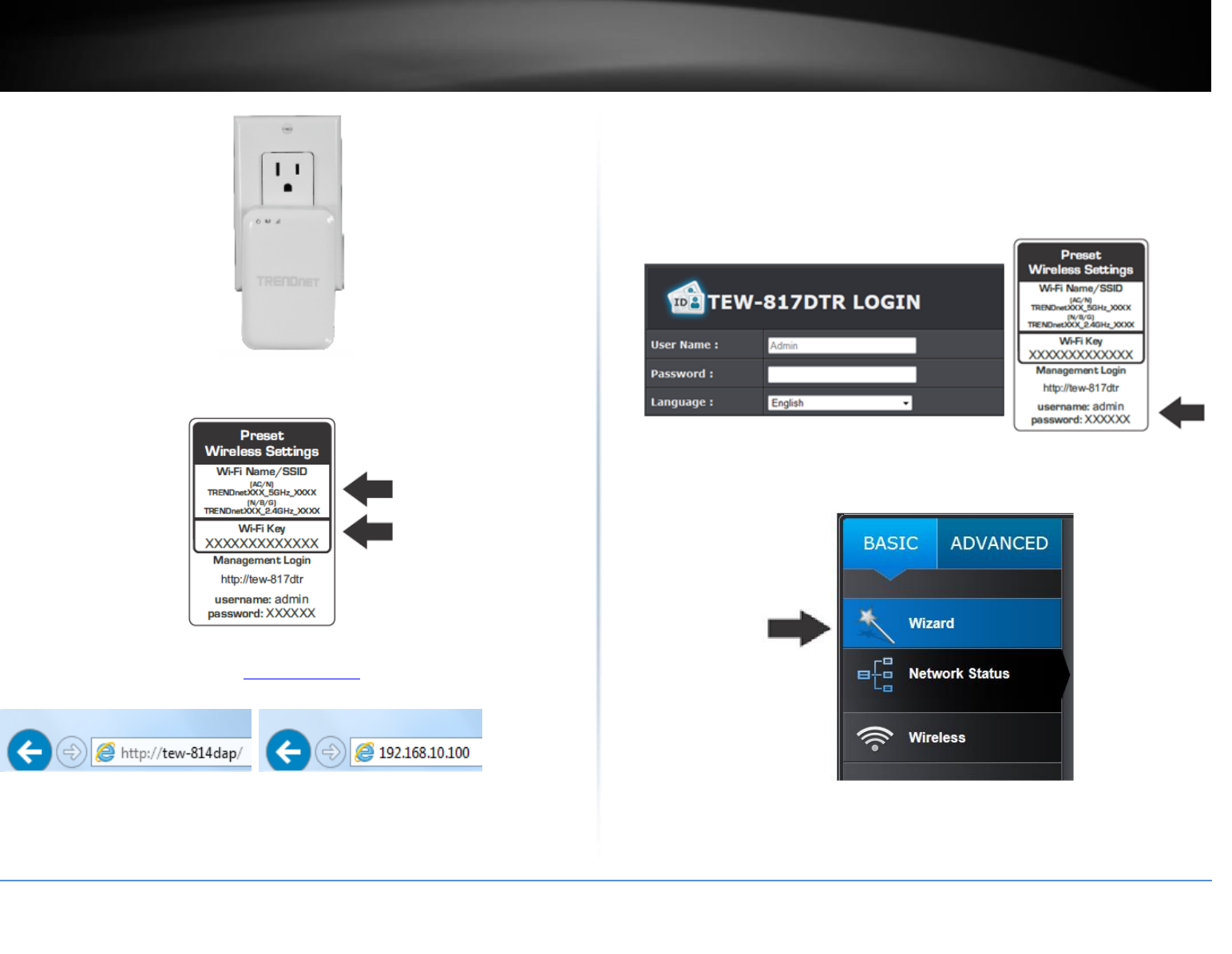
© Copyright 2015 TRENDnet. All Rights Reserved.
TRENDnet User’s Guide
TEW-817DTR
39
5. Connect your wireless computer to the TEW-817DTR’s wireless network.
6. When prompted, enter the WiFi password from the sticker on the device.
6. Open your web browser and enter http://tew-817dtr.
Note: You can also access the device using the default IP address (192.168.10.1)
7. For added security, the router is preconfigured with a unique password. You can find
the Password on a sticker on the side of the router and on the label on the bottom of
the router. Enter your Username and Password, select your language and then click
Login.
User Name: admin
Password: (xxxxxxxx)
Note: User Name and Password are case sensitive.
8. Once logged in the TEW-817DTR management page. Click the Wizard button on the
left hand side of the window to begin the installation wizard.
9. Select the mode you would like to set the TEW-817DTR and click Next.
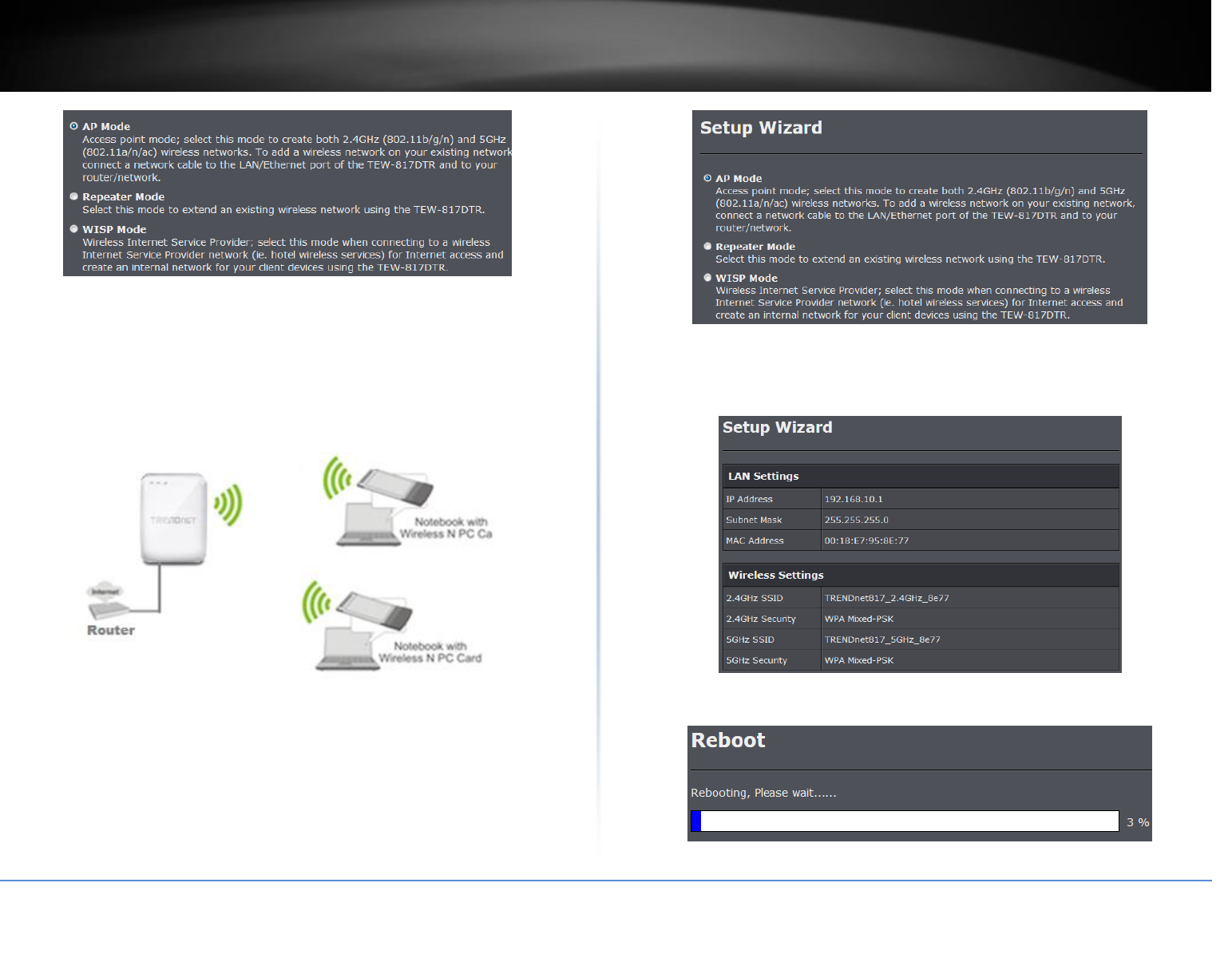
© Copyright 2015 TRENDnet. All Rights Reserved.
TRENDnet User’s Guide
TEW-817DTR
40
10. Follow the steps through the wizard to complete installation.
Access Point Mode
In Access Point mode, the TEW-817DTR serves as your wireless access point on your
typical network. This allows you to establish a wireless network in an existing wired only
network or expand an existing wireless network.
Setup Wizard
1. Once logged into the management page click Wizard on the left hand side of the
window.
2. Select AP Mode and click Next.
3. The TEW-817DTR comes preconfigured with wireless encryption. Verify your settings
and click Apply. To change your wireless settings refer to Wireless Settings in the next
section.
4. Wait for the settings to apply.
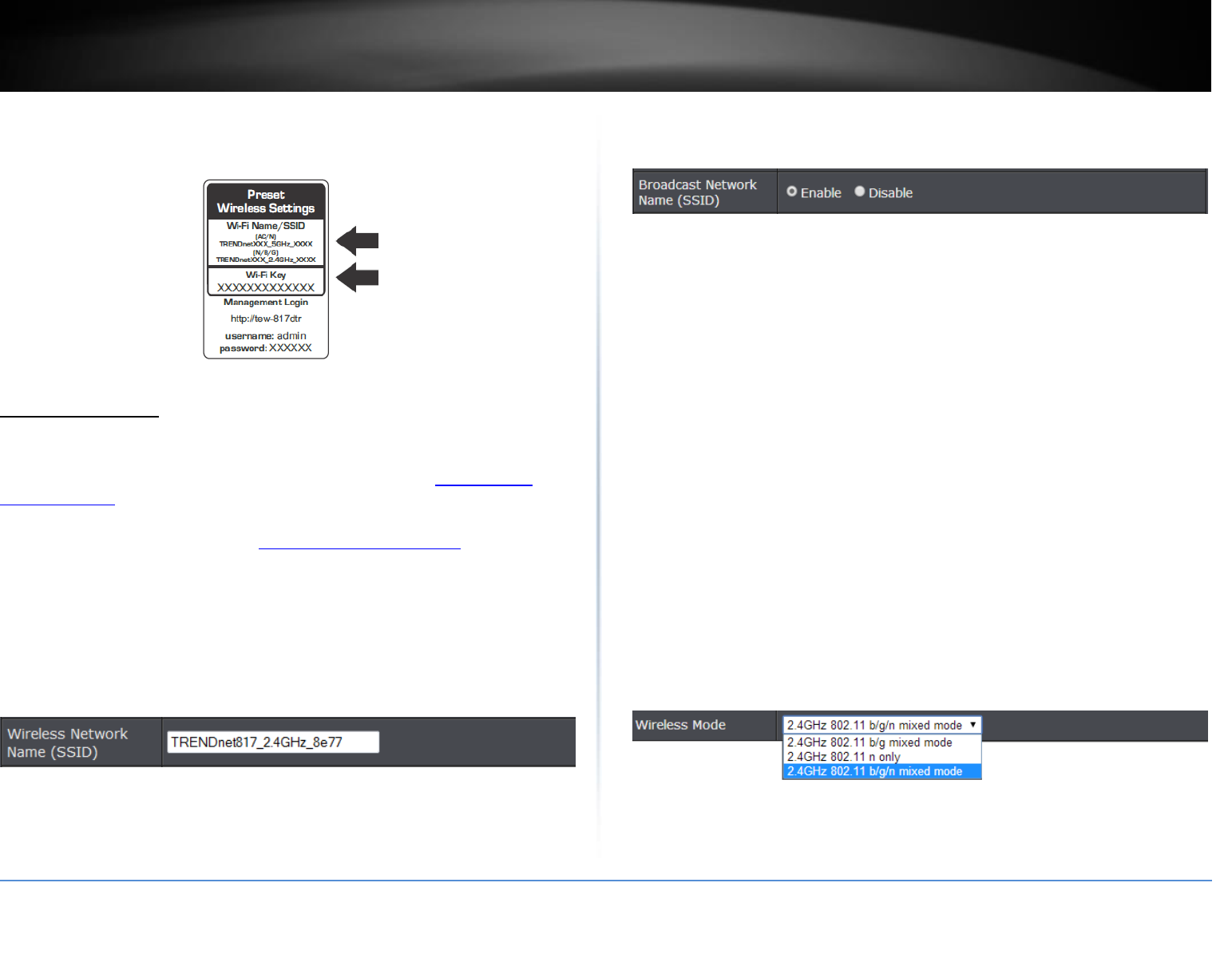
© Copyright 2015 TRENDnet. All Rights Reserved.
TRENDnet User’s Guide
TEW-817DTR
41
5. Wirelessly connect your devices using the default settings which can be found in the
wireless sticker on the front of the unit or the device label located in the back of the
unit.
Wireless Settings
Basic > Wireless (2.4GHz or 5GHz)
This section outlines available management options under basic wireless sub tab for
both 2.4GHz and 5GHz wireless sections. You can refer to the page 42 Secure your
Wireless Network to configure your wireless security settings.
1. Log into the management page (see “Access your management page” on page 7).
2. Click on Wireless and click on Basic scroll down to Wireless Network Settings (2.4GHz
or 5GHz)
3. To save changes to this section, click Apply when finished.
Wireless Network Name (SSID): Enter the wireless name (SSID) for your wireless
network. This acronym stands for Service Set Identifier and is the name of your
wireless network. It differentiates your wireless network from others around you.
By default, the router’s wireless name is unique to the device. If you choose to
change the SSID, change it to a name that you can easily remember.
Broadcast Network Name (SSID)
o Visible: Allows wireless devices to search and discover your wireless network
name (also called SSID) broadcasted by your router.
o Invisible: Turns off the ability for wireless devices to find your network. It is still
possible for wireless devices to be configured to connect to your wireless
network. Disabling this setting will disable WPS functionality.
Wireless Mode: When applying the Wireless Mode setting, please keep in mind the
following:
Wireless devices that support 802.11n are backwards compatible and can connect
wirelessly at 802.11g or 802.11b.
Wireless devices that support 802.11ac are backwards compatible and can connect
wirelessly at 802.11n or 802.11a.
Connecting at 802.11b or 802.11g will limit the capability of your 802.11n
supported wireless devices from obtaining higher performance and data rates.
Connecting at 802.11a or 802.11n will limit the capability of your 802.11ac
supported wireless devices from obtaining higher performance and data rates.
Allowing 802.11b or 802.11g devices to connect to an 802.11n capable wireless
network may degrade the wireless network performance below the higher
performance and data rates of 802.11n.
Allowing 802.11a or 802.11n devices to connect to an 802.11ac capable wireless
network may degrade the wireless network performance below the higher
performance and data rates of 802.11ac.
Wireless devices that only support 802.11n or 802.11a will not be able to connect
to a wireless network that is set to 802.11ac only mode.
Wireless devices that only support 802.11b or 802.11g will not be able to connect
to a wireless network that is set to 802.11n only mode.
Wireless devices that only support 802.11b will not be able to connect to a wireless
network that is set to 802.11g only mode.
Wireless devices that only support 802.11a will not be able to connect to a wireless
network that is set to 802.11n only mode.
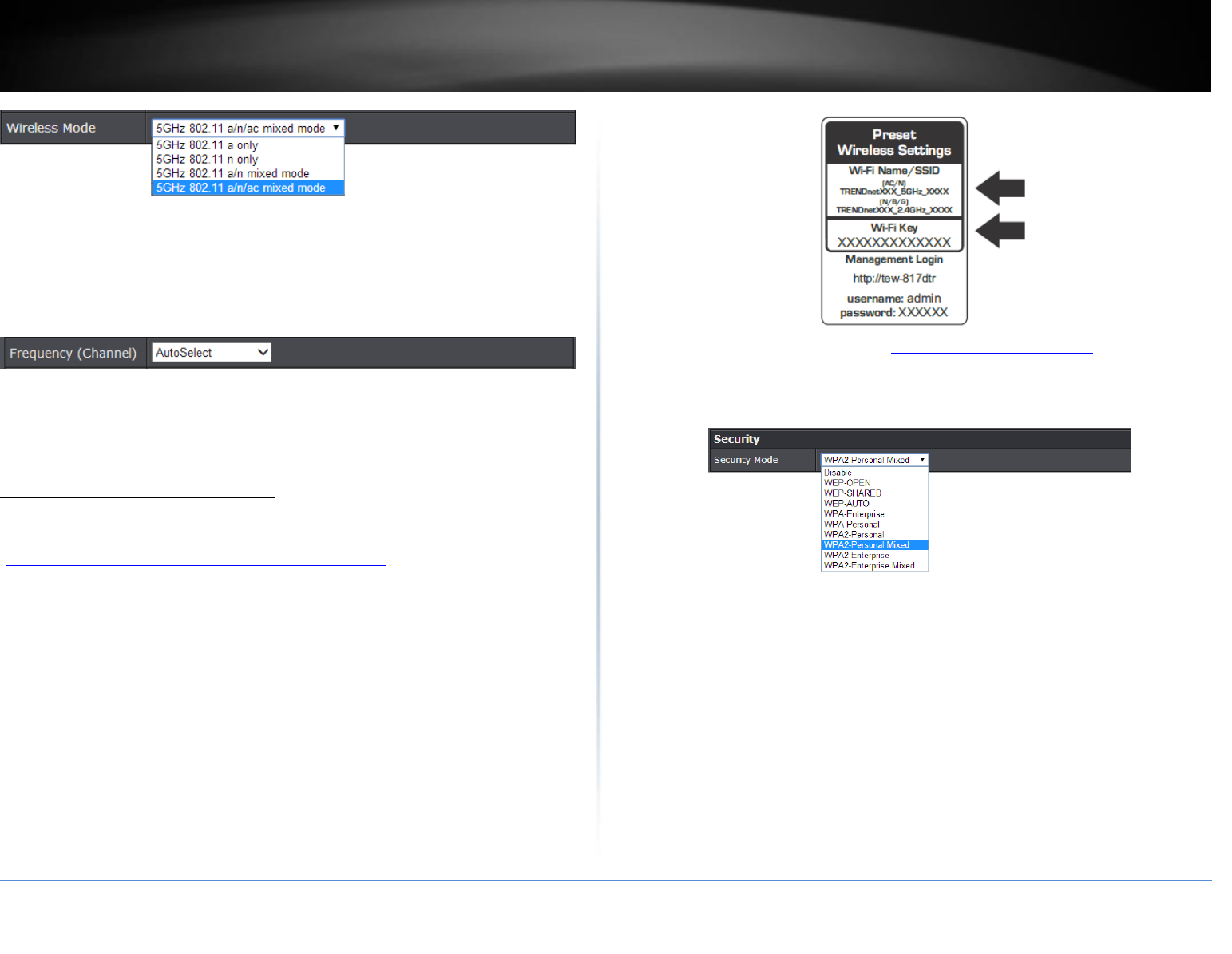
© Copyright 2015 TRENDnet. All Rights Reserved.
TRENDnet User’s Guide
TEW-817DTR
42
Enable Auto Channel Scan – Check this option to set your router to scan for which
wireless channels to use automatically.
Frequency (Channel) – Selecting the Auto option will set your router to scan for the
appropriate wireless channel to use automatically. Click the drop-down list and
select the desired Channel for wireless communication. The goal is to select the
Channel that is least used by neighboring wireless networks.
Wireless Networking and Security
Secure your wireless network
Basic > Wireless
After you have determined which security type to use for your wireless network (see
“How to choose the security type for your wireless network” on page 9), you can set up
wireless security.
Note: By default, your router is configured with a predefined wireless network name
(SSID) and security key using WPA2-Personal. The predefined wireless network name and
security can be found on the sticker on the side of the router or on the device label at the
bottom of the router.
1. Log into the management page (see “Access your management page” on page 7).
2. Click on Basic, and click on Wireless.
3. Under Security, click on the Security Mode drop-down list to select your wireless
security type.
Selecting WEP:
If selecting WEP (Wired Equivalent Privacy), please review the WEP settings to configure
and click Apply to save the changes.
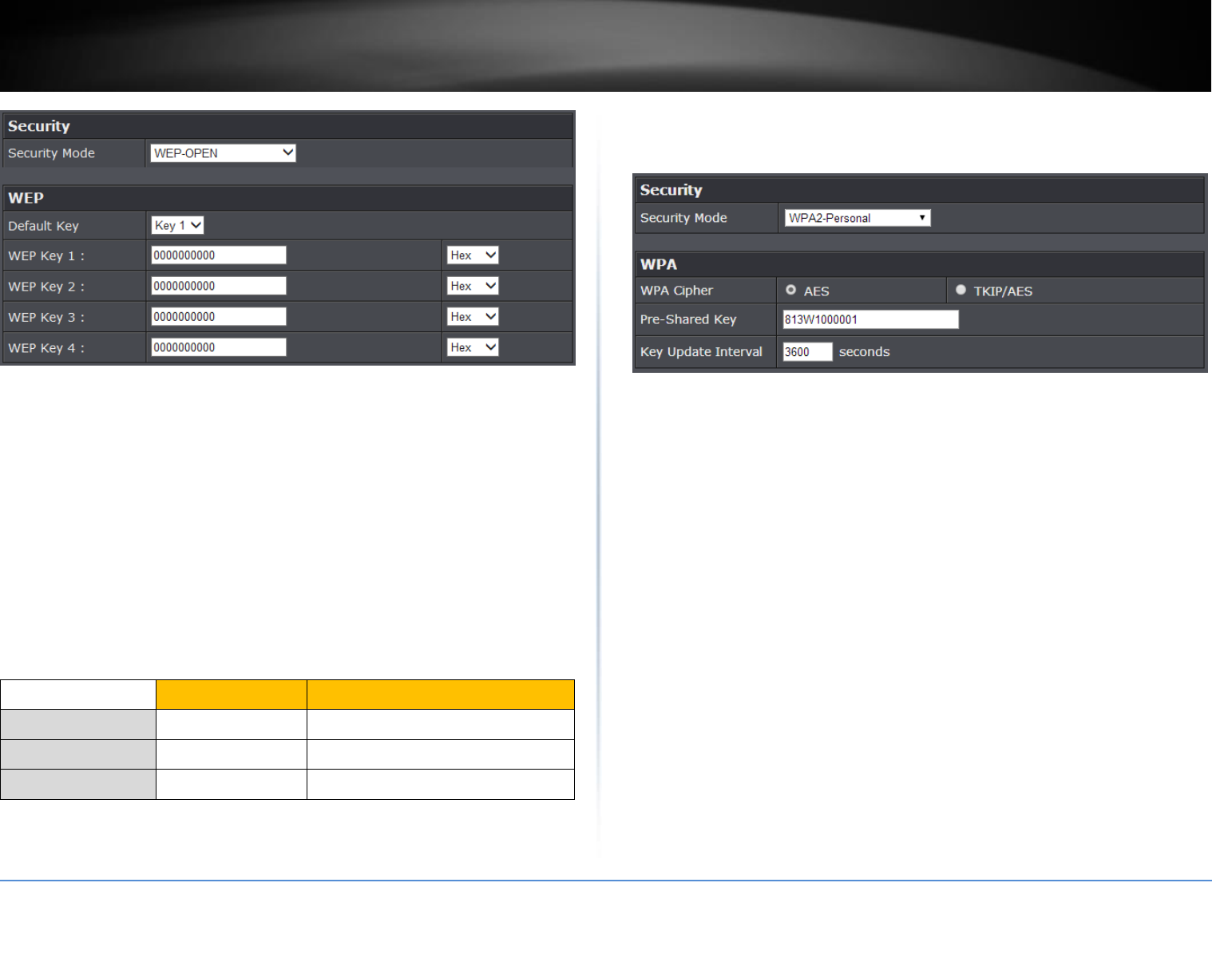
© Copyright 2015 TRENDnet. All Rights Reserved.
TRENDnet User’s Guide
TEW-817DTR
43
Security Mode: Choose WEP-OPEN, WEP-SHARED, or WEP-AUTO.
Note: It is recommended to use Open since it is known to be more secure than
Shared Key.
Default Key: Choose the key index to use for security to the corresponding WEP
Keys 1-4. You can only use one key at any given time.
Note: Please note that they wireless client key index 1-4 should also match the key
index chosen here in order to establish connection.
WEP Key 1-4: Enter the WEP key. This is the password or key that is used to
connect your computer to this router wirelessly. You can enter 64-bit or 128-bit
key. You can enter up to four keys but only the one chosen as the Default Key will
be used.
Note: It is recommended to use 128-bit because it is more secure to use a key that
consists of more characters.
Hex/ASCII: Enter the WEP key format. See the table below for the acceptable
characters and lengths for each format.
Selecting WPA-Personal / WPA2-Personal / WPA2-Personal Mixed
(WPA2-Personal recommended):
In the Security Mode drop-down list, select WPA-Personal, WPA2-Personal, or WPA2-
Personal Mixed. Please review the WPA-Personal settings to configure and click Apply
to save the changes.
The following section outlines options when selecting WPA-Personal, WPA2-Personal,
or WPA2-Personal Mixed (Preshared Key),
WPA Cipher: Select a Cipher Type to use.
o When selecting WPA2-Personal Mixed security, it is recommended to use
TKIP/AES.
o When selecting WPA2-Personal security, it is recommended to use AES.
WPA Pre-Shared Key: Enter the passphrase.
o This is the password or key that is used to connect your computer to this router
wirelessly
Key Format: 8-63 alphanumeric characters (a,b,C,?,*, /,1,2, etc.)
Key Update Interval: Enter the time interval (seconds) of when the network
passphrase will rotate.
Note: It is recommended to use the default interval time. Your passphrase will not
change, rotation of the key is part of the WPA protocol and designed to increase
security.
WEP Key Format
HEX
ASCII
Character set
0-9 & A-F, a-f only
Alphanumeric (a,b,C,?,*, /,1,2, etc.)
64-bit key length
10 characters
5 characters
128-bit key length
26 characters
13 characters
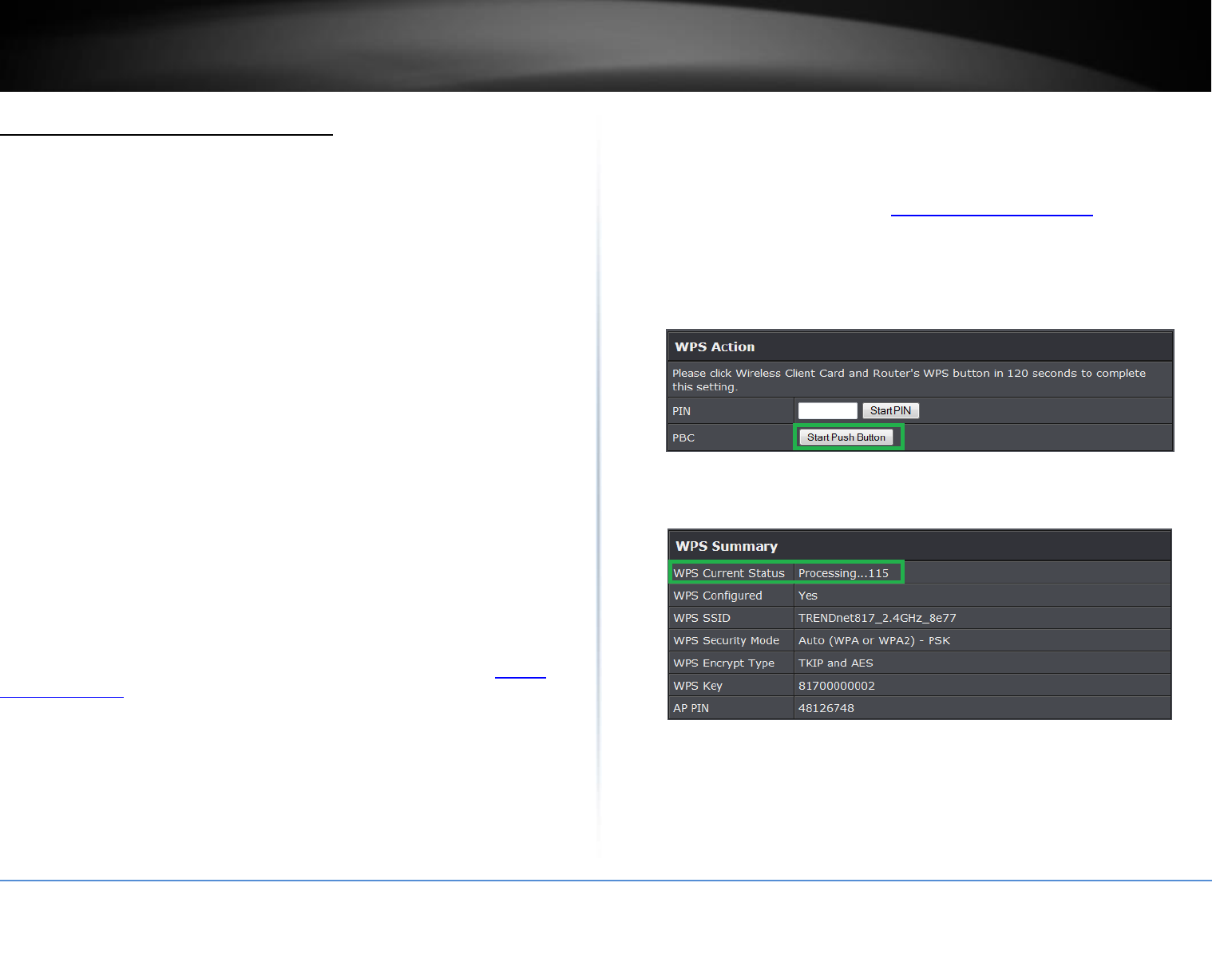
© Copyright 2015 TRENDnet. All Rights Reserved.
TRENDnet User’s Guide
TEW-817DTR
44
Connect wireless devices using WPS
WPS (Wi-Fi Protected Setup) is a feature that makes it easy to connect devices to your
wireless network. If your wireless devices support WPS, you can use this feature to
easily add wireless devices to your network.
Note: You will not be able to use WPS if you set the SSID Broadcast setting to Disabled or
if you are using WEP security.
There are two methods the WPS feature can easily connect your wireless devices to
your network.
Push Button Configuration (PBC) method
o (RECOMMENDED) Hardware Push Button method–with an external button
located physically on your router and on your client device
o WPS Software/Virtual Push Button - located in router management page
PIN (Personal Identification Number) Method - located in router management page
Note: Refer to your wireless device documentation for details on the operation of
WPS.
Recommended Hardware Push Button (PBC) Method
Note: It is recommended that a wireless key (passphrase or password) is created
before connecting clients using the PBC method. By default your router is
preconfigured with a wireless encryption key. If no wireless key is defined when
connecting via PBC, the router will automatically create an encryption key that is 64
characters long. This 64 character key will then have to be used if one has to
connect computers to the router using the traditional connection method.
To add a wireless device to your network, simply push the WPS button on the wireless
device you are connecting (consult client device User’s Guide for length of time), then
push and hold the WPS button located on your router for 3 seconds and release it. The
WPS LED will blink to indicate WPS has been activated on your router. (See “Product
Hardware Features” on page 2)
For connecting additional WPS supported devices, repeat this process for each
additional device.
PBC (Software/Virtual Push Button)
Advanced > Wireless (2.4GHz or 5GHz) > WPS
In addition to the hardware push button located physically on your router, the router
management page also has push button which is a software or virtual push button you
can click to activate WPS on your router.
1. Log into the management page (see “Access your management page” on page 7).
2. Click on Advanced, then click on Wireless (2.4GHz or 5GHz), and click on WPS.
3. To add a wireless device to your network, next to Virtual Push Button, click the Start
Push Button button in the router management page. Then push the WPS button on the
wireless device (consult wireless device’s User’s Guide for length of time) you are
connecting.
4. Wait for your router to finsh the WPS process.
Note: You should a message on your WPS client device indicating WPS was successful.
PIN (Personal Identification Number)
Advanced > Wireless (2.4GHz or 5GHz) > WPS
If your wireless device has WPS PIN (typically an 8-digit code printed on the wireless
device product label or located in the wireless device wireless software utility), you can
use this method.
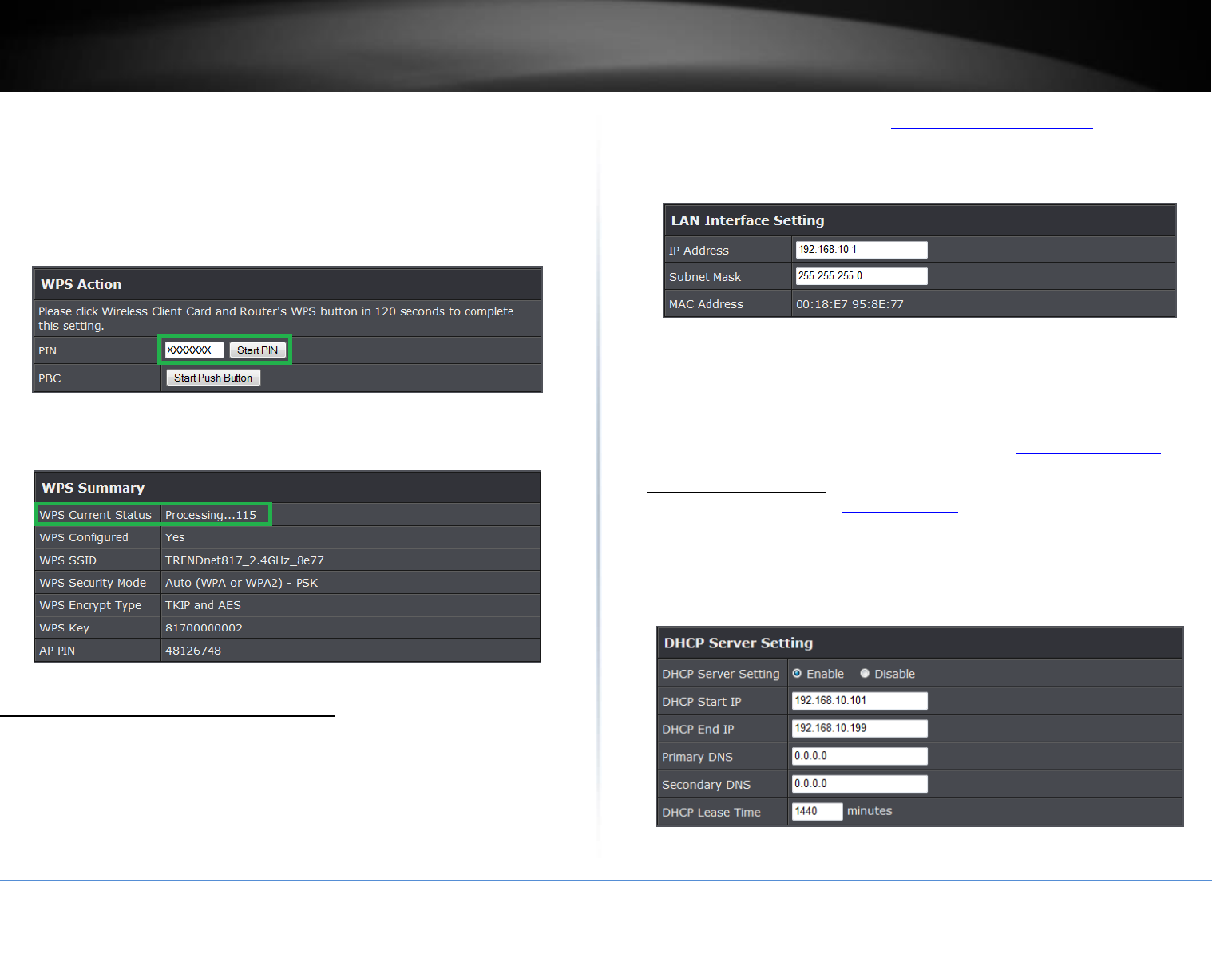
© Copyright 2015 TRENDnet. All Rights Reserved.
TRENDnet User’s Guide
TEW-817DTR
45
1. Log into the management page (see “Access your management page” on page 7).
2. Click on Wireless, and click on Wi-Fi Protected Setup.
3. To add a wireless device to your network, next to Client, enter the 8-digit numeric PIN
number of the wireless client device and click Start PIN. Note: You may need to initiate
the WPS PIN on your wireless device first when using this method. Refer to your wireless
device documentation for details on the operation of WPS.
4. Wait for your router to finsh the WPS process.
Note: You should a message on your WPS client device indicating WPS was successful.
Change your access point IP address
Setup > LAN Settings
Typically, the access point IP address settings only needs to be changed when
connecting the access point to your network and configuring to the device to be in the
same IP network as your existing network.
Default Access Point IP Address Settings: 192.168.10.100 / 255.255.255.0
1. Log into the management page (see “Access your management page” on page 7).
2. Click on Main, and click on Network Settings.
3. Under Connection Type, click the drop-down list to select the access point IP address
settings.
IP Address: Enter the new access point IP address. (e.g. 192.168.0.100)
Subnet Mask: Enter the new access point subnet mask. (e.g. 255.255.255.0)
4. To save changes, click Apply.
Note: You will need to access your access point management page using your new
access point IP address. (e.g. Instead of using the default http://192.168.10.100 your
new access point IP address will use the following format using your new IP address
http://(new.ipaddress.here) to access your access point management page. You can
also use the default login URL http://tew-817dtr
Your access point can be used as a DHCP (Dynamic Host Configuration Protocol) server
to automatically assign an IP address to each wireless device connected. The DHCP
server settings can be accessed when access point is set to Static IP address and it is
disabled by default
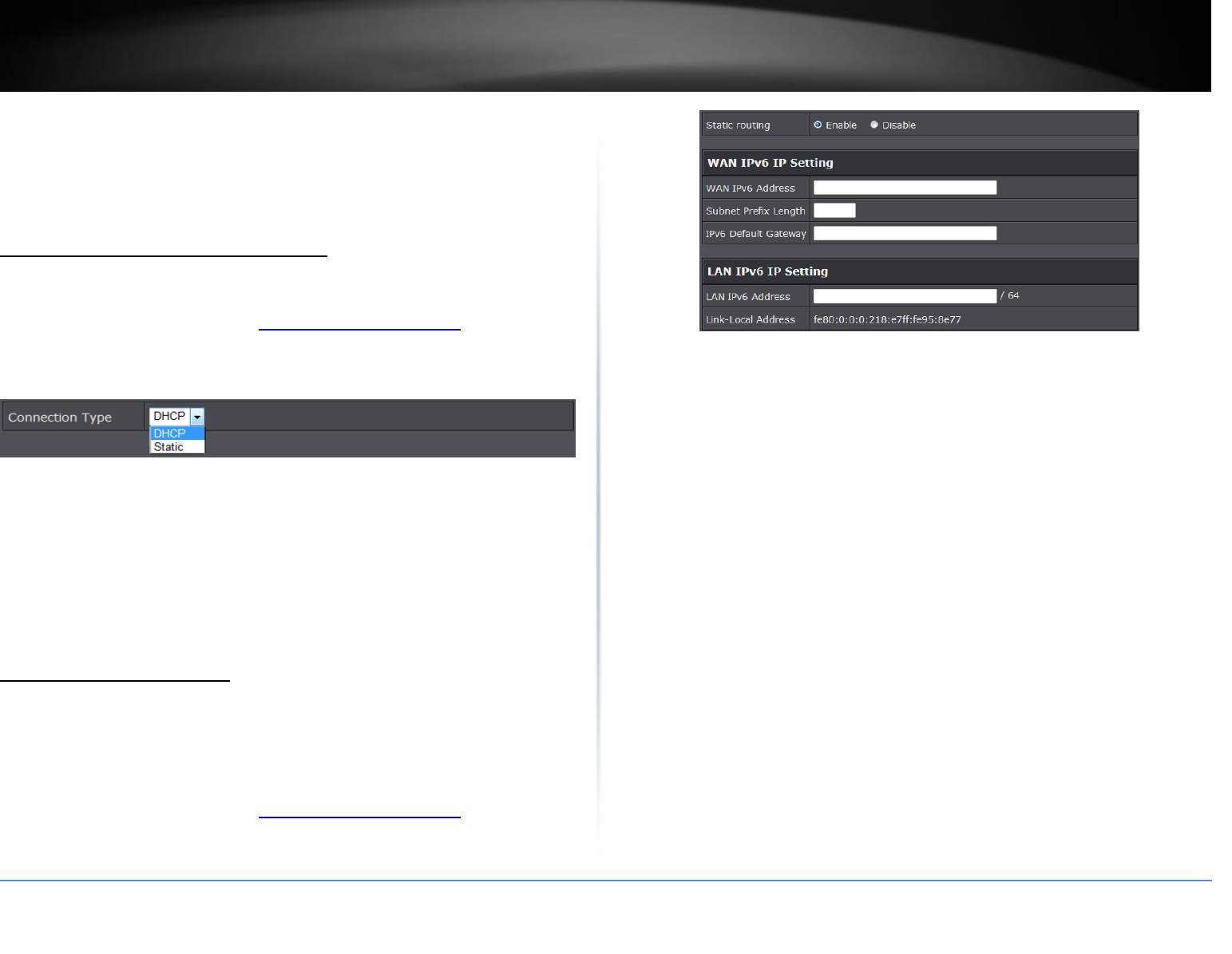
© Copyright 2015 TRENDnet. All Rights Reserved.
TRENDnet User’s Guide
TEW-817DTR
46
Enable DHCP Server: Select to enable DHCP server.
DHCP Start IP: Enter the starting DHCP IP address to assign.
DHCP End IP: Enter the ending DHCP IP address to assign.
Primary/Secondary DNS: Assign DNS IP address to use
DHCP Lease Time: Select the DHCP lease time allowed.
Configure your Internet connection
Advanced > Setup > Internet Settings
1. Log into the management page (see “Access your management page” on page 7).
2. Click on Advanced and click on Setup, then click on Internet Settings.
3. Under Connection Type in drop-down list, select the type of connection type the
device is connected to.
DHCP: Select to this option to have the device automatically obtain DHCP IP
address from the connected network.
Static: Select this option to manually assign an IP address from the connected
network.
4. To save changes, click Apply.
Note: If you are unsure which Internet connection type you are using, please contact
your network administrator.
IPv6 Connection Settings
Advanced > Setup IPv6 Settings
IPv6 (Internet Protocol Version 6) is a new protocol that significantly increases the
number of available Internet public IP addresses due to the 128-bit IP address structure
versus IPv4 32-bit address structure.
1. Log into the management page (see “Access your management page” on page 7).
2. Click on Main, and click on IPv6.
3. Select the IPv6 connection type to assign IPv6 addressing to the access point.
Static Routing: Select enable to configure IPv6 settings.
WAN IP Setting: Manually enter your assigned WAN IPv6 settings
LAN IPv6 Setting: Manually enter the device’s LAN setting.
4. To save changes, click Apply.
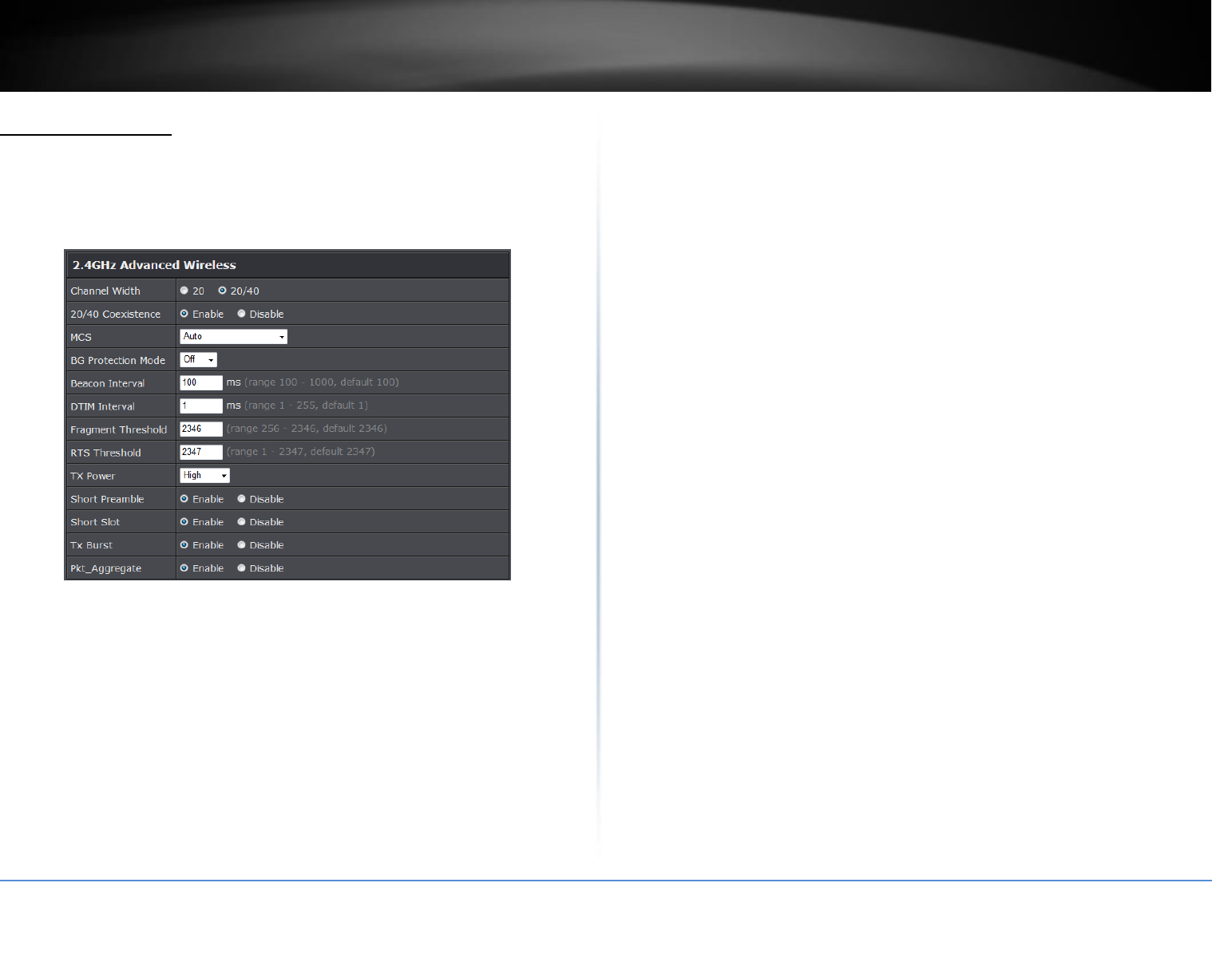
© Copyright 2015 TRENDnet. All Rights Reserved.
TRENDnet User’s Guide
TEW-817DTR
47
Advanced Settings
Advanced > Wireless (2.4GHz or 5GHz) > Advanced
These settings are advanced options that can be configured to change advanced
wireless broadcast specifications. It is recommended that these settings remain set to
their default values unless you are knowledgeable about the effects of changing these
values. Changing these settings incorrectly can degrade performance.
20/40 Coexistence (2.4GHz only): 20/40 MHz Coexistence allows for the auto-
fallback from 40MHz to 20MHz channel width operation when neighboring 802.11
wireless networks are detected.
MCS: Allows you to lock down the wireless transmission rate.
BG Protection:
Beacon Period: A beacon is a management frame used in wireless networks that
transmitted periodically to announce the presence and provide information about
the router’s wireless network. The interval is the amount time between each
beacon transmission. Default Value: 100 milliseconds (range: 100-1000)
DTIM: A DTIM is a countdown informing clients of the next window for listening to
broadcast and multicast messages. When the wireless router has buffered
broadcast or multicast messages for associated clients, it sends the next DTIM with
a DTIM Interval value. Wireless clients detect the beacons and awaken to receive
the broadcast and multicast messages. The default value is 1. Valid settings are
between 1 and 255.
Fragment Threshold: Wireless frames can be divided into smaller units (fragments)
to improve performance in the presence of RF interference and at the limits of RF
coverage. Fragmentation will occur when frame size in bytes is greater than the
Fragmentation Threshold. This setting should remain at its default value of 2346
bytes. Setting the Fragmentation value too low may result in poor performance.
RTS Threshold: The Request To Send (RTS) function is part of the networking
protocol. A wireless device that needs to send data will send a RTS before sending
the data in question. The destination wireless device will send a response called
Clear to Send (CTS). The RTS Threshold defines the smallest data packet size
allowed to initiate the RTS/CTS function. Default Value: 2347 (range: 1-2347)
TX Power: This setting allows you to adjust the wireless transmit power to a lower
setting. In busy wireless environments, lowering the transmit power may improve
better performance and connectivity and decrease interference with neighboring
wireless networks.
Short Preamble: Using a short preamble can potentially increase throughput as the
transfer time is 96 microseconds versus the more commonly used long preamble
192 microseconds. However, using a short preamble is not supported using 802.11b
legacy devices, in some cases cause wireless interoperability issues, and increase
the error rate in some installations. The preamble is the info. sent from the wireless
transmitter to the receiver indicating when data is incoming.
Short Slot: Short Slot Override defines the amount of time a device waits after a
data frame collision before retransmitting the data. Reducing the time from 20
microseconds (standard) to 9 microseconds can potentially increase throughput
however, can also increase the error rate.
Tx Burst:
Pkt_Aggregate:
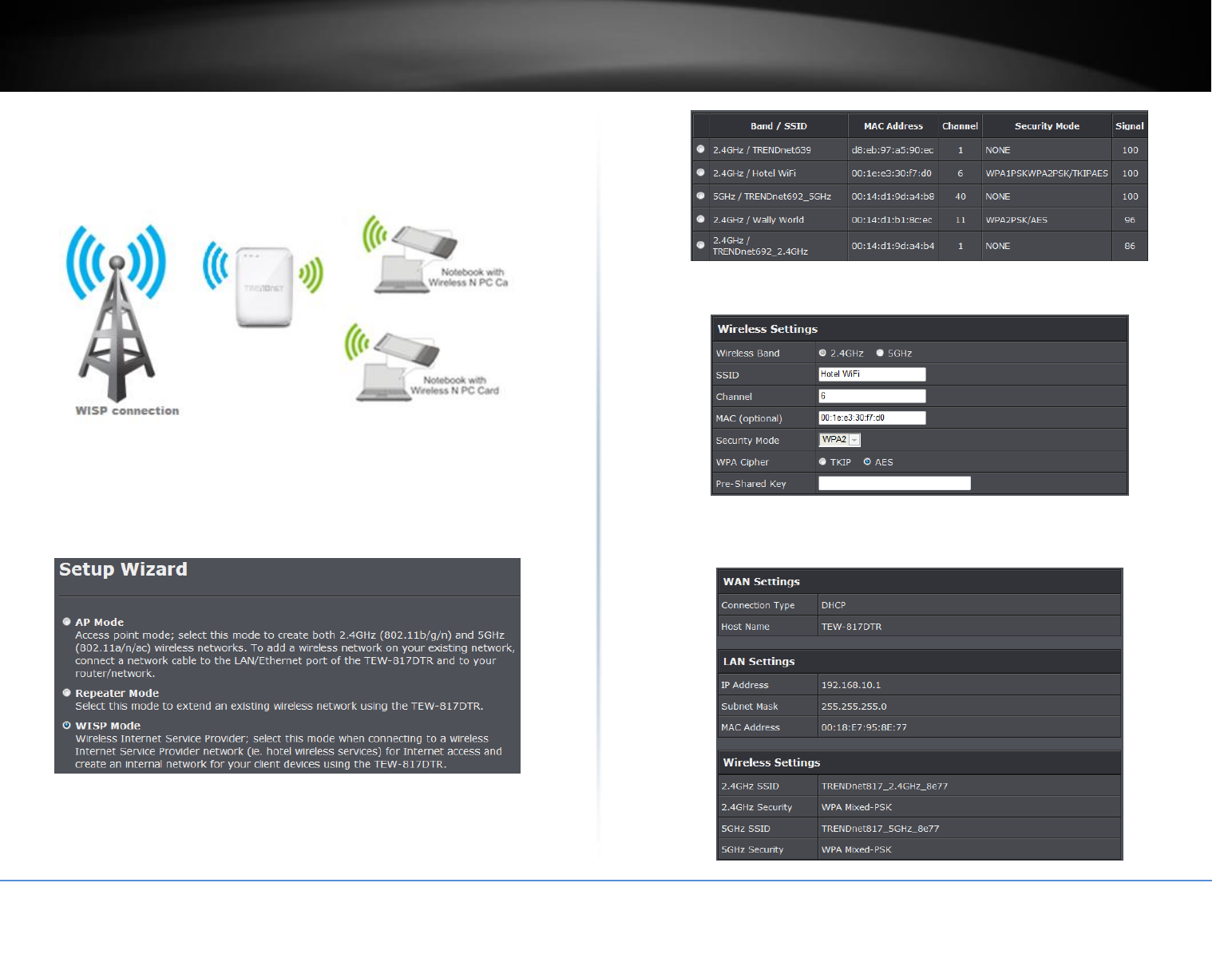
© Copyright 2015 TRENDnet. All Rights Reserved.
TRENDnet User’s Guide
TEW-817DTR
48
WISP Mode
In WISP (Wireless Internet Service Provider) mode, the TEW-817DTR creates your
network (wired and wireless) while connecting to your wireless internet service. Please
note that the TEW-817DTR does not support captive portal services.
Setup Wizard
1. Once logged into the management page click Wizard on the left hand side of the
window.
2. Select WISP Mode and click Next.
3. Select your WISP network and click Next. Please contact your network admin if you
uncertain which network to connect to.
3. Enter the wireless security settings provided by your network admin and click Next.
4. Verify your settings and click Apply. To change your wireless settings, refer to
Wireless Settings in this section.
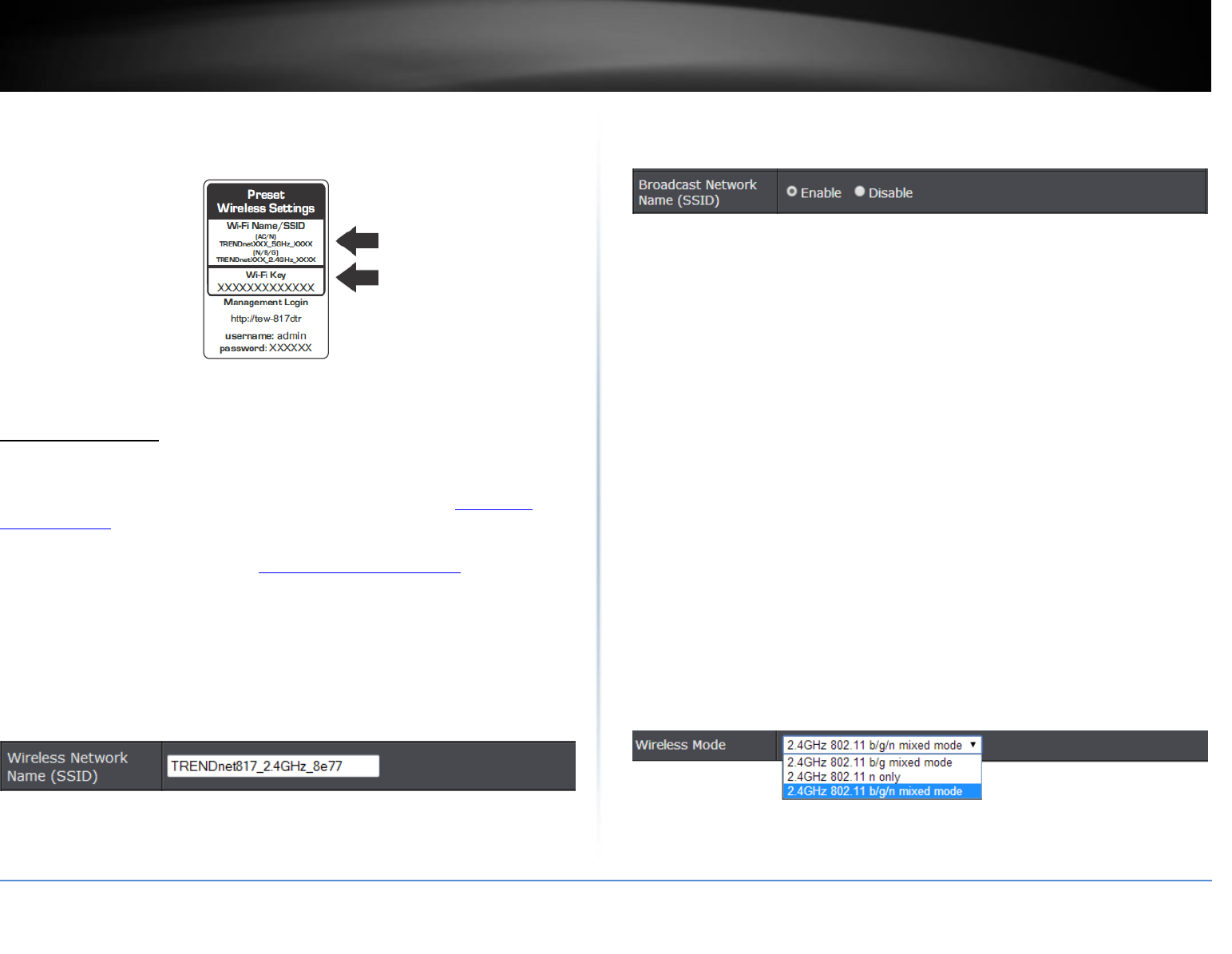
© Copyright 2015 TRENDnet. All Rights Reserved.
TRENDnet User’s Guide
TEW-817DTR
49
5. Wirelessly connect your devices using the default settings which can be found in the
wireless sticker on the front of the unit or the device label located in the back of the
unit. You can also plug a device using the Ethernet port of the TEW-817DTR.
Wireless Settings
Basic > Wireless (2.4GHz or 5GHz)
This section outlines available management options under basic wireless sub tab for
both 2.4GHz and 5GHz wireless sections. You can refer to the page 51 Secure your
wireless network to configure your wireless security settings.
1. Log into the management page (see “Access your management page” on page 7).
2. Click on Wireless and click on Basic scroll down to Wireless Network Settings (2.4GHz
or 5GHz)
3. To save changes to this section, click Apply when finished.
Wireless Network Name (SSID): Enter the wireless name (SSID) for your wireless
network. This acronym stands for Service Set Identifier and is the name of your
wireless network. It differentiates your wireless network from others around you.
By default, the router’s wireless name is unique to the device. If you choose to
change the SSID, change it to a name that you can easily remember.
Broadcast Network Name (SSID)
o Visible: Allows wireless devices to search and discover your wireless network
name (also called SSID) broadcasted by your router.
o Invisible: Turns off the ability for wireless devices to find your network. It is still
possible for wireless devices to be configured to connect to your wireless
network. Disabling this setting will disable WPS functionality.
Wireless Mode: When applying the Wireless Mode setting, please keep in mind the
following:
Wireless devices that support 802.11n are backwards compatible and can connect
wirelessly at 802.11g or 802.11b.
Wireless devices that support 802.11ac are backwards compatible and can connect
wirelessly at 802.11n or 802.11a.
Connecting at 802.11b or 802.11g will limit the capability of your 802.11n
supported wireless devices from obtaining higher performance and data rates.
Connecting at 802.11a or 802.11n will limit the capability of your 802.11ac
supported wireless devices from obtaining higher performance and data rates.
Allowing 802.11b or 802.11g devices to connect to an 802.11n capable wireless
network may degrade the wireless network performance below the higher
performance and data rates of 802.11n.
Allowing 802.11a or 802.11n devices to connect to an 802.11ac capable wireless
network may degrade the wireless network performance below the higher
performance and data rates of 802.11ac.
Wireless devices that only support 802.11n or 802.11a will not be able to connect
to a wireless network that is set to 802.11ac only mode.
Wireless devices that only support 802.11b or 802.11g will not be able to connect
to a wireless network that is set to 802.11n only mode.
Wireless devices that only support 802.11b will not be able to connect to a wireless
network that is set to 802.11g only mode.
Wireless devices that only support 802.11a will not be able to connect to a wireless
network that is set to 802.11n only mode.
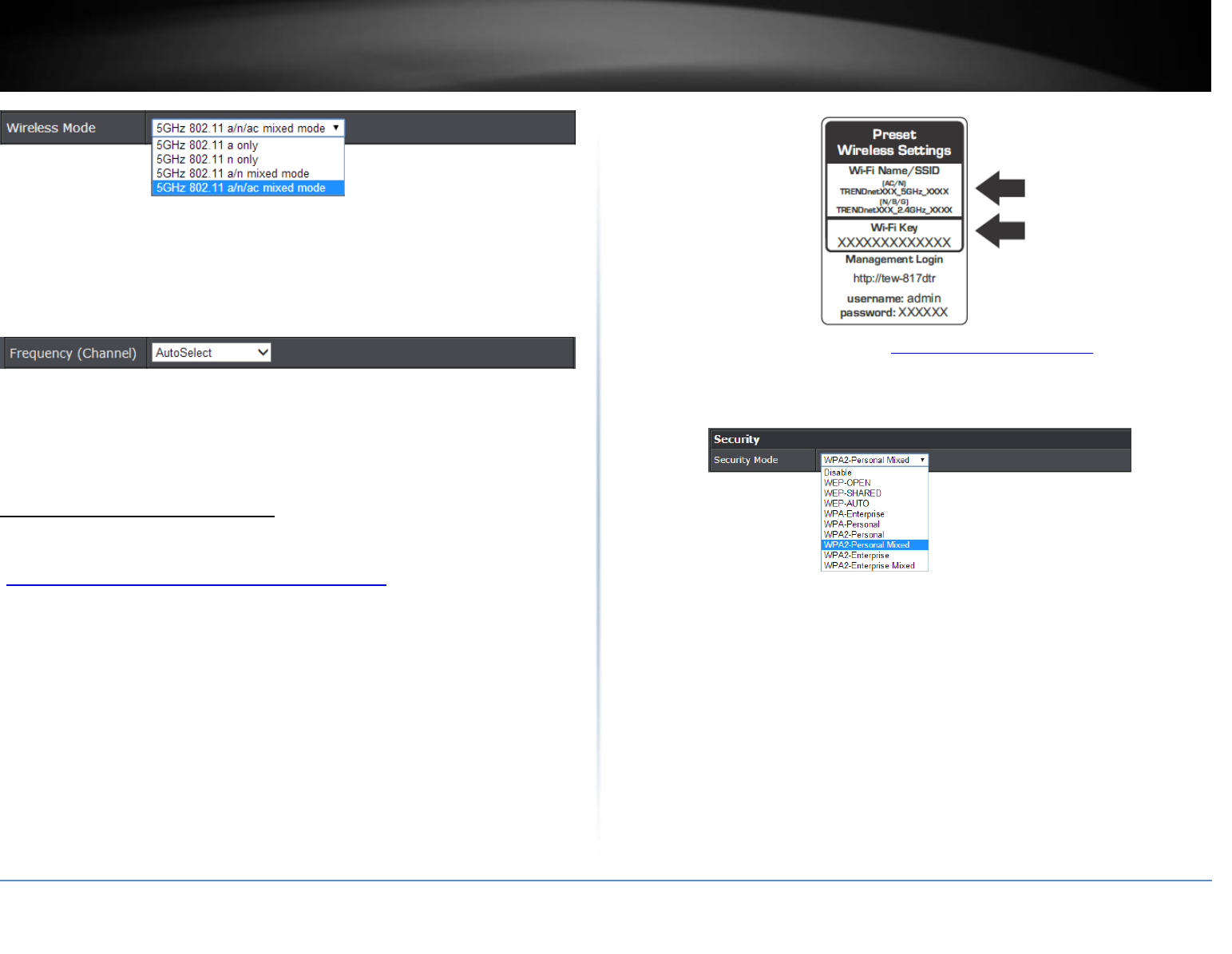
© Copyright 2015 TRENDnet. All Rights Reserved.
TRENDnet User’s Guide
TEW-817DTR
50
Enable Auto Channel Scan – Check this option to set your router to scan for which
wireless channels to use automatically.
Frequency (Channel) – Selecting the Auto option will set your router to scan for the
appropriate wireless channel to use automatically. Click the drop-down list and
select the desired Channel for wireless communication. The goal is to select the
Channel that is least used by neighboring wireless networks.
Wireless Networking and Security
Secure your wireless network
Basic > Wireless
After you have determined which security type to use for your wireless network (see
“How to choose the security type for your wireless network” on page 9), you can set up
wireless security.
Note: By default, your router is configured with a predefined wireless network name
(SSID) and security key using WPA2-Personal. The predefined wireless network name and
security can be found on the sticker on the side of the router or on the device label at the
bottom of the router.
1. Log into the management page (see “Access your management page” on page 7).
2. Click on Basic, and click on Wireless.
3. Under Security, click on the Security Mode drop-down list to select your wireless
security type.
Selecting WEP:
If selecting WEP (Wired Equivalent Privacy), please review the WEP settings to configure
and click Apply to save the changes.
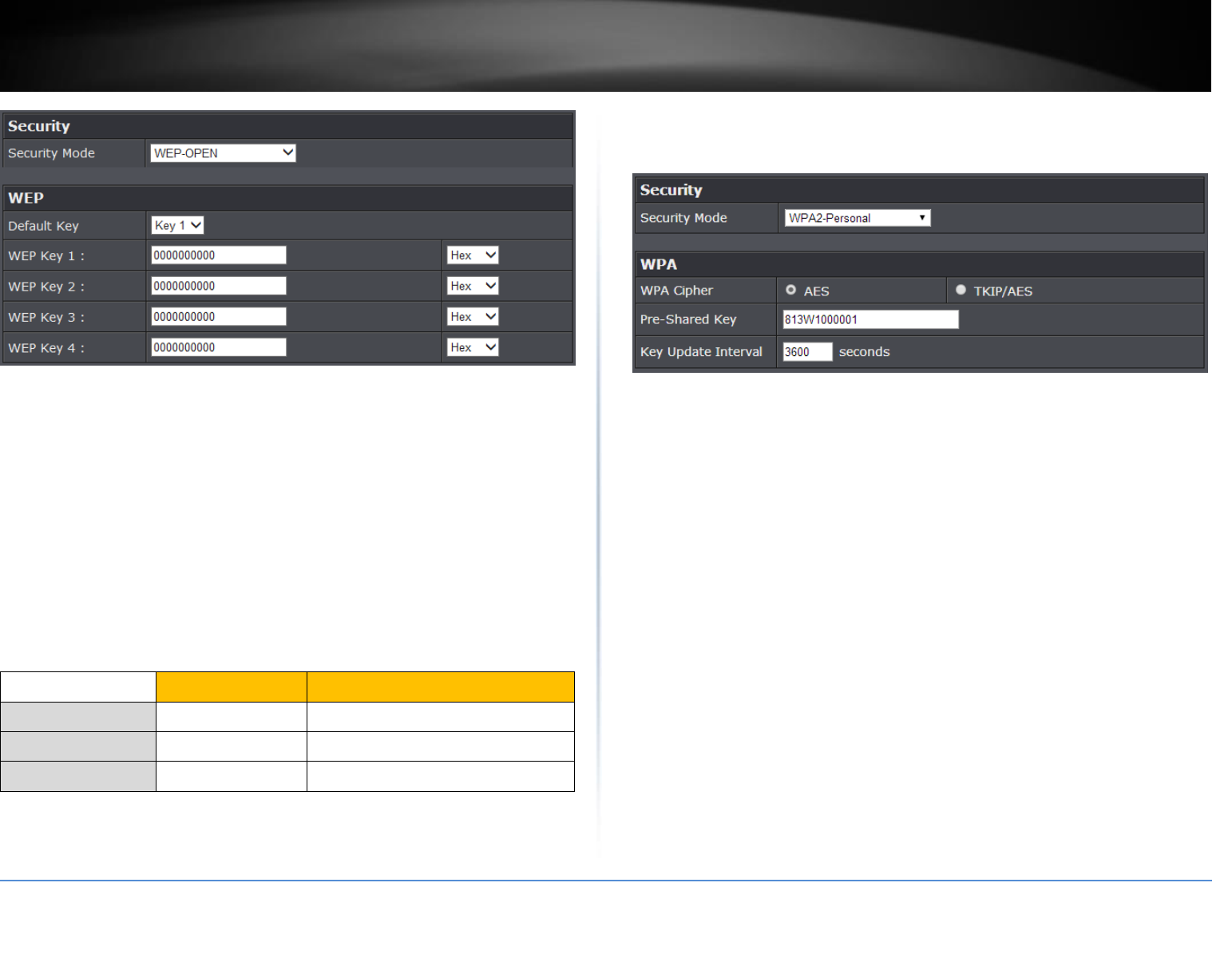
© Copyright 2015 TRENDnet. All Rights Reserved.
TRENDnet User’s Guide
TEW-817DTR
51
Security Mode: Choose WEP-OPEN, WEP-SHARED, or WEP-AUTO.
Note: It is recommended to use Open since it is known to be more secure than
Shared Key.
Default Key: Choose the key index to use for security to the corresponding WEP
Keys 1-4. You can only use one key at any given time.
Note: Please note that they wireless client key index 1-4 should also match the key
index chosen here in order to establish connection.
WEP Key 1-4: Enter the WEP key. This is the password or key that is used to
connect your computer to this router wirelessly. You can enter 64-bit or 128-bit
key. You can enter up to four keys but only the one chosen as the Default Key will
be used.
Note: It is recommended to use 128-bit because it is more secure to use a key that
consists of more characters.
Hex/ASCII: Enter the WEP key format. See the table below for the acceptable
characters and lengths for each format.
Selecting WPA-Personal / WPA2-Personal / WPA2-Personal Mixed
(WPA2-Personal recommended):
In the Security Mode drop-down list, select WPA-Personal, WPA2-Personal, or WPA2-
Personal Mixed. Please review the WPA-Personal settings to configure and click Apply
to save the changes.
The following section outlines options when selecting WPA-Personal, WPA2-Personal,
or WPA2-Personal Mixed (Preshared Key),
WPA Cipher: Select a Cipher Type to use.
o When selecting WPA2-Personal Mixed security, it is recommended to use
TKIP/AES.
o When selecting WPA2-Personal security, it is recommended to use AES.
WPA Pre-Shared Key: Enter the passphrase.
o This is the password or key that is used to connect your computer to this router
wirelessly
Key Format: 8-63 alphanumeric characters (a,b,C,?,*, /,1,2, etc.)
Key Update Interval: Enter the time interval (seconds) of when the network
passphrase will rotate.
Note: It is recommended to use the default interval time. Your passphrase will not
change, rotation of the key is part of the WPA protocol and designed to increase
security.
Selecting WPA-Enterprise / WPA2-Enterprise / WPA2-Enterprise Mixed
(WPA2-Personal recommended):
The following section outlines options when selecting WPA-Enterprise, WPA2-
Enterprise, or WPA2-Enterprise Mixed (EAP or RADIUS). This security type is also known
as EAP (Extensible Authentication Protocol) or Remote Authentication Dial-In User
Service or RADIUS.
WEP Key Format
HEX
ASCII
Character set
0-9 & A-F, a-f only
Alphanumeric (a,b,C,?,*, /,1,2, etc.)
64-bit key length
10 characters
5 characters
128-bit key length
26 characters
13 characters
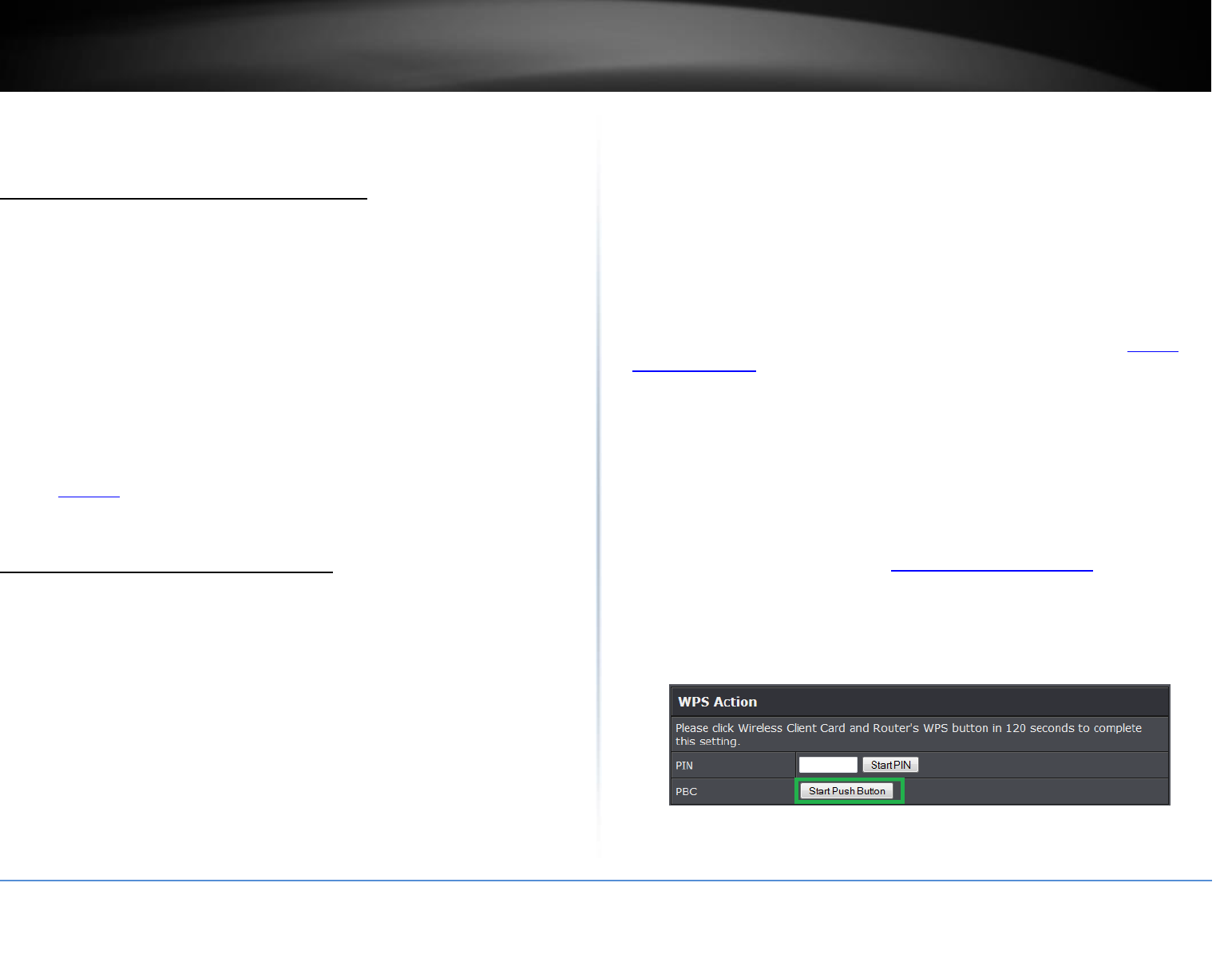
© Copyright 2015 TRENDnet. All Rights Reserved.
TRENDnet User’s Guide
TEW-817DTR
52
Note: This security type requires an external RADIUS server, Pre-Shared Key only requires
you to create a passphrase.
WPA Cipher: Select a Cipher Type to use.
Connect wireless devices to your router
A variety of wireless network devices can connect to your wireless network such as:
Gaming Consoles
Internet enabled TVs
Network media players
Smart Phones
Wireless Laptop computers
Wireless IP cameras
Each device may have its own software utility for searching and connecting to available
wireless networks, therefore, you must refer to the User’s Manual/Guide of your
wireless client device to determine how to search and connect to this router’s wireless
network.
You can view the currently connected wireless client devices under Advanced > Wireless
(2.4GHz or 5GHz) > Station List in the router management page.
See the “Appendix” on page 55 for general information on connecting to a wireless
network.
Connect wireless devices using WPS
WPS (Wi-Fi Protected Setup) is a feature that makes it easy to connect devices to your
wireless network. If your wireless devices support WPS, you can use this feature to
easily add wireless devices to your network.
Note: You will not be able to use WPS if you set the SSID Broadcast setting to Disabled or
if you are using WEP security.
There are two methods the WPS feature can easily connect your wireless devices to
your network.
Push Button Configuration (PBC) method
o (RECOMMENDED) Hardware Push Button method–with an external button
located physically on your router and on your client device
o WPS Software/Virtual Push Button - located in router management page
PIN (Personal Identification Number) Method - located in router management page
Note: Refer to your wireless device documentation for details on the operation of
WPS.
Recommended Hardware Push Button (PBC) Method
Note: It is recommended that a wireless key (passphrase or password) is created
before connecting clients using the PBC method. By default your router is
preconfigured with a wireless encryption key. If no wireless key is defined when
connecting via PBC, the router will automatically create an encryption key that is 64
characters long. This 64 character key will then have to be used if one has to
connect computers to the router using the traditional connection method.
To add a wireless device to your network, simply push the WPS button on the wireless
device you are connecting (consult client device User’s Guide for length of time), then
push and hold the WPS button located on your router for 3 seconds and release it. The
WPS LED will blink to indicate WPS has been activated on your router. (See “Product
Hardware Features” on page 2)
For connecting additional WPS supported devices, repeat this process for each
additional device.
PBC (Software/Virtual Push Button)
Advanced > Wireless (2.4GHz or 5GHz) > WPS
In addition to the hardware push button located physically on your router, the router
management page also has push button which is a software or virtual push button you
can click to activate WPS on your router.
1. Log into the management page (see “Access your management page” on page 7).
2. Click on Advanced, then click on Wireless (2.4GHz or 5GHz), and click on WPS.
3. To add a wireless device to your network, next to Virtual Push Button, click the Start
Push Button button in the router management page. Then push the WPS button on the
wireless device (consult wireless device’s User’s Guide for length of time) you are
connecting.
4. Wait for your router to finsh the WPS process.
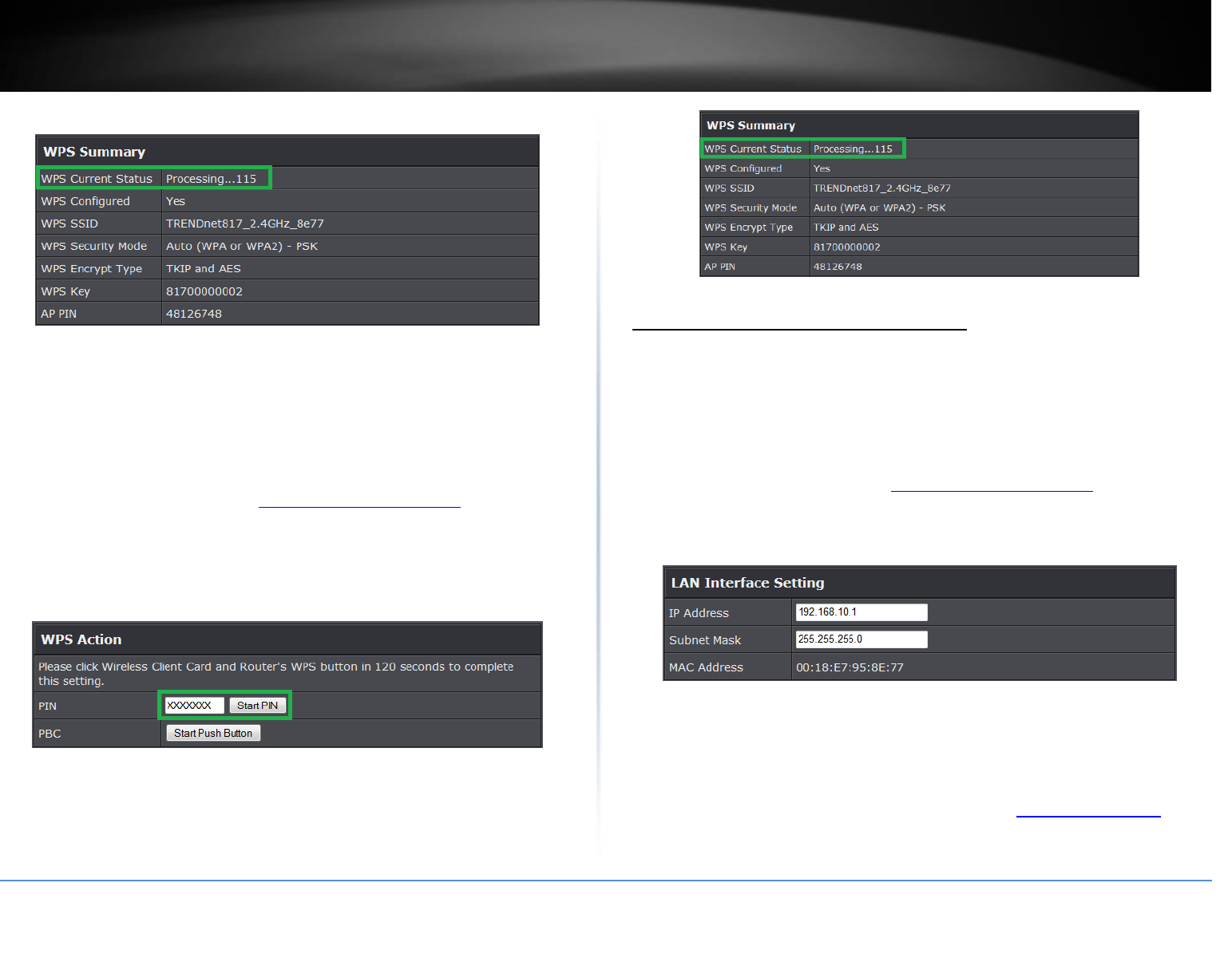
© Copyright 2015 TRENDnet. All Rights Reserved.
TRENDnet User’s Guide
TEW-817DTR
53
Note: You should a message on your WPS client device indicating WPS was successful.
PIN (Personal Identification Number)
Advanced > Wireless (2.4GHz or 5GHz) > WPS
If your wireless device has WPS PIN (typically an 8-digit code printed on the wireless
device product label or located in the wireless device wireless software utility), you can
use this method.
1. Log into the management page (see “Access your management page” on page 7).
2. Click on Wireless, and click on Wi-Fi Protected Setup.
3. To add a wireless device to your network, next to Client, enter the 8-digit numeric PIN
number of the wireless client device and click Start PIN. Note: You may need to initiate
the WPS PIN on your wireless device first when using this method. Refer to your wireless
device documentation for details on the operation of WPS.
4. Wait for your router to finsh the WPS process.
Note: You should a message on your WPS client device indicating WPS was successful.
Change your access point IP address
Setup > LAN Settings
Typically, the access point IP address settings only needs to be changed when
connecting the access point to your network and configuring to the device to be in the
same IP network as your existing network.
Default Access Point IP Address Settings: 192.168.10.100 / 255.255.255.0
1. Log into the management page (see “Access your management page” on page 7).
2. Click on Main, and click on Network Settings.
3. Under Connection Type, click the drop-down list to select the access point IP address
settings.
IP Address: Enter the new access point IP address. (e.g. 192.168.0.100)
Subnet Mask: Enter the new access point subnet mask. (e.g. 255.255.255.0)
4. To save changes, click Apply.
Note: You will need to access your access point management page using your new
access point IP address. (e.g. Instead of using the default http://192.168.10.100 your
new access point IP address will use the following format using your new IP address
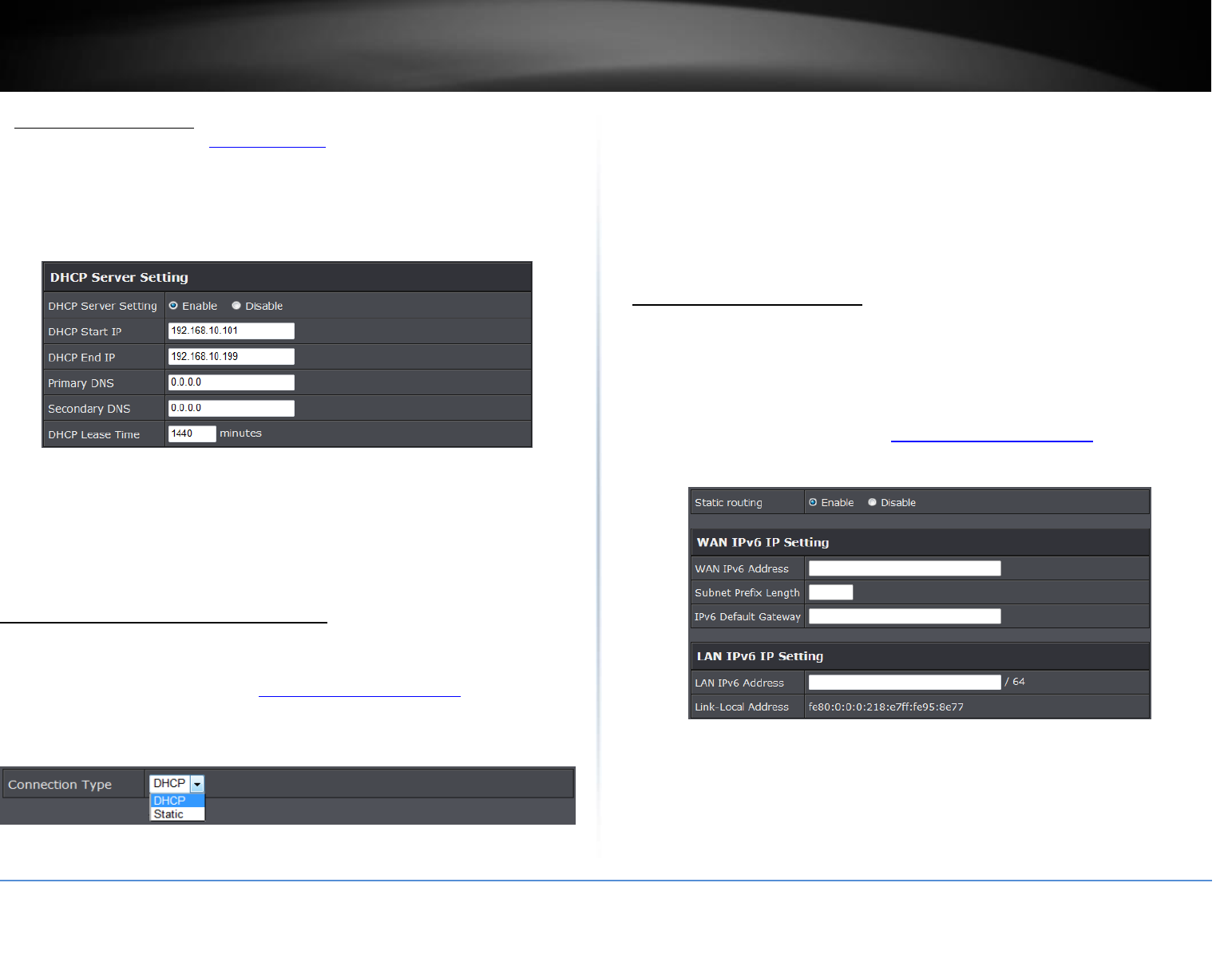
© Copyright 2015 TRENDnet. All Rights Reserved.
TRENDnet User’s Guide
TEW-817DTR
54
http://(new.ipaddress.here) to access your access point management page. You can
also use the default login URL http://tew-817dtr
Your access point can be used as a DHCP (Dynamic Host Configuration Protocol) server
to automatically assign an IP address to each wireless device connected. The DHCP
server settings can be accessed when access point is set to Static IP address and it is
disabled by default
Enable DHCP Server: Select to enable DHCP server.
DHCP Start IP: Enter the starting DHCP IP address to assign.
DHCP End IP: Enter the ending DHCP IP address to assign.
Primary/Secondary DNS: Assign DNS IP address to use
DHCP Lease Time: Select the DHCP lease time allowed.
Configure your Internet connection
Advanced > Setup > Internet Settings
1. Log into the management page (see “Access your management page” on page 7).
2. Click on Advanced and click on Setup, then click on Internet Settings.
3. Under Connection Type in drop-down list, select the type of connection type the
device is connected to.
DHCP: Select to this option to have the device automatically obtain DHCP IP
address from the connected network.
Static: Select this option to manually assign an IP address from the connected
network.
4. To save changes, click Apply.
Note: If you are unsure which Internet connection type you are using, please contact
your network administrator.
IPv6 Connection Settings
Advanced > Setup IPv6 Settings
IPv6 (Internet Protocol Version 6) is a new protocol that significantly increases the
number of available Internet public IP addresses due to the 128-bit IP address structure
versus IPv4 32-bit address structure.
1. Log into the management page (see “Access your management page” on page 7).
2. Click on Main, and click on IPv6.
3. Select the IPv6 connection type to assign IPv6 addressing to the access point.
Static Routing: Select enable to configure IPv6 settings.
WAN IP Setting: Manually enter your assigned WAN IPv6 settings
LAN IPv6 Setting: Manually enter the device’s LAN setting.
4. To save changes, click Apply.
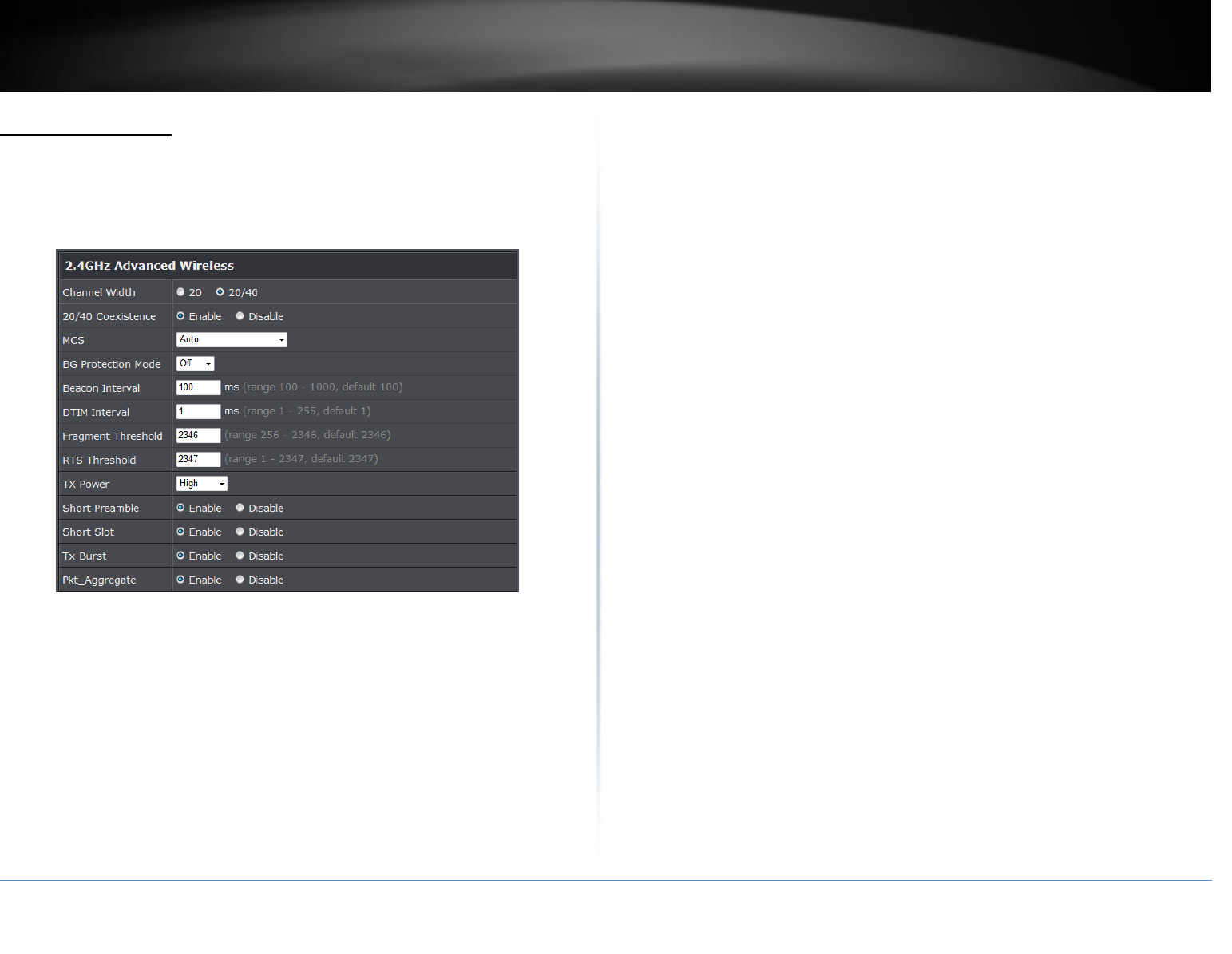
© Copyright 2015 TRENDnet. All Rights Reserved.
TRENDnet User’s Guide
TEW-817DTR
55
Advanced Settings
Advanced > Wireless (2.4GHz or 5GHz) > Advanced
These settings are advanced options that can be configured to change advanced
wireless broadcast specifications. It is recommended that these settings remain set to
their default values unless you are knowledgeable about the effects of changing these
values. Changing these settings incorrectly can degrade performance.
Channel Width: Select the appropriate channel width for your wireless network.
This setting only applies to 802.11n and 802.11ac. For greater 802.11n
performance, select Auto 20/40MHz (Options: 20MHz or Auto 20/40MHz). It is
recommended to use the default channel bandwidth settings.
For greater 802.11ac performance, select Auto 20/40/80MHz (Options: 20MHz,
Auto 20/40MHz, Auto 20/40/80MHz). It is recommended to use the default channel
width settings.
Note: Please note that the default settings may provide more stability than the
higher channel bandwidth settings such as Auto 20/40/80MHz for connectivity in
busy wireless environments where there are several wireless networks in the area.
o 20 MHz: This mode operates using a single 20MHz channel for wireless devices
connecting at 802.11n on both 2.4GHz and 5GHz. This setting may provide more
stability than 20/40MHz (Auto) for connectivity in busy wireless environments
where there are several neighboring wireless networks in the area.
o Auto 20/40MHz (11n) or Auto 20/40/80MHz (11ac): When this setting is active,
this mode is capable of providing higher performance only if the wireless devices
support the channel width settings. Enabling Auto 20/40MHz or Auto 20/40/80
MHz typically results in substantial performance increases when connecting an
802.11ac/n wireless client.
20/40 Coexistence (2.4GHz only): 20/40 MHz Coexistence allows for the auto-
fallback from 40MHz to 20MHz channel width operation when neighboring 802.11
wireless networks are detected.
MCS: Allows you to lock down the wireless transmission rate.
BG Protection:
Beacon Period: A beacon is a management frame used in wireless networks that
transmitted periodically to announce the presence and provide information about
the router’s wireless network. The interval is the amount time between each
beacon transmission. Default Value: 100 milliseconds (range: 100-1000)
DTIM: A DTIM is a countdown informing clients of the next window for listening to
broadcast and multicast messages. When the wireless router has buffered
broadcast or multicast messages for associated clients, it sends the next DTIM with
a DTIM Interval value. Wireless clients detect the beacons and awaken to receive
the broadcast and multicast messages. The default value is 1. Valid settings are
between 1 and 255.
Fragment Threshold: Wireless frames can be divided into smaller units (fragments)
to improve performance in the presence of RF interference and at the limits of RF
coverage. Fragmentation will occur when frame size in bytes is greater than the
Fragmentation Threshold. This setting should remain at its default value of 2346
bytes. Setting the Fragmentation value too low may result in poor performance.
RTS Threshold: The Request To Send (RTS) function is part of the networking
protocol. A wireless device that needs to send data will send a RTS before sending
the data in question. The destination wireless device will send a response called
Clear to Send (CTS). The RTS Threshold defines the smallest data packet size
allowed to initiate the RTS/CTS function. Default Value: 2347 (range: 1-2347)
TX Power: This setting allows you to adjust the wireless transmit power to a lower
setting. In busy wireless environments, lowering the transmit power may improve
better performance and connectivity and decrease interference with neighboring
wireless networks.
Short Preamble: Using a short preamble can potentially increase throughput as the
transfer time is 96 microseconds versus the more commonly used long preamble
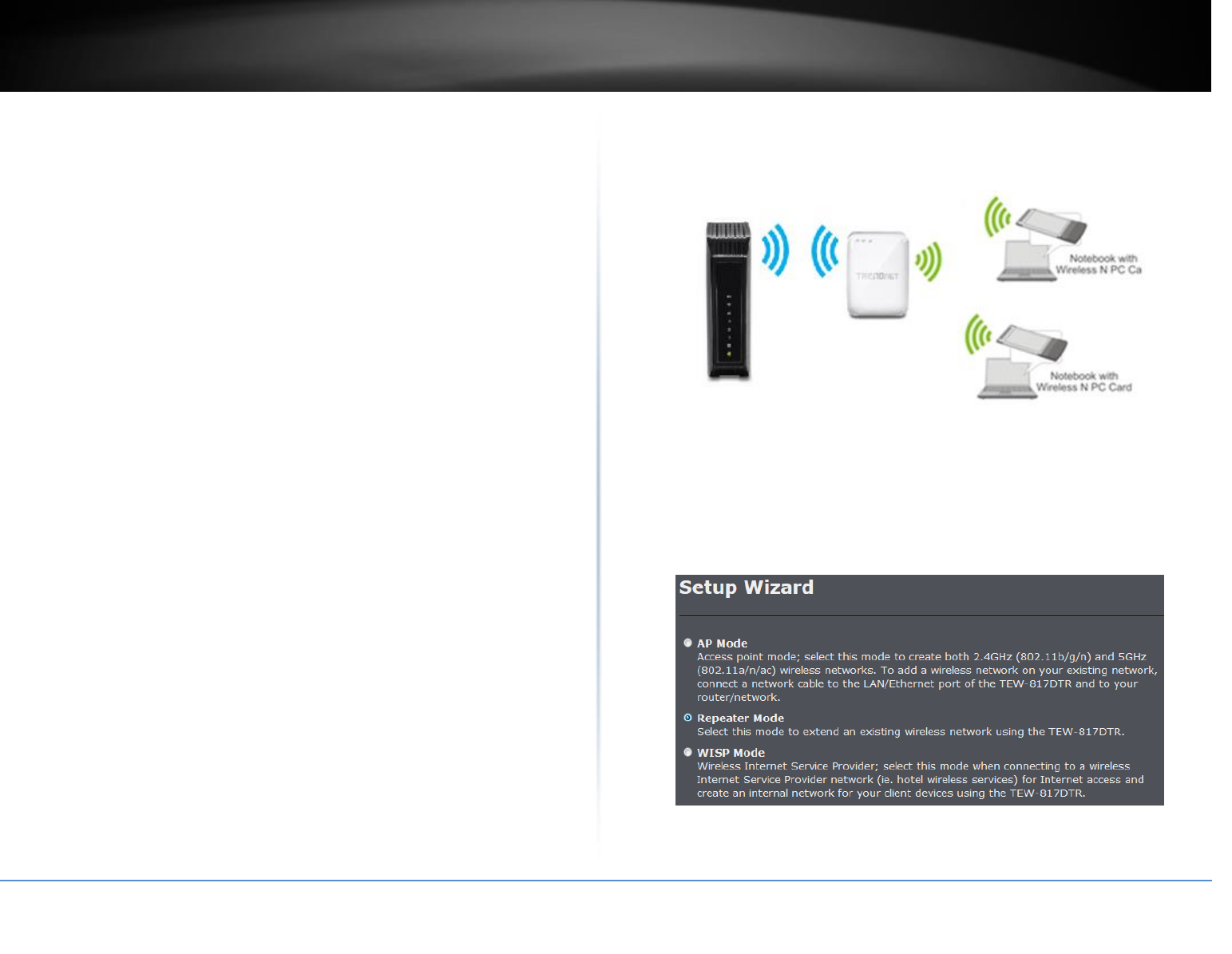
© Copyright 2015 TRENDnet. All Rights Reserved.
TRENDnet User’s Guide
TEW-817DTR
56
192 microseconds. However, using a short preamble is not supported using 802.11b
legacy devices, in some cases cause wireless interoperability issues, and increase
the error rate in some installations. The preamble is the info. sent from the wireless
transmitter to the receiver indicating when data is incoming.
Short Slot: Short Slot Override defines the amount of time a device waits after a
data frame collision before retransmitting the data. Reducing the time from 20
microseconds (standard) to 9 microseconds can potentially increase throughput
however, can also increase the error rate.
Tx Burst: Select this option to enable transmit packet burst.
Pkt_Aggregate: Select this option to enable packet aggregate feature
Repeater Mode
In Repeater mode, the TEW-817DTR Is used to extend the wireless signal of an existing
wireless network.
Setup Wizard
1. Once logged into the management page click Wizard on the left hand side of the
window.
2. Select Repeater Mode and click Next.
3. Select the wireless network you would like to extend.
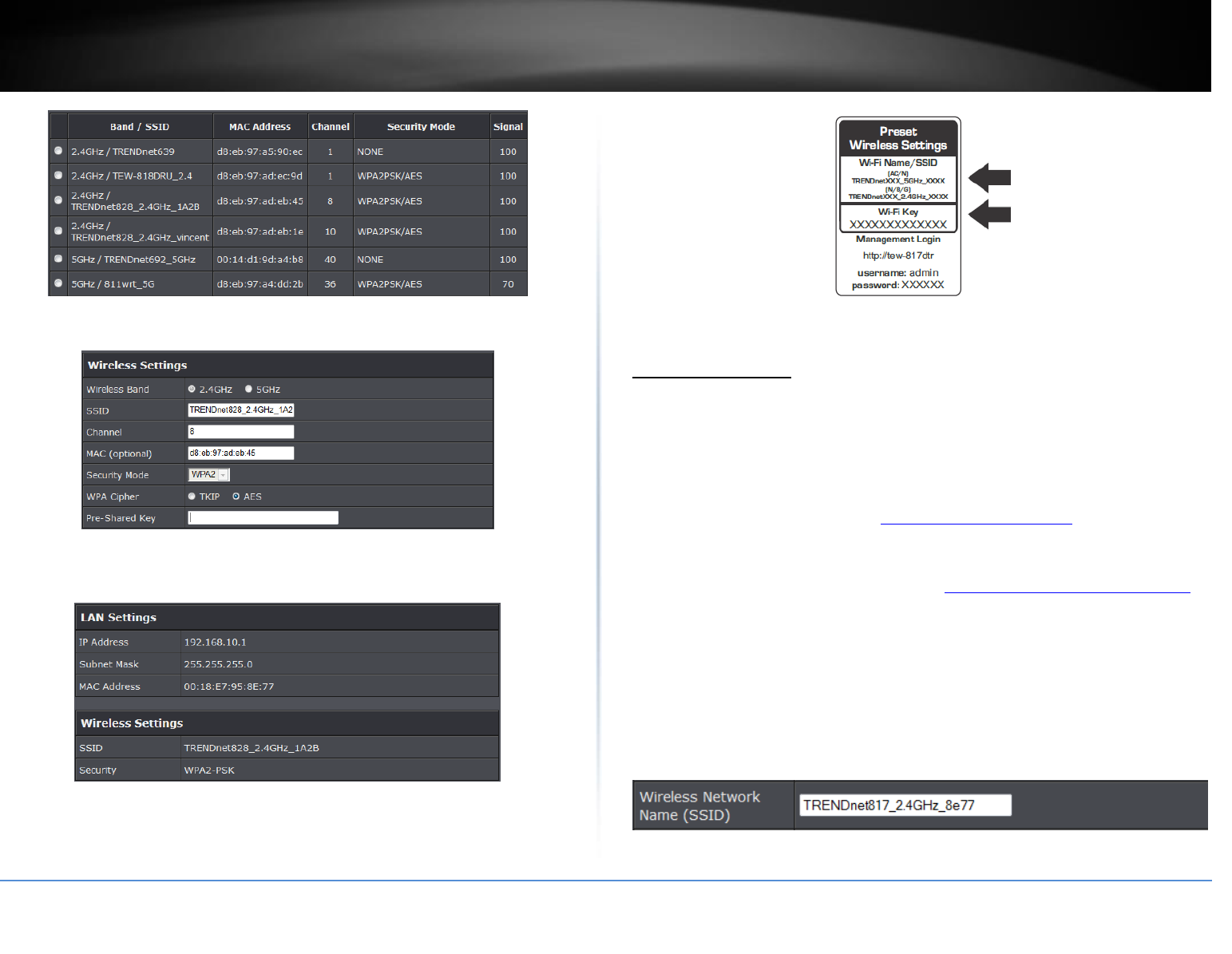
© Copyright 2015 TRENDnet. All Rights Reserved.
TRENDnet User’s Guide
TEW-817DTR
57
3. Enter the wireless security settings provided by your network admin and click Next.
4. Verify your settings and click Apply. To change your wireless settings, refer to
Wireless Settings in this section.
5. Wirelessly connect your devices using the default settings which can be found in the
wireless sticker on the front of the unit or the device label located in the back of the
unit. You can also plug a device using the Ethernet port of the TEW-817DTR.
Wireless Settings
Basic > Wireless (2.4GHz or 5GHz)
The TEW-817DTR concurrently operates on both 2.4GHz and 5Ghz wireless signals. In
repeater mode you can manage the wireless signal that is not repeating an existing
wireless signal. For instance, if you are repeating a wireless 2.4GHz signal you can
manage the 5GHz wireless signal and vice versa. This section outlines available
management options under basic wireless sub tab for both 2.4GHz and 5GHz wireless
sections. You can refer to the page 58 Secure your wireless network to configure your
wireless security settings.
1. Log into your router management page (see “Access your router management page”
on page 9).
2. Click on Wireless and click on Basic scroll down to Wireless Network Settings (2.4GHz
or 5GHz)
3. To save changes to this section, click Apply when finished.
Wireless Network Name (SSID): Enter the wireless name (SSID) for your wireless
network. This acronym stands for Service Set Identifier and is the name of your
wireless network. It differentiates your wireless network from others around you.
By default, the router’s wireless name is unique to the device. If you choose to
change the SSID, change it to a name that you can easily remember.
Broadcast Network Name (SSID)
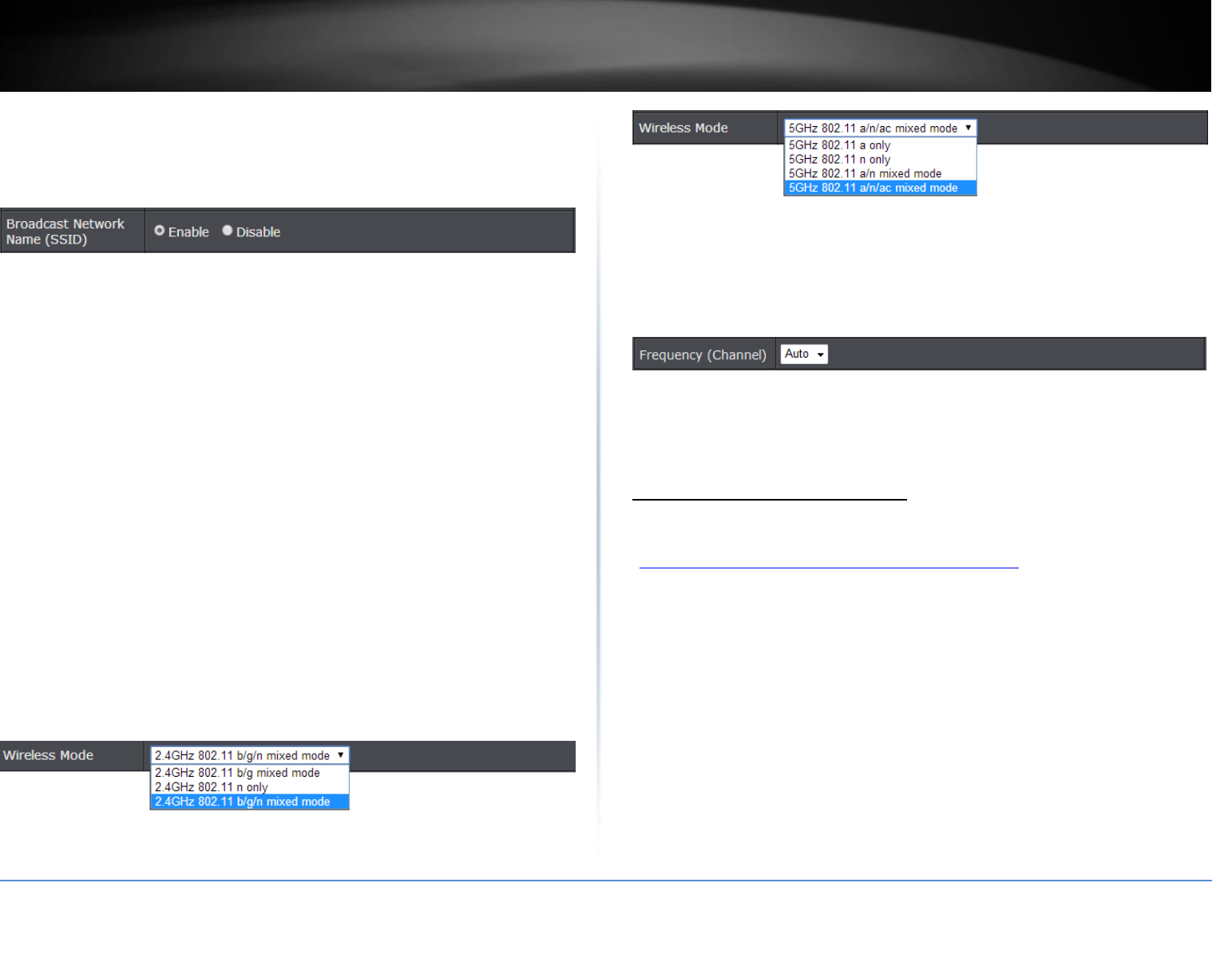
© Copyright 2015 TRENDnet. All Rights Reserved.
TRENDnet User’s Guide
TEW-817DTR
58
o Visible: Allows wireless devices to search and discover your wireless network
name (also called SSID) broadcasted by your router.
o Invisible: Turns off the ability for wireless devices to find your network. It is still
possible for wireless devices to be configured to connect to your wireless
network. Disabling this setting will disable WPS functionality.
Wireless Mode: When applying the Wireless Mode setting, please keep in mind the
following:
o Wireless devices that support 802.11n are backwards compatible and can
connect wirelessly at 802.11g or 802.11b.
o Wireless devices that support 802.11ac are backwards compatible and can
connect wirelessly at 802.11n or 802.11a.
o Connecting at 802.11b or 802.11g will limit the capability of your 802.11n
supported wireless devices from obtaining higher performance and data rates.
o Connecting at 802.11a or 802.11n will limit the capability of your 802.11ac
supported wireless devices from obtaining higher performance and data rates.
o Allowing 802.11b or 802.11g devices to connect to an 802.11n capable wireless
network may degrade the wireless network performance below the higher
performance and data rates of 802.11n.
o Allowing 802.11a or 802.11n devices to connect to an 802.11ac capable wireless
network may degrade the wireless network performance below the higher
performance and data rates of 802.11ac.
o Wireless devices that only support 802.11n or 802.11a will not be able to connect
to a wireless network that is set to 802.11ac only mode.
o Wireless devices that only support 802.11b or 802.11g will not be able to connect
to a wireless network that is set to 802.11n only mode.
o Wireless devices that only support 802.11b will not be able to connect to a
wireless network that is set to 802.11g only mode.
o Wireless devices that only support 802.11a will not be able to connect to a
wireless network that is set to 802.11n only mode.
Auto Channel Scan – Check this option to set your router to scan for which wireless
channels to use automatically.
Frequency (Channel) – Selecting the Auto option will set your router to scan for the
appropriate wireless channel to use automatically. Click the drop-down list and
select the desired Channel for wireless communication. The goal is to select the
Channel that is least used by neighboring wireless networks.
Wireless Networking and Security
Secure your wireless network
Basic > Wireless
After you have determined which security type to use for your wireless network (see
“How to choose the security type for your wireless network” on page 9), you can set up
wireless security.
Note: By default, your router is configured with a predefined wireless network name
(SSID) and security key using WPA2-Personal. The predefined wireless network name and
security can be found on the sticker on the side of the router or on the device label at the
bottom of the router.
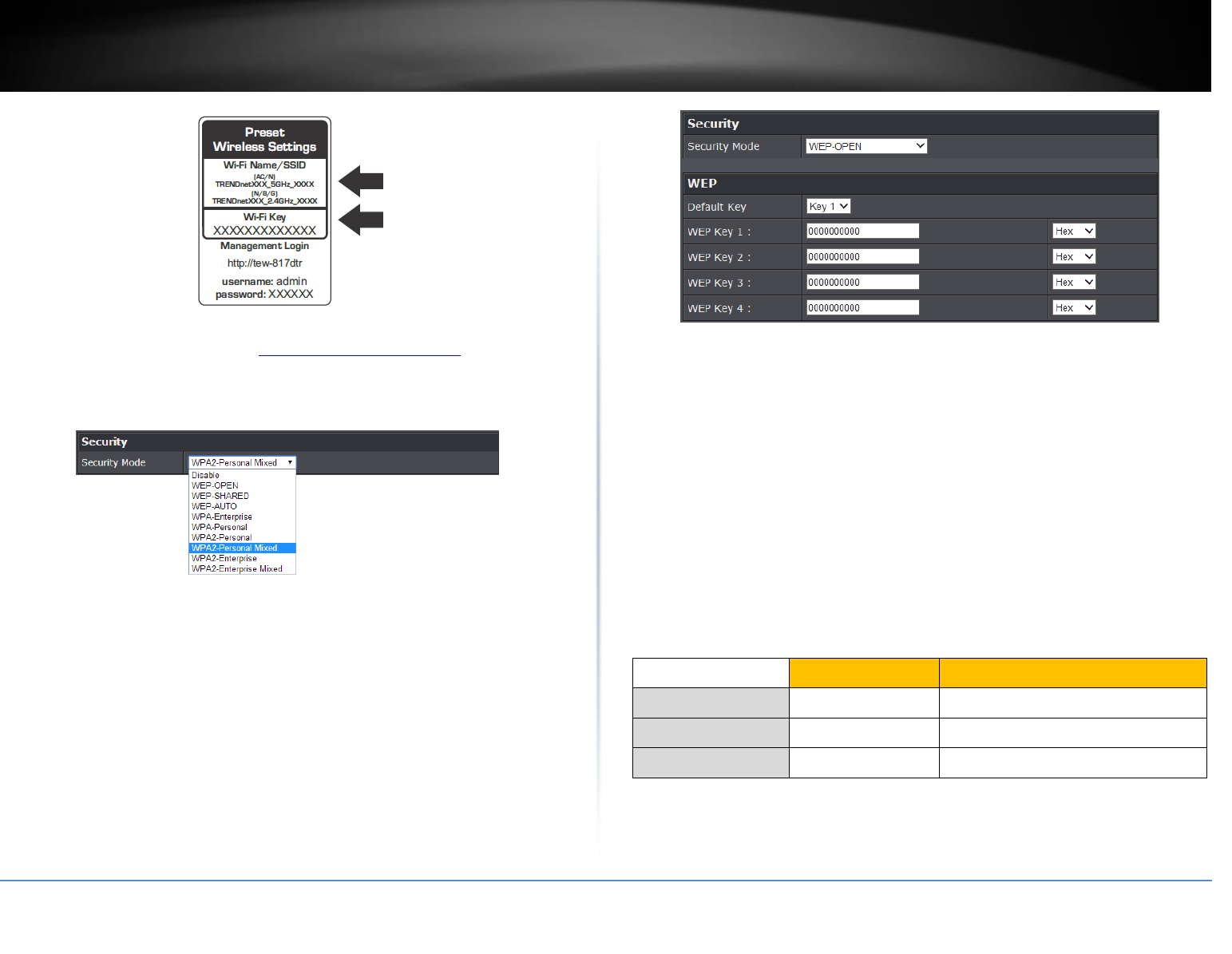
© Copyright 2015 TRENDnet. All Rights Reserved.
TRENDnet User’s Guide
TEW-817DTR
59
1. Log into the management page (see “Access your management page” on page 7).
2. Click on Basic, and click on Wireless.
3. Under Security, click on the Security Mode drop-down list to select your wireless
security type.
Selecting WEP:
If selecting WEP (Wired Equivalent Privacy), please review the WEP settings to configure
and click Apply to save the changes.
Security Mode: Choose WEP-OPEN, WEP-SHARED, or WEP-AUTO.
Note: It is recommended to use Open since it is known to be more secure than
Shared Key.
Default Key: Choose the key index to use for security to the corresponding WEP
Keys 1-4. You can only use one key at any given time.
Note: Please note that they wireless client key index 1-4 should also match the key
index chosen here in order to establish connection.
WEP Key 1-4: Enter the WEP key. This is the password or key that is used to
connect your computer to this router wirelessly. You can enter 64-bit or 128-bit
key. You can enter up to four keys but only the one chosen as the Default Key will
be used.
Note: It is recommended to use 128-bit because it is more secure to use a key that
consists of more characters.
Hex/ASCII: Enter the WEP key format. See the table below for the acceptable
characters and lengths for each format.
Selecting WPA-Personal / WPA2-Personal / WPA2-Personal Mixed
(WPA2-Personal recommended):
WEP Key Format
HEX
ASCII
Character set
0-9 & A-F, a-f only
Alphanumeric (a,b,C,?,*, /,1,2, etc.)
64-bit key length
10 characters
5 characters
128-bit key length
26 characters
13 characters
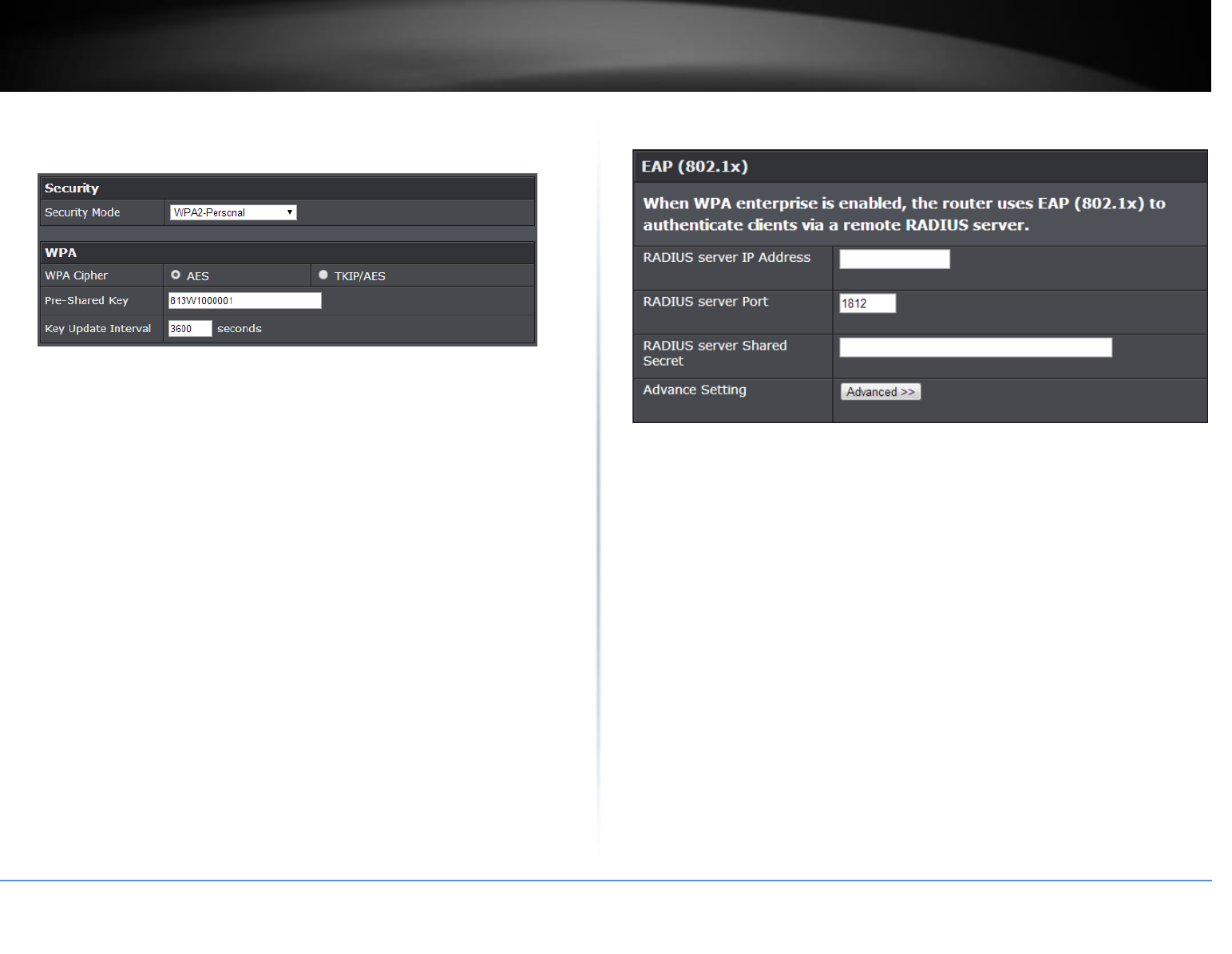
© Copyright 2015 TRENDnet. All Rights Reserved.
TRENDnet User’s Guide
TEW-817DTR
60
In the Security Mode drop-down list, select WPA-Personal, WPA2-Personal, or WPA2-
Personal Mixed. Please review the WPA-Personal settings to configure and click Apply
to save the changes.
The following section outlines options when selecting WPA-Personal, WPA2-Personal,
or WPA2-Personal Mixed (Preshared Key),
WPA Cipher: Select a Cipher Type to use.
o When selecting WPA2-Personal Mixed security, it is recommended to use
TKIP/AES.
o When selecting WPA2-Personal security, it is recommended to use AES.
WPA Pre-Shared Key: Enter the passphrase.
o This is the password or key that is used to connect your computer to this router
wirelessly
Key Format: 8-63 alphanumeric characters (a,b,C,?,*, /,1,2, etc.)
Key Update Interval: Enter the time interval (seconds) of when the network
passphrase will rotate.
Note: It is recommended to use the default interval time. Your passphrase will not
change, rotation of the key is part of the WPA protocol and designed to increase
security.
Selecting WPA-Enterprise / WPA2-Enterprise / WPA2-Enterprise Mixed
(WPA2-Personal recommended):
The following section outlines options when selecting WPA-Enterprise, WPA2-
Enterprise, or WPA2-Enterprise Mixed (EAP or RADIUS). This security type is also known
as EAP (Extensible Authentication Protocol) or Remote Authentication Dial-In User
Service or RADIUS.
Note: This security type requires an external RADIUS server, Pre-Shared Key only requires
you to create a passphrase.
WPA Cipher: Select a Cipher Type to use.
o When selecting WPA2-Personal Mixed security, it is recommended to use
TKIP/AES.
o When selecting WPA2-Personal security, it is recommended to use AES.
Key Update Interval: Enter the time interval (seconds) of when the network
passphrase will rotate.
Note: It is recommended to use the default interval time. Your passphrase will not
change, rotation of the key is part of the WPA protocol and designed to increase
security.
RADIUS Server Address: Enter the IP address of the RADIUS server. (e.g.
192.168.10.250)
RADIUS Port: Enter the port your RADIUS server is configured to use for RADIUS
authentication.
Note: It is recommended to use port 1812 which is typical default RADIUS port.
RADIUS Server Shared Secret: Enter the shared secret used to authorize your
router with your RADIUS server.
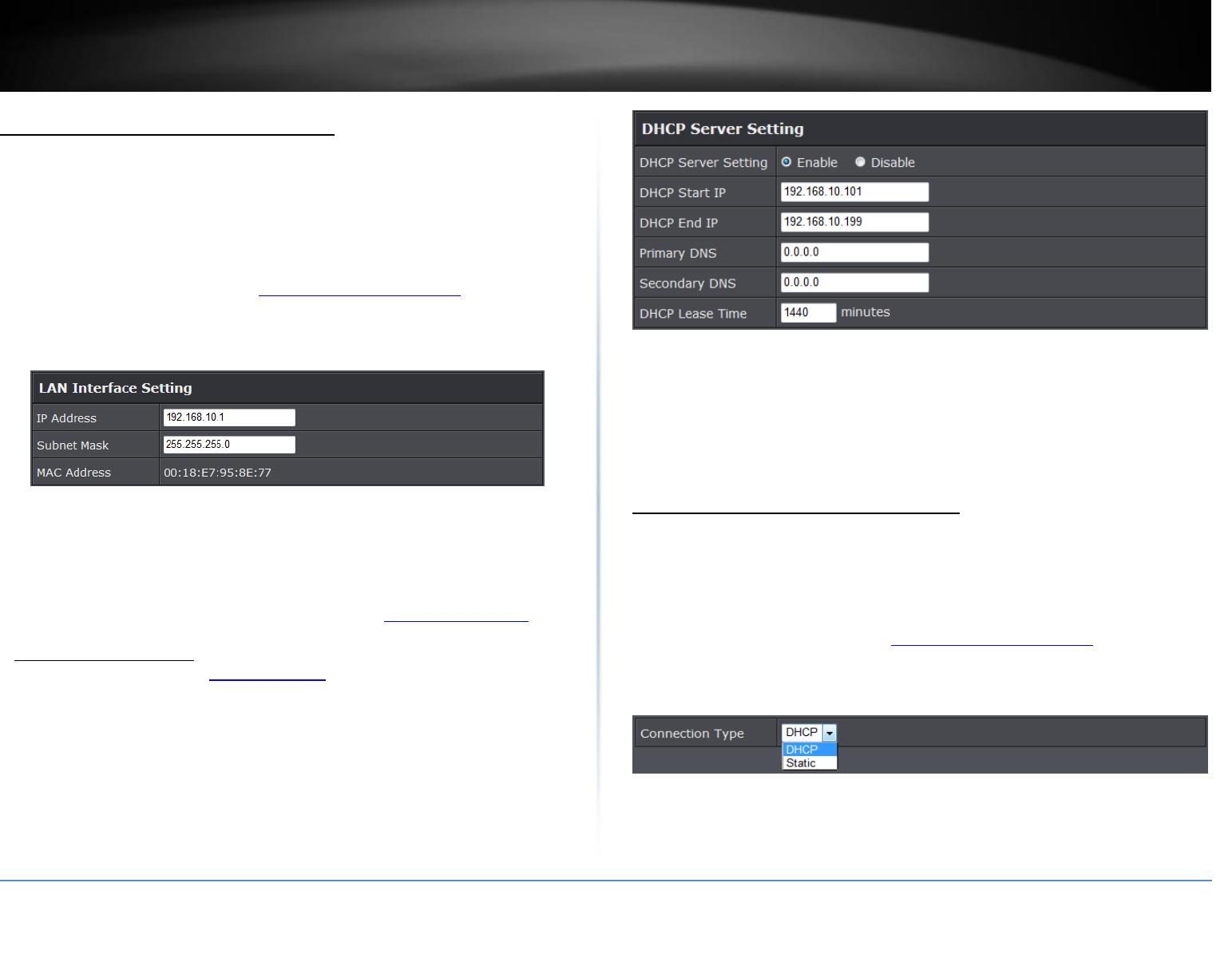
© Copyright 2015 TRENDnet. All Rights Reserved.
TRENDnet User’s Guide
TEW-817DTR
61
Change your access point IP address
Setup > LAN Settings
Typically, the access point IP address settings only needs to be changed when
connecting the access point to your network and configuring to the device to be in the
same IP network as your existing network.
Default Access Point IP Address Settings: 192.168.10.1 / 255.255.255.0
1. Log into the management page (see “Access your management page” on page 7).
2. Click on Main, and click on Network Settings.
3. Under Connection Type, click the drop-down list to select the access point IP address
settings.
IP Address: Enter the new access point IP address. (e.g. 192.168.0.100)
Subnet Mask: Enter the new access point subnet mask. (e.g. 255.255.255.0)
4. To save changes, click Apply.
Note: You will need to access your access point management page using your new
access point IP address. (e.g. Instead of using the default http://192.168.10.100 your
new access point IP address will use the following format using your new IP address
http://(new.ipaddress.here) to access your access point management page. You can
also use the default login URL http://tew-817dtr
Your access point can be used as a DHCP (Dynamic Host Configuration Protocol) server
to automatically assign an IP address to each wireless device connected. The DHCP
server settings can be accessed when access point is set to Static IP address and it is
disabled by default
Enable DHCP Server: Select to enable DHCP server.
DHCP Start IP: Enter the starting DHCP IP address to assign.
DHCP End IP: Enter the ending DHCP IP address to assign.
Primary/Secondary DNS: Assign DNS IP address to use
DHCP Lease Time: Select the DHCP lease time allowed.
Configure your Internet connection
Advanced > Setup > Internet Settings
In repeater mode the access point will just repeat the wireless signal of an existing
network. Setting up the Internet connection will allow you to manually enter an
assigned IP address for the connected network. Typically this setting is not required to
be completed.
1. Log into the management page (see “Access your management page” on page 7).
2. Click on Advanced and click on Setup, then click on Internet Settings.
3. Under Connection Type in drop-down list, select the type of connection type the
device is connected to.
DHCP: Select to this option to have the device automatically obtain DHCP IP
address from the connected network.
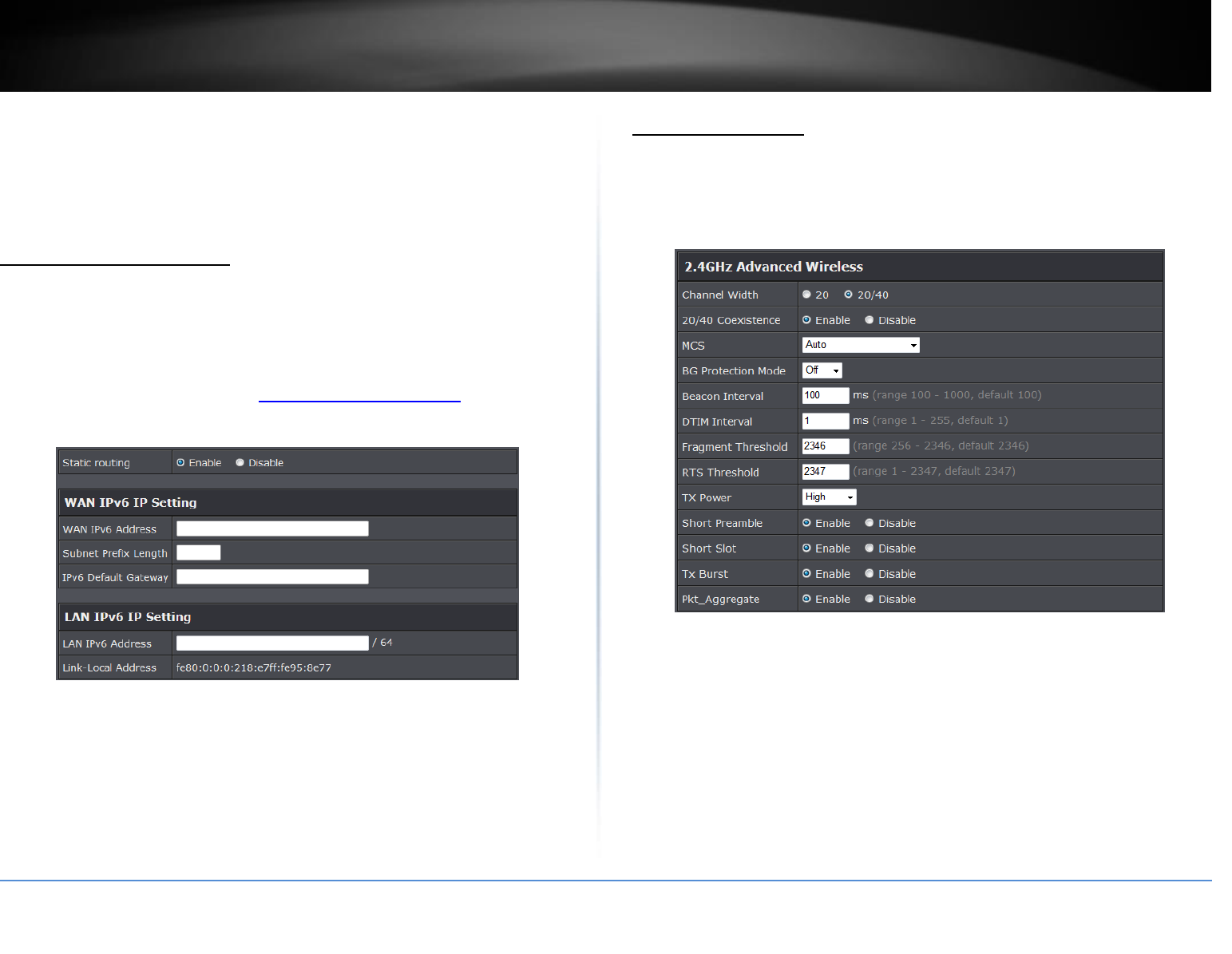
© Copyright 2015 TRENDnet. All Rights Reserved.
TRENDnet User’s Guide
TEW-817DTR
62
Static: Select this option to manually assign an IP address from the connected
network.
4. To save changes, click Apply.
Note: If you are unsure which Internet connection type you are using, please contact
your network administrator.
IPv6 Connection Settings
Advanced > Setup IPv6 Settings
IPv6 (Internet Protocol Version 6) is a new protocol that significantly increases the
number of available Internet public IP addresses due to the 128-bit IP address structure
versus IPv4 32-bit address structure.
1. Log into the management page (see “Access your management page” on page 7).
2. Click on Main, and click on IPv6.
3. Select the IPv6 connection type to assign IPv6 addressing to the access point.
Static Routing: Select enable to configure IPv6 settings.
WAN IP Setting: Manually enter your assigned WAN IPv6 settings
LAN IPv6 Setting: Manually enter the device’s LAN setting.
4. To save changes, click Apply.
Advanced Settings
Advanced > Wireless (2.4GHz or 5GHz) > Advanced
These settings are advanced options that can be configured to change advanced
wireless broadcast specifications. It is recommended that these settings remain set to
their default values unless you are knowledgeable about the effects of changing these
values. Changing these settings incorrectly can degrade performance.
20/40 Coexistence (2.4GHz only): 20/40 MHz Coexistence allows for the auto-
fallback from 40MHz to 20MHz channel width operation when neighboring 802.11
wireless networks are detected.
MCS: Allows you to lock down the wireless transmission rate.
BG Protection:
Beacon Period: A beacon is a management frame used in wireless networks that
transmitted periodically to announce the presence and provide information about
the router’s wireless network. The interval is the amount time between each
beacon transmission. Default Value: 100 milliseconds (range: 100-1000)
DTIM: A DTIM is a countdown informing clients of the next window for listening to
broadcast and multicast messages. When the wireless router has buffered
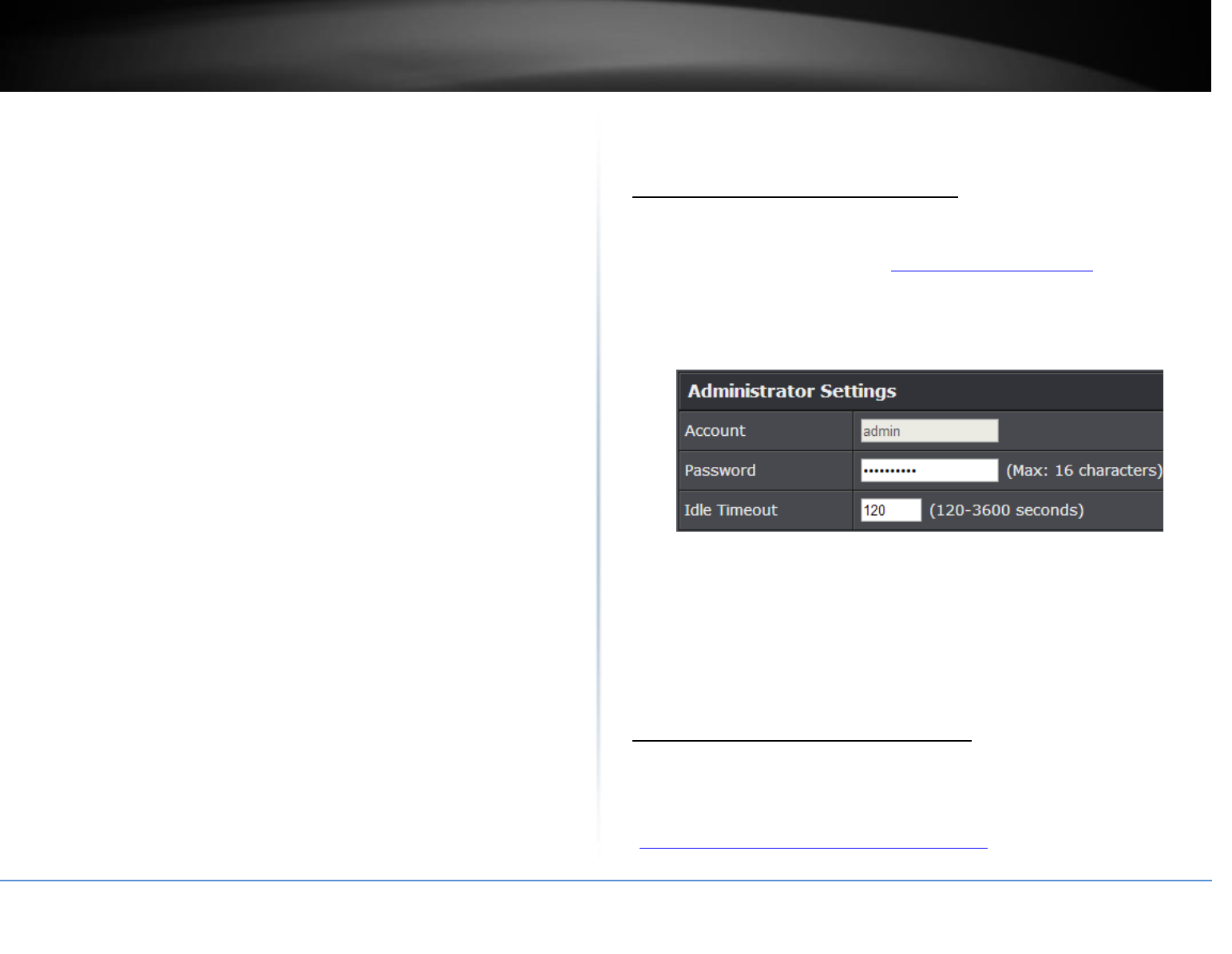
© Copyright 2015 TRENDnet. All Rights Reserved.
TRENDnet User’s Guide
TEW-817DTR
63
broadcast or multicast messages for associated clients, it sends the next DTIM with
a DTIM Interval value. Wireless clients detect the beacons and awaken to receive
the broadcast and multicast messages. The default value is 1. Valid settings are
between 1 and 255.
Fragment Threshold: Wireless frames can be divided into smaller units (fragments)
to improve performance in the presence of RF interference and at the limits of RF
coverage. Fragmentation will occur when frame size in bytes is greater than the
Fragmentation Threshold. This setting should remain at its default value of 2346
bytes. Setting the Fragmentation value too low may result in poor performance.
RTS Threshold: The Request To Send (RTS) function is part of the networking
protocol. A wireless device that needs to send data will send a RTS before sending
the data in question. The destination wireless device will send a response called
Clear to Send (CTS). The RTS Threshold defines the smallest data packet size
allowed to initiate the RTS/CTS function. Default Value: 2347 (range: 1-2347)
TX Power: This setting allows you to adjust the wireless transmit power to a lower
setting. In busy wireless environments, lowering the transmit power may improve
better performance and connectivity and decrease interference with neighboring
wireless networks.
Short Preamble: Using a short preamble can potentially increase throughput as the
transfer time is 96 microseconds versus the more commonly used long preamble
192 microseconds. However, using a short preamble is not supported using 802.11b
legacy devices, in some cases cause wireless interoperability issues, and increase
the error rate in some installations. The preamble is the info. sent from the wireless
transmitter to the receiver indicating when data is incoming.
Short Slot: Short Slot Override defines the amount of time a device waits after a
data frame collision before retransmitting the data. Reducing the time from 20
microseconds (standard) to 9 microseconds can potentially increase throughput
however, can also increase the error rate.
Tx Burst:
Pkt_Aggregate:
Maintenance & Monitoring
Change your router login password
Advanced > Setup > Management
1. Log into the management page (see “Access your management page” on page 7).
2. Click on Advanced and click on Setup, then click on Management.
3. Under the Administrator Settings section, in the Password field.
Note: The idle timeout setting is used to define the period of inactivity in the router
management page before automatically logging out.
4. To save changes, click Apply.
Note: If you change the router login password, you will need to access the router
management page using the User Name “admin” and the new password instead of the
predefined default password. If you reset the device to defaults, you will need to access
the router management page use the predefined settings on the side or bottom labels.
Reset your router to factory defaults
Advanced > Administrator > Settings Management
You may want to reset your router to factory defaults if you are encountering difficulties
with your router and have attempted all other troubleshooting. Before you reset your
router to defaults, if possible, you should backup your router configuration first, see
“Backup and restore your router configuration settings” on page 64.
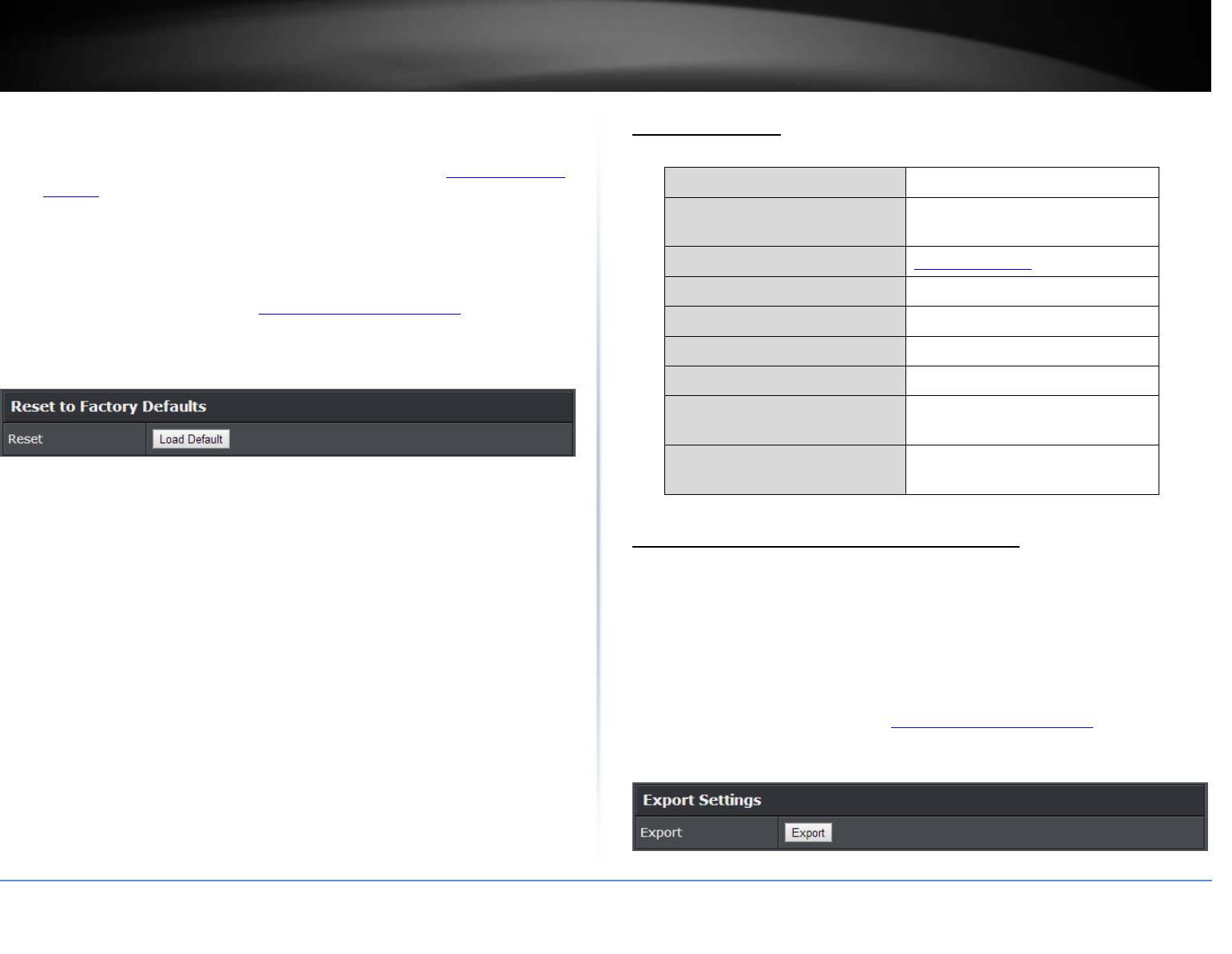
© Copyright 2015 TRENDnet. All Rights Reserved.
TRENDnet User’s Guide
TEW-817DTR
64
There are two methods that can be used to reset your router to factory defaults.
Reset Button – Located on the side panel of your router, see “Product Hardware
Features” on page 2. Use this method if you are encountering difficulties with
accessing your router management page.
OR
Router Management Page
1. Log into the management page (see “Access your management page” on page 7).
2. Click on Advanced and click on Administrator, then click on Settings Management.
3. Next to Reset to Factory Default Settings and Reset, click Load Default. When
prompted to confirm this action, click OK.
Default Settings
Administrator User Name
admin
Administrator Password
Please refer to sticker or device
label
Router Default URL
http://tew-817dtr
Router IP Address
192.168.10.1
Router Subnet Mask
255.255.255.0
DHCP Server IP Range
192.168.10.101-192.168.199
Wireless 2.4GHz & 5GHz
Enabled
Wireless 2.4GHz Network
Name/Encryption
Please refer to sticker or device
label
Wireless 2.4GHz & 5GHz Guest
Network
Disabled
Backup and restore configuration settings
Advanced > Administrator > Settings Management
You may have added many customized settings to your router and in the case that you
need to reset your router to default, all your customized settings would be lost and
would require you to manually reconfigure all of your router settings instead of simply
restoring from a backed up router configuration file.
To backup your router configuration:
1. Log into the management page (see “Access your management page” on page 7).
2. Click on Advanced and click on Administrator, then click on Settings Management.
3. Next to Export Settings section and Export, click Export.
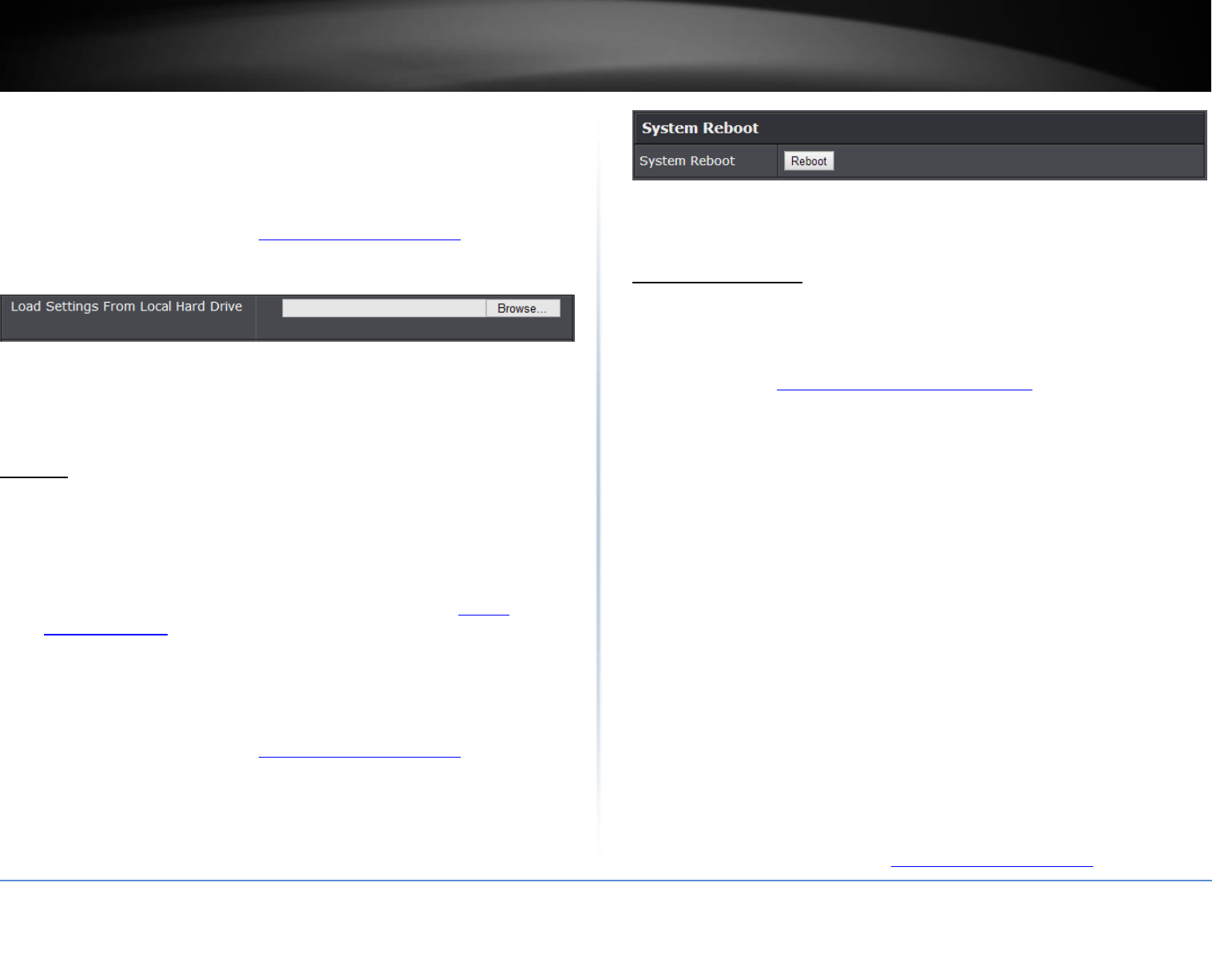
© Copyright 2015 TRENDnet. All Rights Reserved.
TRENDnet User’s Guide
TEW-817DTR
65
4. Depending on your web browser settings, you may be prompted to save a file (specify
the location) or the file may be downloaded automatically to the web browser
settings default download folder. (Default Filename: TEW-817DTR_config.bin)
To restore your router configuration:
1. Log into the management page (see “Access your management page” on page 7).
2. Click on Advanced and click on Administrator, then click on Settings Management.
3. Next to Import Settings section and Settings File Location, click Browse.
4. A separate file navigation window should open.
5. Select the router configuration file to restore and click Import. (Default Filename:
TEW-817DTR_config.bin). If prompted, click Yes or OK.
6. Wait for the router to restore settings.
Reboot
Advanced > Administrator > Settings Management
You may want to restart your router if you are encountering difficulties with your router
and have attempted all other troubleshooting.
There are two methods that can be used to restart your router.
Turn the router off for 10 seconds using the router On/Off switch located on the
rear panel of your router or disconnecting the power port, see “Product
Hardware Features” on page 4.
Use this method if you are encountering difficulties with accessing your router
management page. This is also known as a hard reboot or power cycle.
OR
Router Management Page – This is also known as a soft reboot or restart.
1. Log into the management page (see “Access your management page” on page 7).
2. Click on Advanced and click on Administrator, then click on Settings Management.
3. Next to System Reboot, click Reboot.
4. Wait for the device to reboot.
Upgrade firmware
Advanced > Setup > Firmware
TRENDnet may periodically release firmware upgrades that may add features or fix
problems associated with your TRENDnet router model and version. To check if there is
a firmware upgrade available for your device, please check your TRENDnet model and
version using the link. http://www.trendnet.com/downloads/
In addition, it is also important to verify if the latest firmware version is newer than the
one your router is currently running. To identify the firmware that is currently loaded on
your router, log in to the router, click on the Administrator section and then on the
Status. The firmware used by the router is listed at the top of this page. If there is a
newer version available, also review the release notes to check if there were any new
features you may want or if any problems were fixed that you may have been
experiencing.
1. If a firmware upgrade is available, download the firmware to your computer.
2. Unzip the file to a folder on your computer.
Please note the following:
Do not interrupt the firmware upgrade process. Do not turn off the device or
press the Reset button during the upgrade.
If you are upgrade the firmware using a laptop computer, ensure that the laptop
is connected to a power source or ensure that the battery is fully charged.
Disable sleep mode on your computer as this may interrupt the firmware upgrade
process.
Do not upgrade the firmware using a wireless connection, only using a wired
network connection.
Any interruptions during the firmware upgrade process may permanently
damage your router.
1. Log into the management page (see “Access your management page” on page 7).
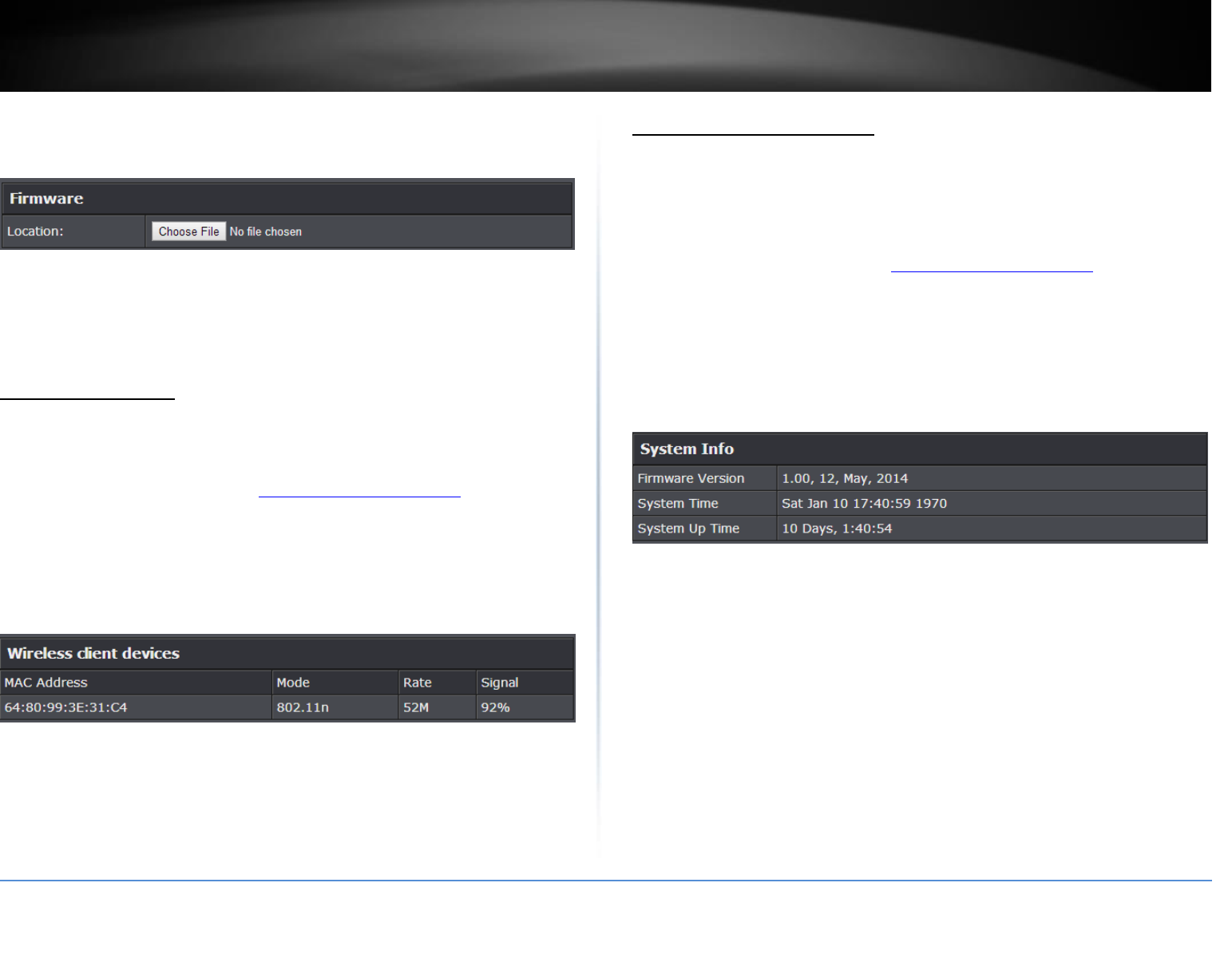
© Copyright 2015 TRENDnet. All Rights Reserved.
TRENDnet User’s Guide
TEW-817DTR
66
2. Click on Advanced and click Setup, then click Firmware.
3. Depending on your web browser, in the Upload Firmware section, click Browse or
Choose File.
4. Navigate to the folder on your computer where the unzipped firmware file (.bin) is
located and select it.
5. Click Apply. If prompted, click Yes or OK.
Wireless Client List
Advanced > Wireless (2.4GHz or 5GHz) > Station List
You can view the list of active wireless devices currently connected to your router.
1. Log into the management page (see “Access your management page” on page 7).
2. Click on Advanced and click on Wireless (2.4GHz or 5GHz), then click on Station List
MAC Address: The current MAC address of your 2.4GHz wireless client.
Mode: Displays the 802.11 mode associated with the client.
Rate: Displays the estimated data rate established with the client.
Signal: Displays the estimated signal strength associated with the client.
.
Check system information
Advanced > Administrator > Status
You may want to check the system information of your router such as WAN (Internet)
connectivity, wireless and wired network settings, router MAC address, and firmware
version.
1. Log into the management page (see “Access your management page” on page 7).
2. Click on Advanced and click on Administrator, then click on Status
System Information
Firmware Version: The current firmware version your router is running.
Time: The current time set on your router.
System Up Time: The duration your router has been running continuously
without a restart/power cycle (hard or soft reboot) or reset.
Internet Configuration
Connected Type: Displays the current WAN connection type applied.
WAN IP Address: The current IP address assigned to your router WAN port or
interface configuration.
WAN MAC Address: Displays the current WAN MAC address.
Subnet Mask: The current subnet mask assigned to your router WAN port or
interface configuration.
Default Gateway: The current gateway assigned to your router WAN port or
interface configuration.
Primary/Secondary DNS (Domain Name System) Server: The current DNS
address(es) assigned to your router port or interface configuration.
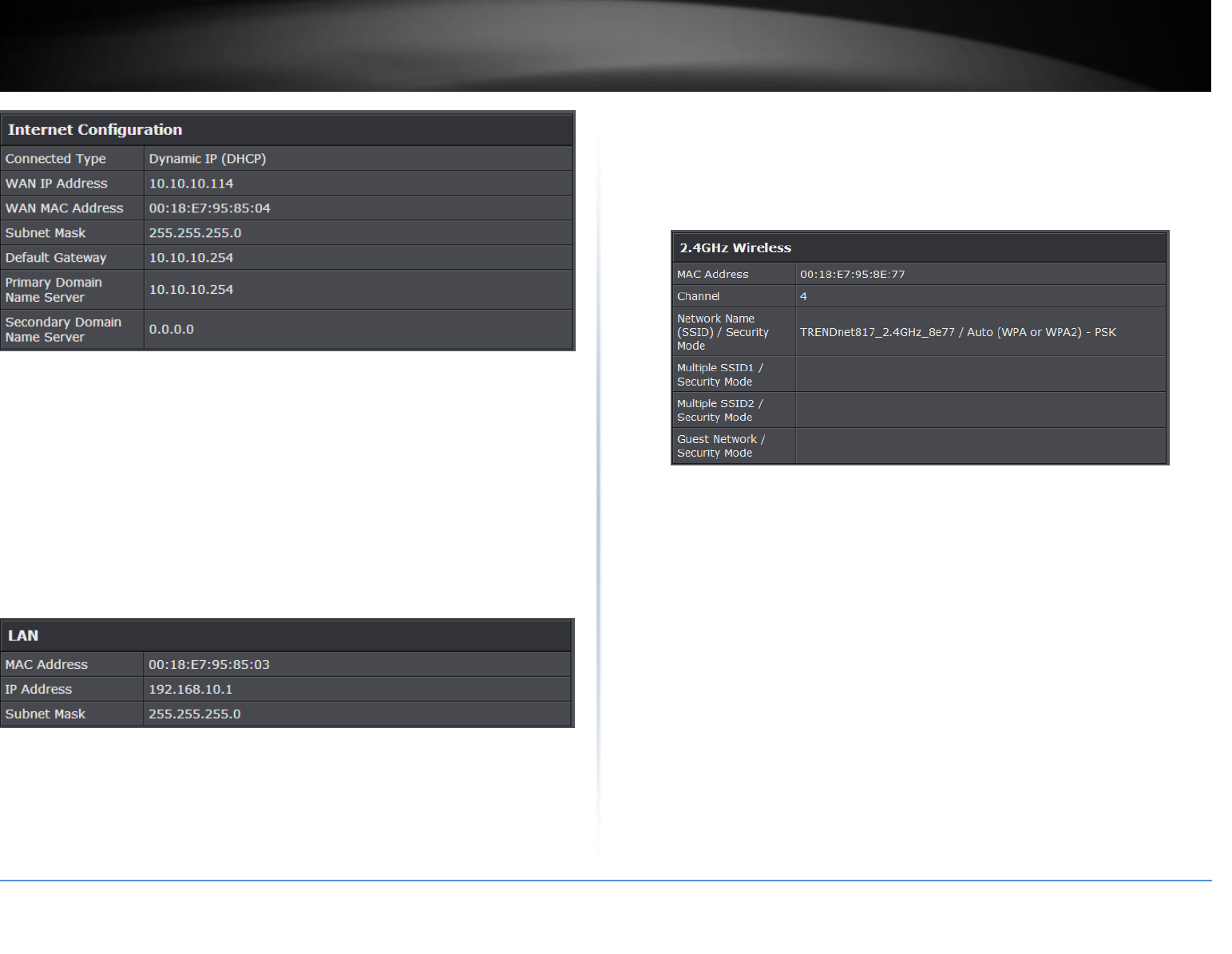
© Copyright 2015 TRENDnet. All Rights Reserved.
TRENDnet User’s Guide
TEW-817DTR
67
DHCP WAN Type: These buttons will be available in DHCP WAN type only.
o Renew: Click this option to renew your WAN IP address.
o Release: Click this option to release the WAN IP address of your
router.
PPPoE WAN Type: These buttons will be available in DHCP WAN type only.
o Connect: Click this option to connect to your DSL ISP
o Disconnect: Click this option to disconnect from your DSL ISP.
LAN Information
MAC Address: The current MAC address of your router’s wireless or interface
configuration.
IP Address: Displays your router’s current IP address.
Subnet Mask: Displays your router’s current subnet mask.
2.4GHz Wireless LAN
MAC Address: The MAC address of your router’s 2.4GHz wireless LAN interface
configuration.
Network Name (SSID) / Security Mode: Displays the current 2.4GHzprimary
wireless network name and security mode assigned to your router.
Multiple SSID1 / Security Mode: Displays the current 2.4GHz wireless network
name and security mode of multiple SSID1 assigned to your router.
Multiple SSID2 / Security Mode: Displays the current 2.4GHz wireless network
name and security mode of multiple SSID2 assigned to your router.
Guest Network / Security Mode: Displays the current 2.4GHz wireless network
name and security mode of the guest network assigned to your router.
5GHz Wireless LAN
MAC Address: The MAC address of your router’s 5GHz wireless LAN interface
configuration.
Network Name (SSID) / Security Mode: Displays the current 5GHzprimary
wireless network name and security mode assigned to your router.
Multiple SSID1 / Security Mode: Displays the current 5GHz wireless network
name and security mode of multiple SSID1 assigned to your router.
Multiple SSID2 / Security Mode: Displays the current 5GHz wireless network
name and security mode of multiple SSID2 assigned to your router.
Guest Network / Security Mode: Displays the current 5GHz wireless network
name and security mode of the guest network assigned to your router.
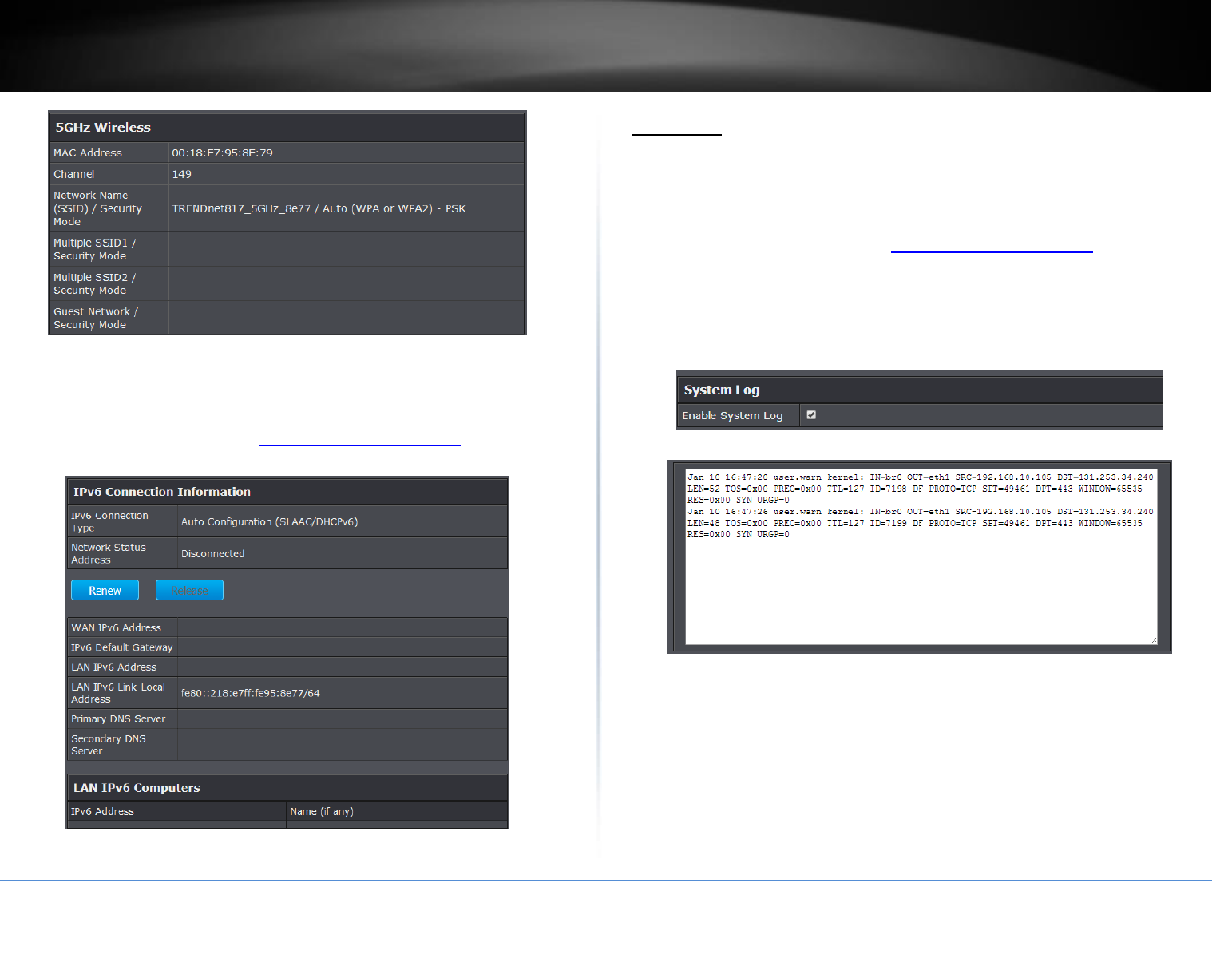
© Copyright 2015 TRENDnet. All Rights Reserved.
TRENDnet User’s Guide
TEW-817DTR
68
IPv6 Status
Advanced > Administrator > IPv6 Status
You can view the current IPv6 status on your router.
1. Log into the management page (see “Access your management page” on page 7).
2. Click on Advanced and click on Administrator, then click on IPv6 Status
View logs
Advanced > Administrator > System Log
Your router log can be used to obtain activity information on the functionality of your
router or for troubleshooting purposes.
1. Log into the management page (see “Access your management page” on page 7).
2. Click on Advanced and click on Administrator, then click on System Log.
3. Check the Enable System Log option to enable logging. Then click Apply. The logging
will display in the log window.
Note: Clicking Refresh will refresh the page to ensure display of the most recent logging
information. Click Clear will clear and delete all of the current logging information.
Log Window

© Copyright 2015 TRENDnet. All Rights Reserved.
TRENDnet User’s Guide
TEW-817DTR
69
Technical Specifications
Standards
IEEE 802.3
IEEE 802.3u
IEEE 802.11a
IEEE 802.11b
IEEE 802.11g
IEEE 802.11n (up to 300 Mbps)
IEEE 802.11ac (up to 433 Mbps)
Hardware Interface
1 x 10/100 Mbps port
Router/AP-WISP/off switch
WPS button
Reset button
LED indicators
Interchangeable power plugs: US, EU, UK
Modes
Router
Repeater
WISP*
Features
Compact form factor
IPv6
Dual band connectivity
Multiple SSID
Multicast to Unicast converter
WDS
VPN passthrough support
Access Control
Wireless encryption: up to WPA2
Firewall: NAT, ALG, Port Trigger, Virtual Server, Special Applications, DMZ Host,
PPTP/L2TP/IPsec VPN Passthrough
Wireless guest networks
Parental (Access) Controls: Website filter
Inbound filter
Quality of Service
Bandwidth control
WMM
Frequency
5 GHz: FCC: 5.180 – 5.240 + 5.745 – 5.825; ETSI: 5.180 – 5.725 GHz
2.4 GHz: FCC: 2.412 – 2.472; ETSI: 2.412 – 2.472 GHz
Modulation
802.11b: CCK, DQPSK, DBPSK
802.11a/g/n: BPSK, QPSK, 16 QAM, 64 QAM sub carrier with OFDM
802.11ac: BPSK, QPSK, 16 QAM, 64 QAM, 256 QAM with OFDM
Antenna Gain
5 GHz: 3 dBi (max.) internal
2.4 GHz: 2 dBi (max.) internal
Wireless Output Power/Receiving Sensitivity
802.11a: FCC: 20 dBm, CE: 18 dBm (max.)/-65 dBm (typical) @ 54 Mbps
802.11b: FCC: 20 dBm, CE: 16.5 dBm (max.)/-83 dBm (typical) @ 11 Mbps
802.11g: FCC: 20 dBm, CE: 16.5 dBm (max.)/-65 dBm (typical) @ 54 Mbps
802.11n (2.4 GHz): FCC: 17 dBm, CE: 13.5 dBm (max.)/-61 dBm (typical) @ 300
Mbps
802.11n (5 GHz): FCC: 18 dBm, CE: 18 dBm (max.)/-61 dBm (typical) @ 150
Mbps
802.11ac: FCC: 14 dBm, CE: 14 dBm (max.)/-51 dBm (typical) @ 433 Mbps

© Copyright 2015 TRENDnet. All Rights Reserved.
TRENDnet User’s Guide
TEW-817DTR
70
Wireless Channel
5 GHz: FCC: 36, 40, 44, 48, 149, 159, 157, 161, and 165; CE: 36, 40, 44, 48
2.4 GHz: FCC: 1 – 11; CE: 1 - 13
Power
Input: 100 – 240 V AC, 50 - 60 Hz, 0.5 A
Consumption: 3.2 Watts (max.)
Operating Temperature
0 – 40 °C (32 – 104 °F)
Operating Humidity
Max. 95% non-condensing
Certifications
CE
FCC
Dimensions
58 x 47 x 89 mm (2.3 x 1.9 x 3.5 in.)
Weight
114 g (4 oz.)
Warranty
3 year limited
Package Contents
TEW-817DTR
Quick Installation Guide
Network cable (1.5 m/5 ft.)
Interchangeable power plugs: US, EU, UK
*WISP mode is not compatible with captive portal wireless login pages
**Maximum wireless signal rates are referenced from IEEE 802.11 theoretical
specifications. Actual data throughput and coverage will vary depending on
interference, network traffic, building materials and other conditions.

© Copyright 2015 TRENDnet. All Rights Reserved.
TRENDnet User’s Guide
TEW-817DTR
71
Troubleshooting
Q: I typed http://tew-817dtr/ in my Internet Browser Address Bar, but an error
message says “The page cannot be displayed.” How can I access the router
management page?
Answer:
Access the router using the default IP address 192.168.10.1.
http://192.168.10.1
Q: I typed http://192.168.10.1 in my Internet Browser Address Bar, but an error
message says “The page cannot be displayed.” How can I access the router
management page?
Answer:
1. Check your hardware settings again. See “Router Installation” on page 8.
2. Make sure the LAN and WLAN lights are lit.
3. Make sure your network adapter TCP/IP settings are set to Obtain an IP address
automatically or DHCP (see the steps below).
4. Make sure your computer is connected to one of the router’s LAN ports
5. Press on the factory reset button for 15 seconds, the release.
Windows 7/8/8.1
a. Go into the Control Panel, click Network and Sharing Center.
b. Click Change Adapter Settings, right-click the Local Area Connection icon.
c. Then click Properties and click Internet Protocol Version 4 (TCP/IPv4).
d. Then click Obtain an IP address automatically and click OK.
Windows Vista
a. Go into the Control Panel, click Network and Internet.
b. Click Manage Network Connections, right-click the Local Area Connection
icon and click Properties.
c. Click Internet Protocol Version (TCP/IPv4) and then click Properties.
d. Then click Obtain an IP address automatically and click OK.
Windows XP/2000
a. Go into the Control Panel, double-click the Network Connections icon
b. Right-click the Local Area Connection icon and the click Properties.
c. Click Internet Protocol (TCP/IP) and click Properties.
d. Then click Obtain an IP address automatically and click OK.
Note: If you are experiencing difficulties, please contact your computer or operating
system manufacturer for assistance.
Q: I am not sure what type of Internet Account Type I have for my Cable/DSL
connection. How do I find out?
Answer:
Contact your Internet Service Provider (ISP) for the correct information.
Q: The Wizard does not appear when I access the router. What should I do?
Answer:
1. Click on Wizard on the left hand side.
2. Near the top of the browser, “Pop-up blocked” message may appear. Right click on
the message and select Always Allow Pop-ups from This Site.
3. Disable your browser's pop up blocker.
Q: I went through the Wizard, but I cannot get onto the Internet. What should I do?
Answer:
1. Verify that you can get onto the Internet with a direct connection into your modem
(meaning plug your computer directly to the modem and verify that your single
computer (without the help of the router) can access the Internet).
2. Power cycle your modem and router. Unplug the power to the modem and router.
Wait 30 seconds, and then reconnect the power to the modem. Wait for the modem to
fully boot up, and then reconnect the power to the router.
3. Contact your ISP and verify all the information that you have in regards to your
Internet connection settings is correct.
Q: I cannot connect wirelessly to the router. What should I do?
Answer:
1. Double check that the WLAN light on the router is lit.
2. Power cycle the router. Unplug the power to the router. Wait 15 seconds, then plug
the power back in to the router.
3. Contact the manufacturer of your wireless network adapter and make sure the
wireless network adapter is configured with the proper SSID. The preset SSID is
TRENDnet(model_number).
4. To verify whether or not wireless is enabled, login to the router management page,
click on Wireless.
5. Please see “Steps to improve wireless connectivity” on page 20 if you continue to
have wireless connectivity problems.

© Copyright 2015 TRENDnet. All Rights Reserved.
TRENDnet User’s Guide
TEW-817DTR
72
Appendix
How to find your IP address?
Note: Please note that although the following procedures provided to follow for your
operating system on configuring your network settings can be used as general
guidelines, however, it is strongly recommended that you consult your computer or
operating system manufacturer directly for assistance on the proper procedure for
configuring network settings.
Command Prompt Method
Windows 2000/XP/Vista/7/8/8.1
1. On your keyboard, press Windows Logo+R keys simultaneously to bring up the Run
dialog box.
2. In the dialog box, type cmd to bring up the command prompt.
3. In the command prompt, type ipconfig /all to display your IP address settings.
MAC OS X
1. Navigate to your Applications folder and open Utilities.
2. Double-click on Terminal to launch the command prompt.
3. In the command prompt, type ipconfig getifaddr <en0 or en1> to display the wired
or wireless IP address settings.
Note: en0 is typically the wired Ethernet and en1 is typically the wireless Airport
interface.
Graphical Method
MAC OS 10.6/10.5
1. From the Apple menu, select System Preferences.
2. In System Preferences, from the View menu, select Network.
3. In the Network preference window, click a network port (e.g., Ethernet, AirPort,
modem). If you are connected, you'll see your IP address settings under "Status:"
MAC OS 10.4
1. From the Apple menu, select Location, and then Network Preferences.
2. In the Network Preference window, next to "Show:", select Network Status. You'll see
your network status and your IP address settings displayed.
Note: If you are experiencing difficulties, please contact your computer or operating
system manufacturer for assistance.
How to configure your network settings to obtain an IP address automatically or use
DHCP?
Note: Please note that although the following procedures provided to follow for your
operating system on configuring your network settings can be used as general
guidelines, however, it is strongly recommended that you consult your computer or
operating system manufacturer directly for assistance on the proper procedure for
configuring network settings.
Windows 7/8/8.1
a. Go into the Control Panel, click Network and Sharing Center.
b. Click Change Adapter Settings, right-click the Local Area Connection icon.
c. Then click Properties and click Internet Protocol Version 4 (TCP/IPv4).
d. Then click Obtain an IP address automatically and click OK.
Windows Vista
a. Go into the Control Panel, click Network and Internet.
b. Click Manage Network Connections, right-click the Local Area Connection
icon and click Properties.
c. Click Internet Protocol Version (TCP/IPv4) and then click Properties.
d. Then click Obtain an IP address automatically and click OK.
Windows XP/2000
a. Go into the Control Panel, double-click the Network Connections icon
b. Right-click the Local Area Connection icon and the click Properties.
c. Click Internet Protocol (TCP/IP) and click Properties.
d. Then click Obtain an IP address automatically and click OK.
MAC OS 10.4/10.5/10.6
a. From the Apple, drop-down list, select System Preferences.
b. Click the Network icon.
c. From the Location drop-down list, select Automatic.
d. Select and view your Ethernet connection.
In MAC OS 10.4, from the Show drop-down list, select Built-in
Ethernet and select the TCP/IP tab.
In MAC OS 10.5/10.6, in the left column, select Ethernet.
e. Configure TCP/IP to use DHCP.

© Copyright 2015 TRENDnet. All Rights Reserved.
TRENDnet User’s Guide
TEW-817DTR
73
In MAC 10.4, from the Configure IPv4, drop-down list, select Using
DHCP and click the Apply Now button.
In MAC 10.5, from the Configure drop-down list, select Using DHCP
and click the Apply button.
In MAC 10.6, from the Configure drop-down list, select Using DHCP
and click the Apply button.
f. Restart your computer.
Note: If you are experiencing difficulties, please contact your computer or operating
system manufacturer for assistance.
How to find your MAC address?
In Windows 2000/XP/Vista/7,
Your computer MAC addresses are also displayed in this window, however, you can type
getmac –v to display the MAC addresses only.
In MAC OS 10.4,
1. Apple Menu > System Preferences > Network
2. From the Show menu, select Built-in Ethernet.
3. On the Ethernet tab, the Ethernet ID is your MAC Address.
In MAC OS 10.5/10.6,
1. Apple Menu > System Preferences > Network
2. Select Ethernet from the list on the left.
3. Click the Advanced button.
3. On the Ethernet tab, the Ethernet ID is your MAC Address.
How to connect to a wireless network using the built-in Windows utility?
Note: Please note that although the following procedures provided to follow for your
operating system on configuring your network settings can be used as general
guidelines, however, it is strongly recommended that you consult your computer or
operating system manufacturer directly for assistance on the proper procedure for
connecting to a wireless network using the built-in utility.
Windows 7/8/8.1
1. Open Connect to a Network by clicking the network icon ( or ) in the notification
area.
2. In the list of available wireless networks, click the wireless network you would like to
connect to, then click Connect.
4. You may be prompted to enter a security key in order to connect to the network.
5. Enter in the security key corresponding to the wireless network, and click OK.
Windows Vista
1. Open Connect to a Network by clicking the Start Button. and then click Connect
To.
2. In the Show list, click Wireless.
3. In the list of available wireless networks, click the wireless network you would like to
connect to, then click Connect.
4. You may be prompted to enter a security key in order to connect to the network.
5. Enter in the security key corresponding to the wireless network, and click OK.
Windows XP
1. Right-click the network icon in the notification area, then click View Available
Wireless Networks.
2. In Connect to a Network, under Available Networks, click the wireless network you
would like to connect to.
3. You may be prompted to enter a security key in order to connect to the network.
4. Enter in the security key corresponding to the wireless network, and click Connect.

© Copyright 2015 TRENDnet. All Rights Reserved.
TRENDnet User’s Guide
TEW-817DTR
74
Federal Communication Commission Interference Statement
This equipment has been tested and found to comply with the limits for a Class B digital device,
pursuant to Part 15 of the FCC Rules. These limits are designed to provide reasonable
protection against harmful interference in a residential installation. This equipment generates,
uses and can radiate radio frequency energy and, if not installed and used in accordance with
the instructions, may cause harmful interference to radio communications. However, there is
no guarantee that interference will not occur in a particular installation. If this equipment does
cause harmful interference to radio or television reception, which can be determined by
turning the equipment off and on, the user is encouraged to try to correct the interference by
one of the following measures:
Reorient or relocate the receiving antenna.
Increase the separation between the equipment and receiver.
Connect the equipment into an outlet on a circuit different from that to which the
receiver is connected.
Consult the dealer or an experienced radio/TV technician for help.
FCC Caution: Any changes or modifications not expressly approved by the party responsible
for compliance could void the user's authority to operate this equipment.
This device complies with Part 15 of the FCC Rules. Operation is subject to the following two
conditions: (1) This device may not cause harmful interference, and (2) this device must accept
any interference received, including interference that may cause undesired operation.
Operation of this device is restricted to indoor use only
IMPORTANT NOTE:
Radiation Exposure Statement:
This equipment complies with FCC radiation exposure limits set forth for an uncontrolled
environment. This equipment should be installed and operated with minimum distance
20cm between the radiator & your body.
This transmitter must not be co-located or operating in conjunction with any other antenna
or transmitter.
Country Code selection feature to be disabled for products marketed to the US/CANADA
Europe – EU Declaration of Conformity
TRENDnet hereby declare that the product is in compliance with the essential requirements
and other relevant provisions under our sole responsibility.
Safety
EN60950-1 : 2006 + A11 : 2009 + A1: 2010 + A12: 2013
EMC
EN 55022: 2010 + AC: 2011 Class B
EN 55024: 2010
EN 301 489-1 V1.9.2: 09-2011
EN 301 489-17 V2.2.1: 09-2012
Radio Spectrum & Health
EN 300 328 V1.8.1 : (2012-06)
EN 301 893 V1.7.1 : (2012-06)
EN 62311 : 2008
Energy Efficiency
Regulation (EC) No. 1275/2008, Regulation, No. 801/2013
This product is herewith confirmed to comply with the Directives.
Directives
Low Voltage Directive 2006/95/EC
EMC Directive 2004/108/EC
R&TTE Directive 1999/5/EC
EMF Directive 1999/519/EC
Ecodesign Directive 2009/125/EC
RoHS Directive 2011/65/EU
REACH Regulation (EC) No. 1907/2006
Operations in the 5.15-5.25GHz / 5.470 ~ 5.725GHz band are restricted to indoor usage only.
The band from 5600-5650MHz will be disabled by the software during the manufacturing
and cannot be changed by the end user. This device meets all the other requirements
specified in Part 15E, Section 15.407 of the FCC Rules.

© Copyright 2015 TRENDnet. All Rights Reserved.
TRENDnet User’s Guide
TEW-817DTR
75
Česky [Czech]
TRENDnet tímto prohlašuje, že tento TEW-817DTR je ve shodě se
základními požadavky a dalšími příslušnými ustanoveními
směrnice 1999/5/ES, 2006/95/ES, a 2009/125/ES.
Dansk [Danish]
Undertegnede TRENDnet erklærer herved, at følgende udstyr
TEW-817DTR overholder de væsentlige krav og øvrige relevante
krav i direktiv 1999/5/EF, 2006/95/EF, og 2009/125/EF.
Deutsch
[German]
Hiermit erklärt TRENDnet, dass sich das Gerät TEW-817DTR in
Übereinstimmung mit den grundlegenden Anforderungen und den
übrigen einschlägigen Bestimmungen der Richtlinie 1999/5/EG,
2006/95/EG und 2009/125/EG befindet.
Eesti [Estonian]
Käesolevaga kinnitab TRENDnet seadme TEW-817DTR vastavust
direktiivi 1999/5/EÜ, 2006/95/EÜ ja 2009/125/EÜ põhinõuetele ja
nimetatud direktiivist tulenevatele teistele asjakohastele sätetele.
English
Hereby, TRENDnet, declares that this TEW-817DTR is in
compliance with the essential requirements and other relevant
provisions of Directive 1999/5/EC, 2006/95/EC, and 2009/125/EC.
Español
[Spanish]
Por medio de la presente TRENDnet declara que el TEW-817DTR
cumple con los requisitos esenciales y cualesquiera otras
disposiciones aplicables o exigibles de la Directiva 1999/5/CE,
2006/95/CE, 2009/125/CE y.
Ελληνική
[Greek]
ΜΕ ΤΗΝ ΠΑΡΟΥΣΑTRENDnet ΔΗΛΩΝΕΙ ΟΤΙ TEW-817DTR
ΣΥΜΜΟΡΦΩΝΕΤΑΙ ΠΡΟΣ ΤΙΣ ΟΥΣΙΩΔΕΙΣ ΑΠΑΙΤΗΣΕΙΣ ΚΑΙ ΤΙΣ
ΛΟΙΠΕΣ ΣΧΕΤΙΚΕΣ ΔΙΑΤΑΞΕΙΣ ΤΗΣ ΟΔΗΓΙΑΣ 1999/5/ΕΚ, 2006/95/ΕΚ,
2009/125/ΕΚ και.
Français
[French]
Par la présente TRENDnet déclare que l'appareil TEW-817DTR est
conforme aux exigences essentielles et aux autres dispositions
pertinentes de la directive 1999/5/CE, 2006/95/CE, 2009/125/CE
et.
Italiano[Italian]
Con la presente TRENDnet dichiara che questo TEW-817DTR è
conforme ai requisiti essenziali ed alle altre disposizioni pertinenti
stabilite dalla direttiva 1999/5/CE, 2006/95/CE e 2009/125/CE.
Latviski
[Latvian]
AršoTRENDnetdeklarē, ka TEW-817DTR atbilstDirektīvas
1999/5/EK, 2006/95/EK, un 2009/125/EK būtiskajāmprasībām un
citiemar to saistītajiemnoteikumiem.
Lietuvių
[Lithuanian]
Šiuo TRENDnet deklaruoja, kad šis TEW-817DTR atitinka esminius
reikalavimus ir kitas 1999/5/EB, 2006/95/EB ir 2009/125/EB
Direktyvos nuostatas.
Nederlands
[Dutch]
Hierbij verklaart TRENDnet dat het toestel TEW-817DTR in
overeenstemming is met de essentiële eisen en de andere
relevante bepalingen van richtlijn 1999/5/EG, 2006/95/EG, en
2009/125/EG.
Malti [Maltese]
Hawnhekk, TRENDnet, jiddikjara li dan TEW-817DTR jikkonforma
mal-ħtiġijiet essenzjali u ma provvedimenti oħrajn relevanti li
hemm fid-Dirrettiva 1999/5/KE, 2006/95/KE, u 2009/125/KE.
Magyar
[Hungarian]
Alulírott, TRENDnet nyilatkozom, hogy a TEW-817DTR megfelel a
vonatkozó alapvetõ követelményeknek és az 1999/5/EK irányelv, a
2006/95/EK és a 2009/125/EK irányelv egyéb elõírásainak.
Polski [Polish]
Niniejszym TRENDnet oświadcza, że TEW-817DTR jest zgodny z
zasadniczymi wymogami oraz pozostałymi stosownymi
postanowieniami Dyrektywy 1999/5/WE, 2006/95/WE i
2009/125/WE.
Português
[Portuguese]
TRENDnet declara que este TEW-817DTR está conforme com os
requisitos essenciais e outras disposições da Directiva 1999/5/CE,
2006/95/CE e 2009/125/CE.
Slovensko
[Slovenian]
TRENDnet izjavlja, da je ta TEW-817DTR v skladu z bistvenimi
zahtevami in ostalimi relevantnimi določili direktive 1999/5/ES,
2006/95/ES in 2009/125/ES.
Slovensky
[Slovak]
TRENDnettýmtovyhlasuje, že TEW-817DTR
spĺňazákladnépožiadavky a všetkypríslušnéustanoveniaSmernice
1999/5/ES, 2006/95/ES, a 2009/125/ES.
Suomi [Finnish]
TRENDnet vakuuttaa täten että TEW-817DTR tyyppinen laite on
direktiivin 1999/5/EY, 2006/95/EY ja 2009/125/EY oleellisten
vaatimusten ja sitä koskevien direktiivin muiden ehtojen
mukainen.
Svenska
[Swedish]
Härmed intygar TRENDnet att denna TEW-817DTR står I
överensstämmelse med de väsentliga egenskapskrav och övriga
relevanta bestämmelser som framgår av direktiv 1999/5/EG,
2006/95/EG och 2009/125/EG.

© Copyright 2015 TRENDnet. All Rights Reserved.
TRENDnet User’s Guide
Limited Warranty
76
Limited Warranty
TRENDnet warrants its products against defects in material and workmanship, under
normal use and service, for the following lengths of time from the date of purchase.
TEW-817DTR – 3 Years Warranty
AC/DC Power Adapter, Cooling Fan, and Power Supply carry 1 year warranty.
If a product does not operate as warranted during the applicable warranty period,
TRENDnet shall reserve the right, at its expense, to repair or replace the defective
product or part and deliver an equivalent product or part to the customer. The
repair/replacement unit’s warranty continues from the original date of purchase. All
products that are replaced become the property of TRENDnet. Replacement products
may be new or reconditioned. TRENDnet does not issue refunds or credit. Please
contact the point-of-purchase for their return policies.
TRENDnet shall not be responsible for any software, firmware, information, or memory
data of customer contained in, stored on, or integrated with any products returned to
TRENDnet pursuant to any warranty.
There are no user serviceable parts inside the product. Do not remove or attempt to
service the product by any unauthorized service center. This warranty is voided if (i) the
product has been modified or repaired by any unauthorized service center, (ii) the
product was subject to accident, abuse, or improper use (iii) the product was subject to
conditions more severe than those specified in the manual.
Warranty service may be obtained by contacting TRENDnet within the applicable
warranty period and providing a copy of the dated proof of the purchase. Upon proper
submission of required documentation a Return Material Authorization (RMA) number
will be issued. An RMA number is required in order to initiate warranty service support
for all TRENDnet products. Products that are sent to TRENDnet for RMA service must
have the RMA number marked on the outside of return packages and sent to TRENDnet
prepaid, insured and packaged appropriately for safe shipment. Customers shipping
from outside of the USA and Canada are responsible for return shipping fees. Customers
shipping from outside of the USA are responsible for custom charges, including but not
limited to, duty, tax, and other fees.
WARRANTIES EXCLUSIVE: IF THE TRENDNET PRODUCT DOES NOT OPERATE AS
WARRANTED ABOVE, THE CUSTOMER’S SOLE REMEDY SHALL BE, AT TRENDNET’S
OPTION, REPAIR OR REPLACE. THE FOREGOING WARRANTIES AND REMEDIES ARE
EXCLUSIVE AND ARE IN LIEU OF ALL OTHER WARRANTIES, EXPRESSED OR IMPLIED,
EITHER IN FACT OR BY OPERATION OF LAW, STATUTORY OR OTHERWISE, INCLUDING
WARRANTIES OF MERCHANTABILITY AND FITNESS FOR A PARTICULAR PURPOSE.
TRENDNET NEITHER ASSUMES NOR AUTHORIZES ANY OTHER PERSON TO ASSUME FOR
IT ANY OTHER LIABILITY IN CONNECTION WITH THE SALE, INSTALLATION MAINTENANCE
OR USE OF TRENDNET’S PRODUCTS.
TRENDNET SHALL NOT BE LIABLE UNDER THIS WARRANTY IF ITS TESTING AND
EXAMINATION DISCLOSE THAT THE ALLEGED DEFECT IN THE PRODUCT DOES NOT EXIST
OR WAS CAUSED BY CUSTOMER’S OR ANY THIRD PERSON’S MISUSE, NEGLECT,
IMPROPER INSTALLATION OR TESTING, UNAUTHORIZED ATTEMPTS TO REPAIR OR
MODIFY, OR ANY OTHER CAUSE BEYOND THE RANGE OF THE INTENDED USE, OR BY
ACCIDENT, FIRE, LIGHTNING, OR OTHER HAZARD.
LIMITATION OF LIABILITY: TO THE FULL EXTENT ALLOWED BY LAW TRENDNET ALSO
EXCLUDES FOR ITSELF AND ITS SUPPLIERS ANY LIABILITY, WHETHER BASED IN
CONTRACT OR TORT (INCLUDING NEGLIGENCE), FOR INCIDENTAL, CONSEQUENTIAL,
INDIRECT, SPECIAL, OR PUNITIVE DAMAGES OF ANY KIND, OR FOR LOSS OF REVENUE OR
PROFITS, LOSS OF BUSINESS, LOSS OF INFORMATION OR DATE, OR OTHER FINANCIAL
LOSS ARISING OUT OF OR IN CONNECTION WITH THE SALE, INSTALLATION,
MAINTENANCE, USE, PERFORMANCE, FAILURE, OR INTERRUPTION OF THE POSSIBILITY
OF SUCH DAMAGES, AND LIMITS ITS LIABILITY TO REPAIR, REPLACEMENT, OR REFUND
OF THE PURCHASE PRICE PAID, AT TRENDNET’S OPTION. THIS DISCLAIMER OF LIABILITY
FOR DAMAGES WILL NOT BE AFFECTED IF ANY REMEDY PROVIDED HEREIN SHALL FAIL
OF ITS ESSENTIAL PURPOSE.
Governing Law: This Limited Warranty shall be governed by the laws of the state of
California.
Some TRENDnet products include software code written by third party developers.
These codes are subject to the GNU General Public License ("GPL") or GNU Lesser
General Public License ("LGPL").
Go to http://www.trendnet.com/gpl or http://www.trendnet.com Download section
and look for the desired TRENDnet product to access to the GPL Code or LGPL Code.
These codes are distributed WITHOUT WARRANTY and are subject to the copyrights of
the developers. TRENDnet does not provide technical support for these codes. Please go
to http://www.gnu.org/licenses/gpl.txt or http://www.gnu.org/licenses/lgpl.txt for
specific terms of each license.
PWP05202009v2 2015/03/05
